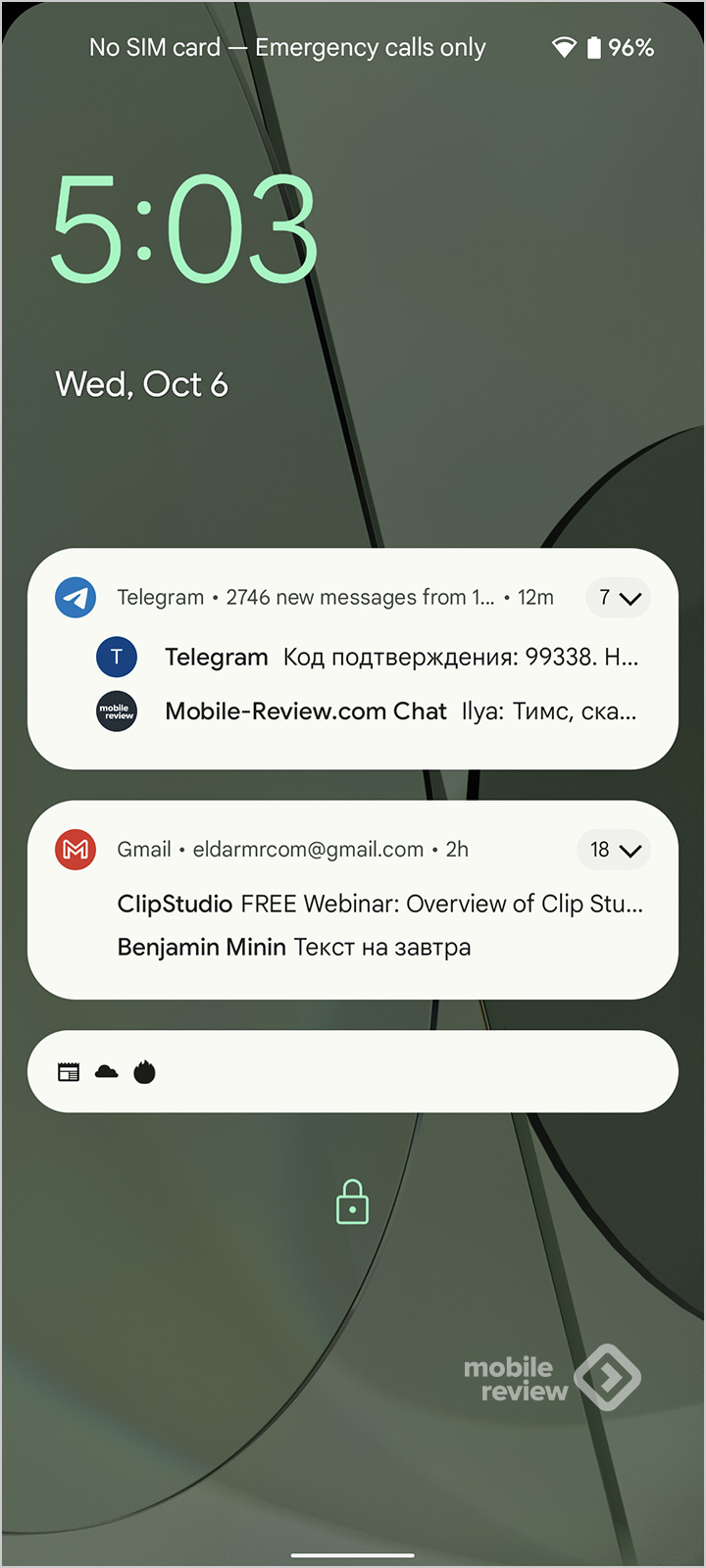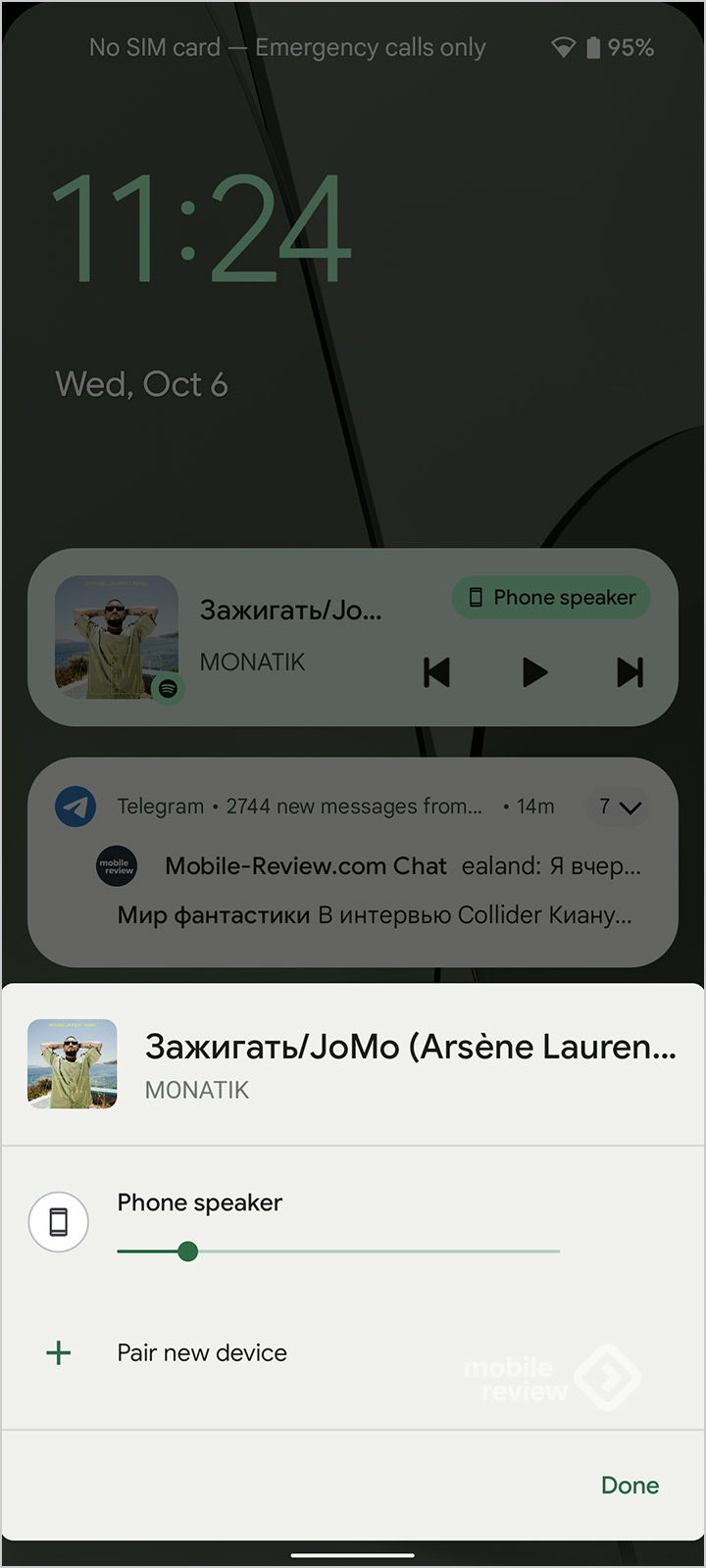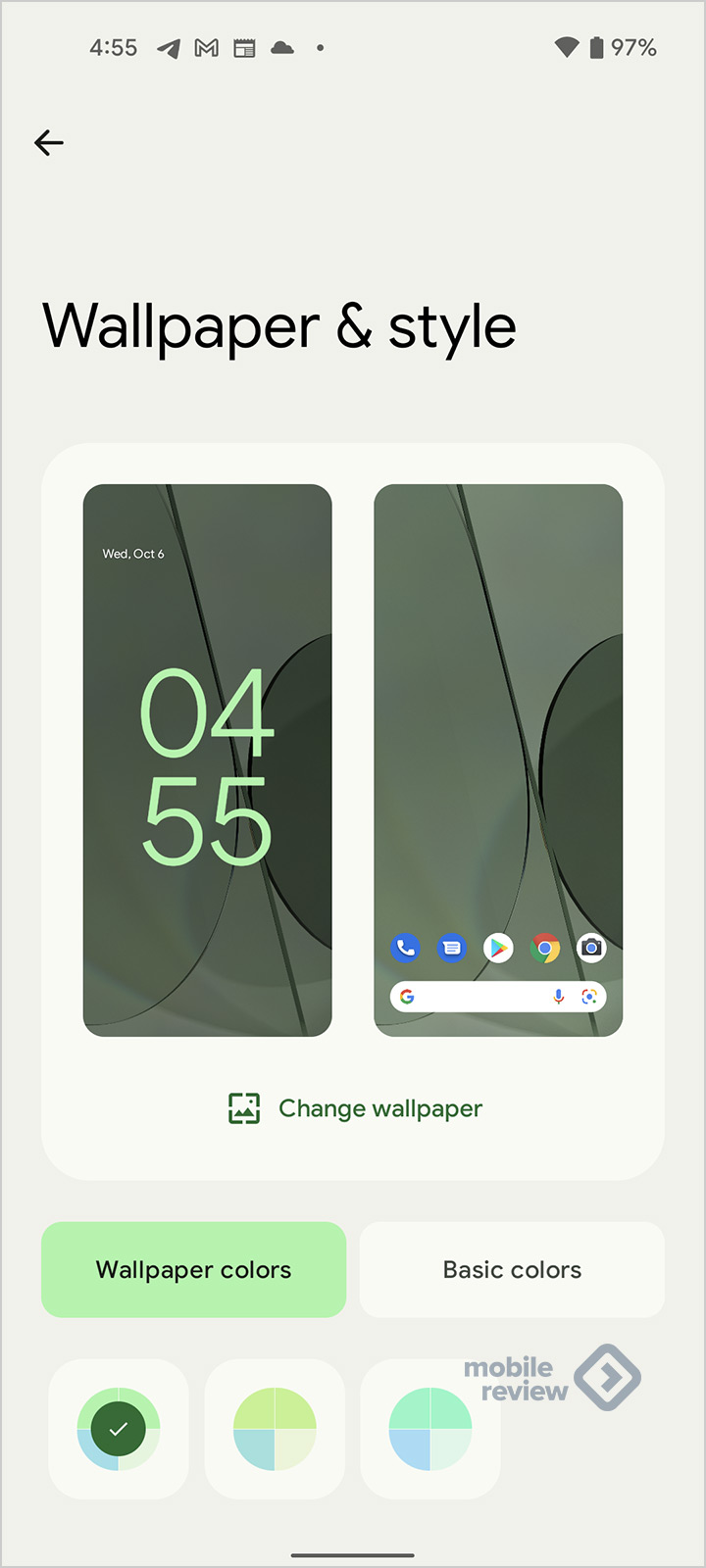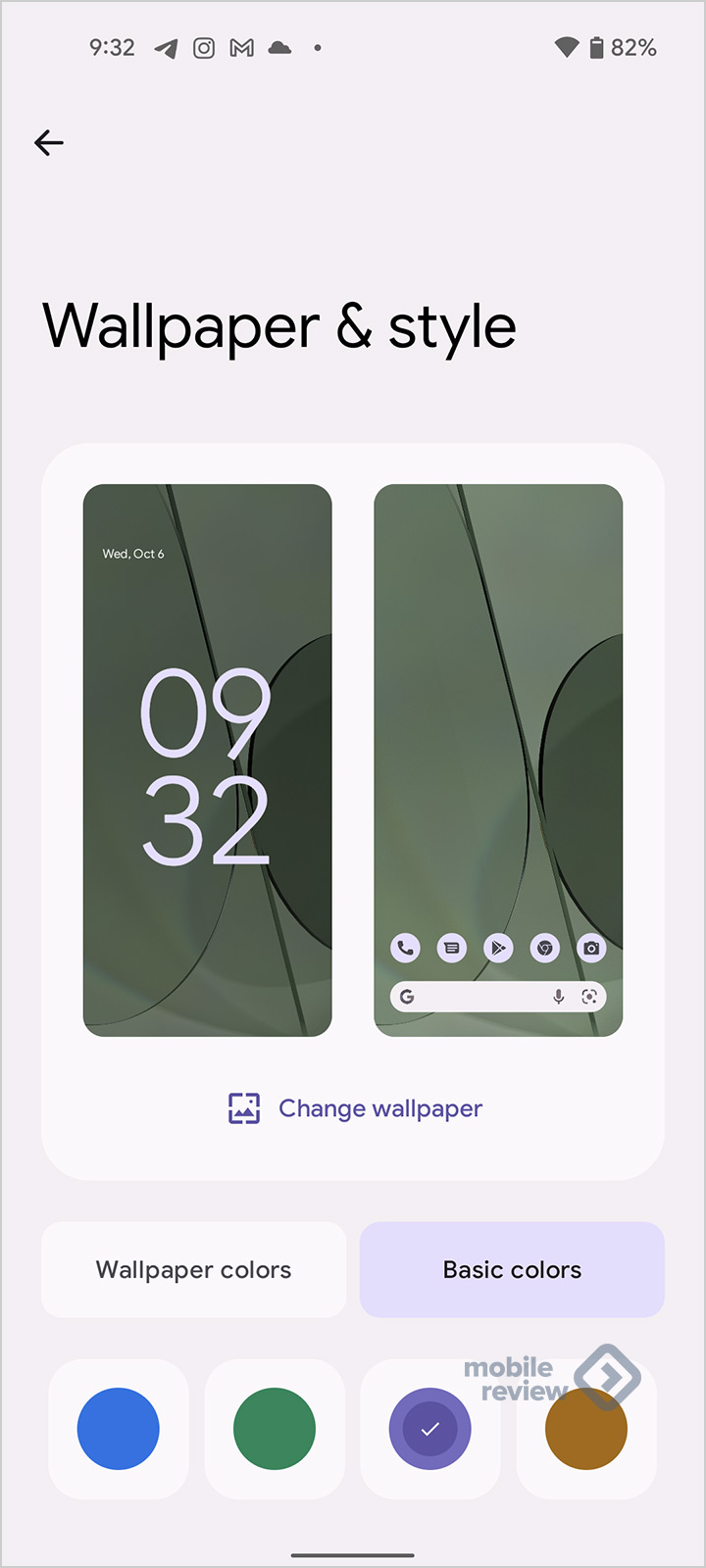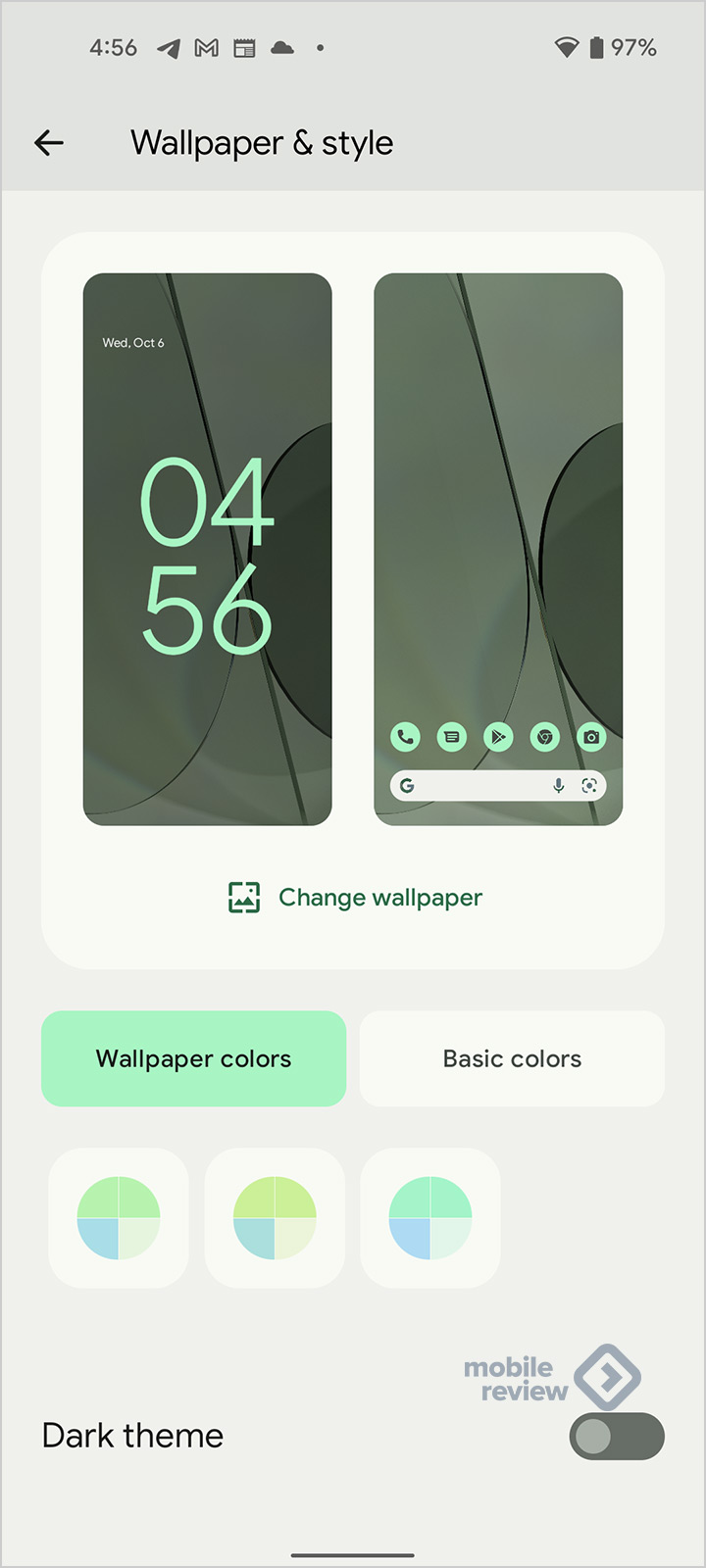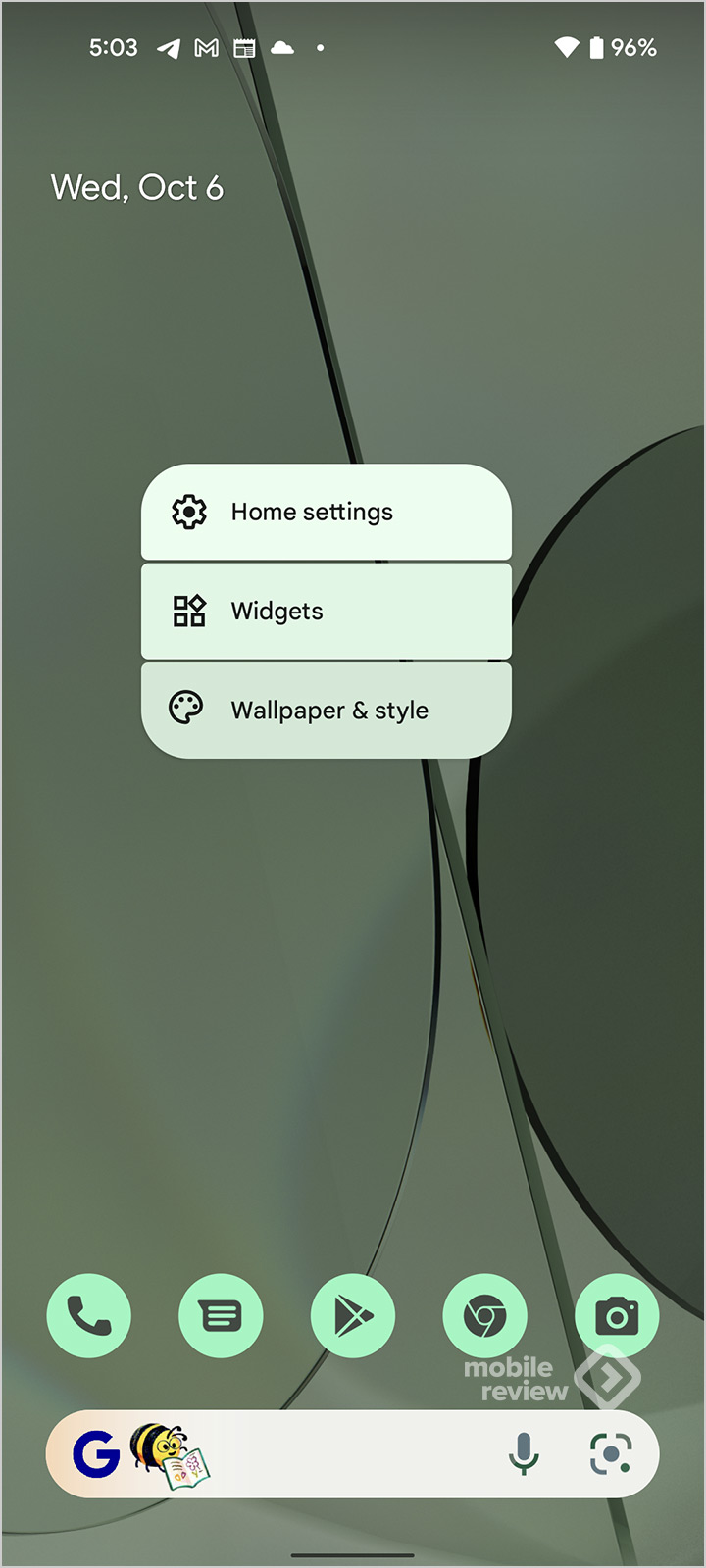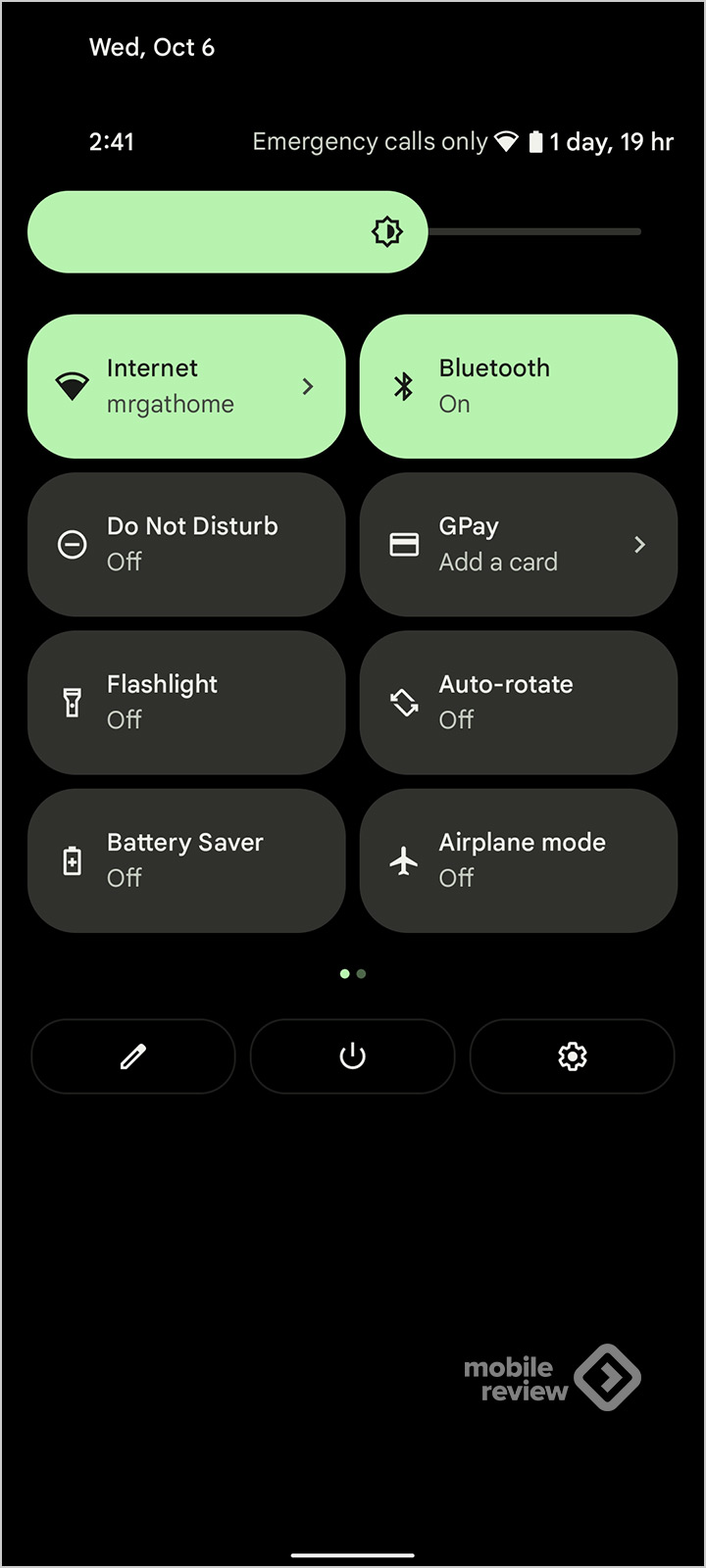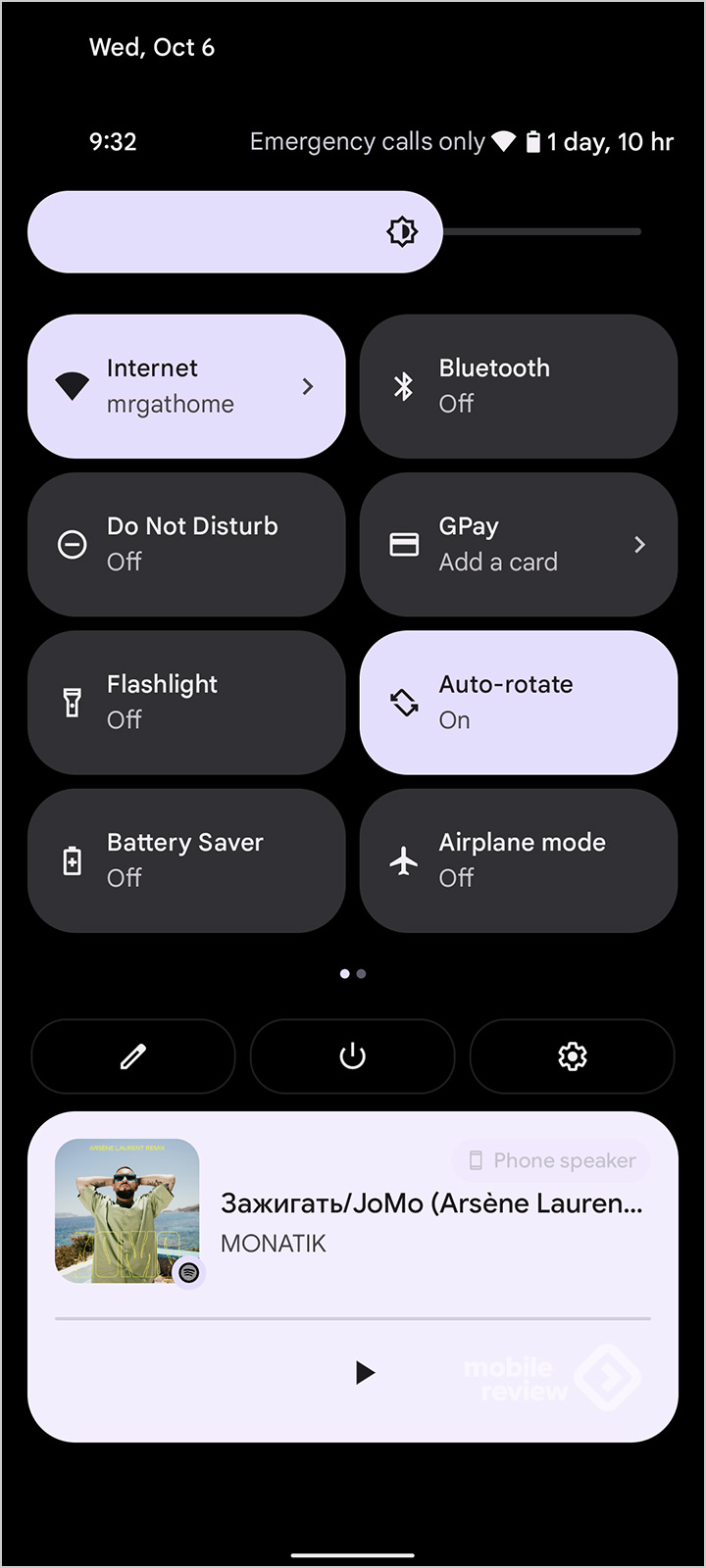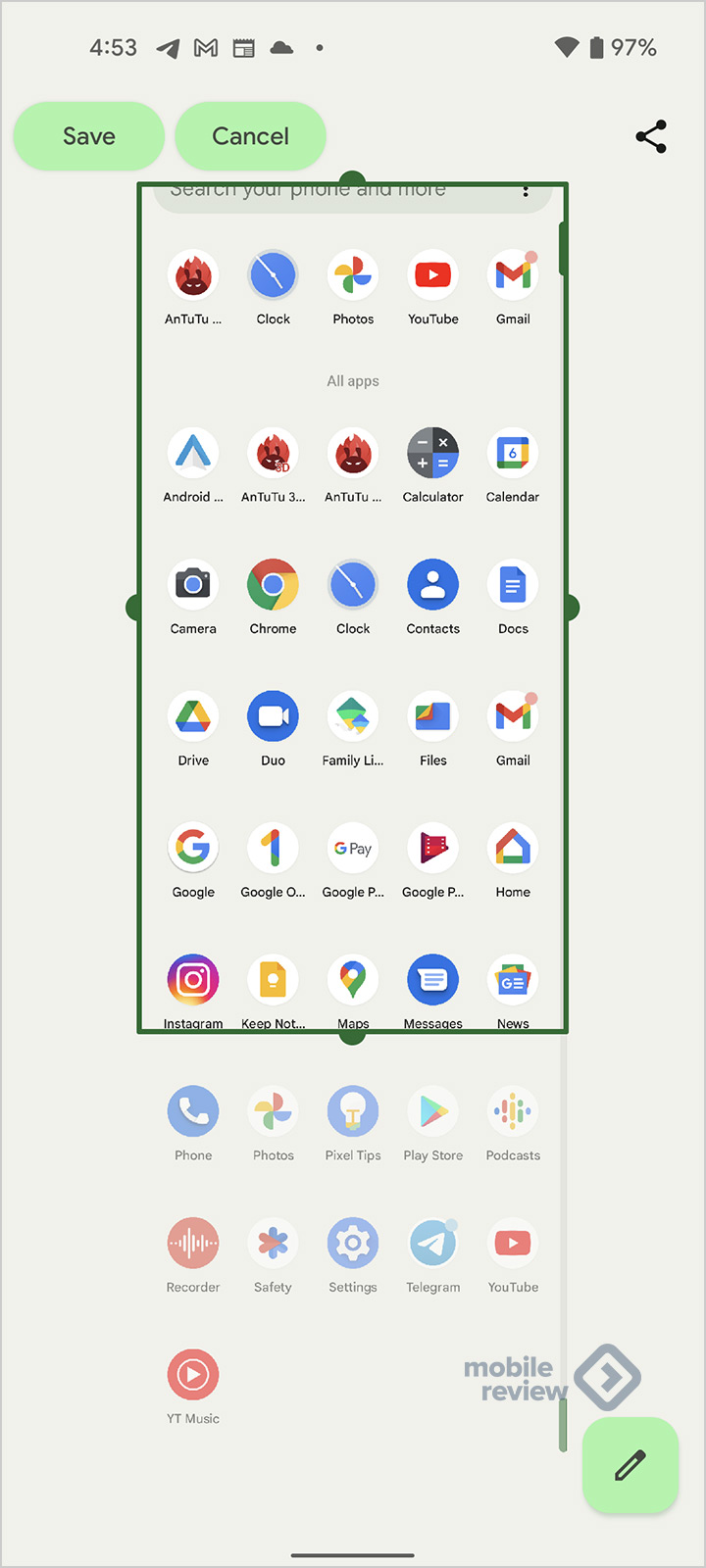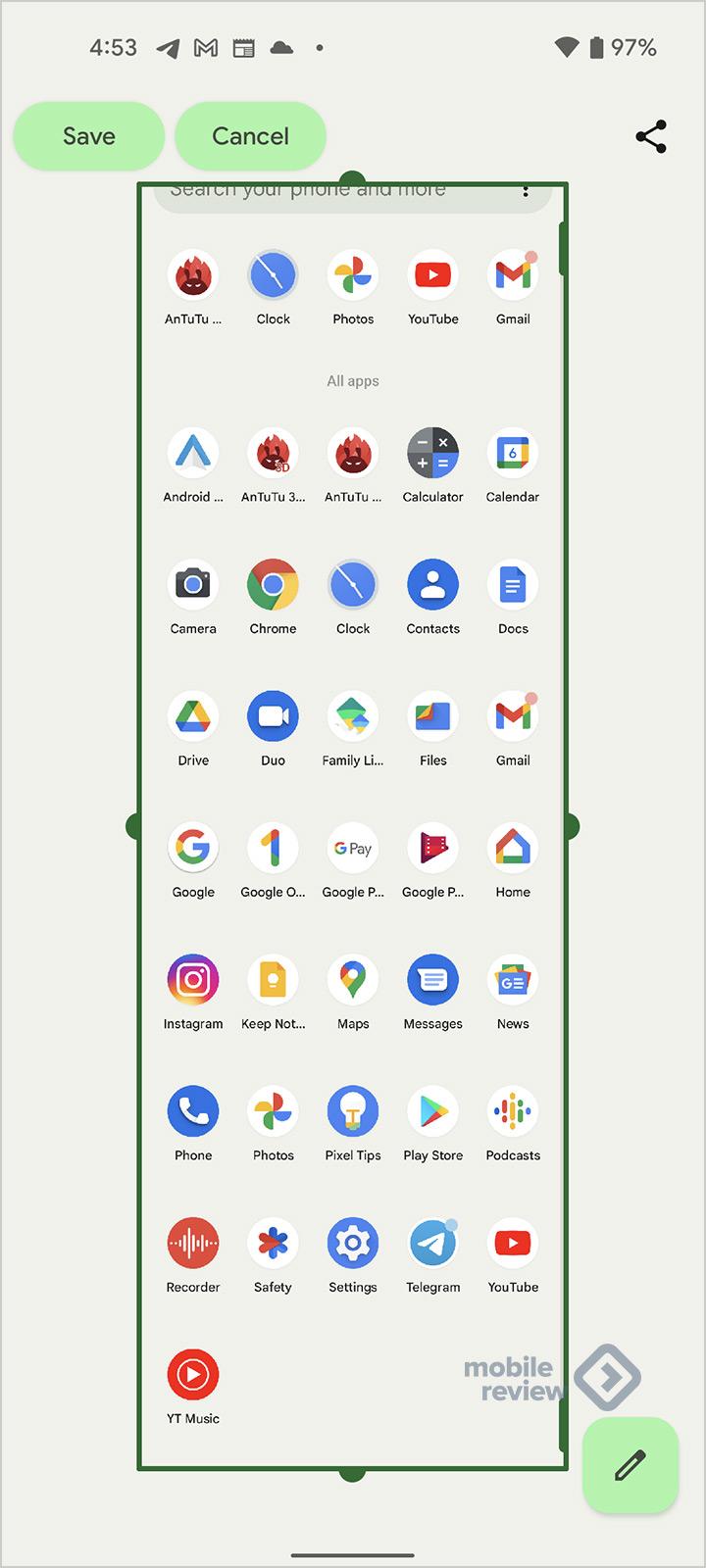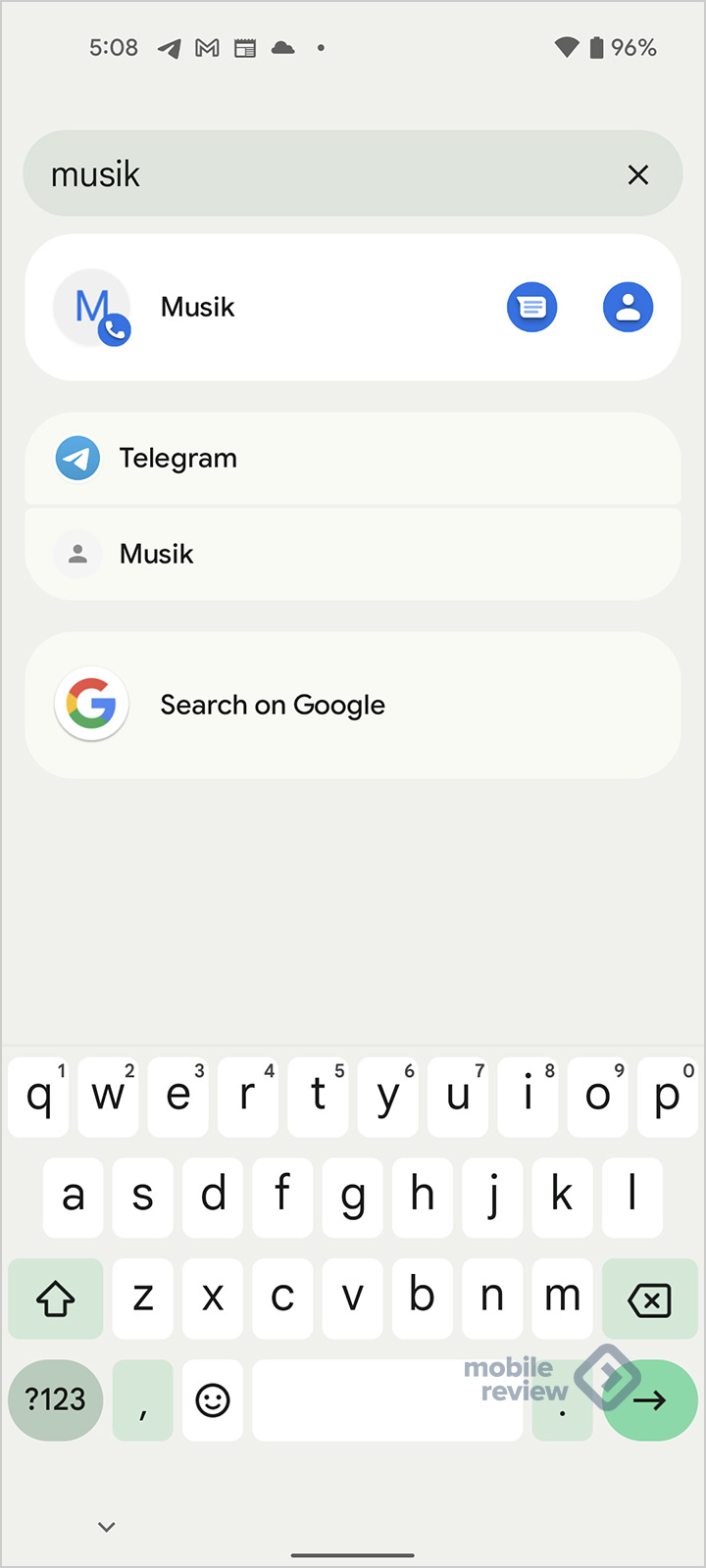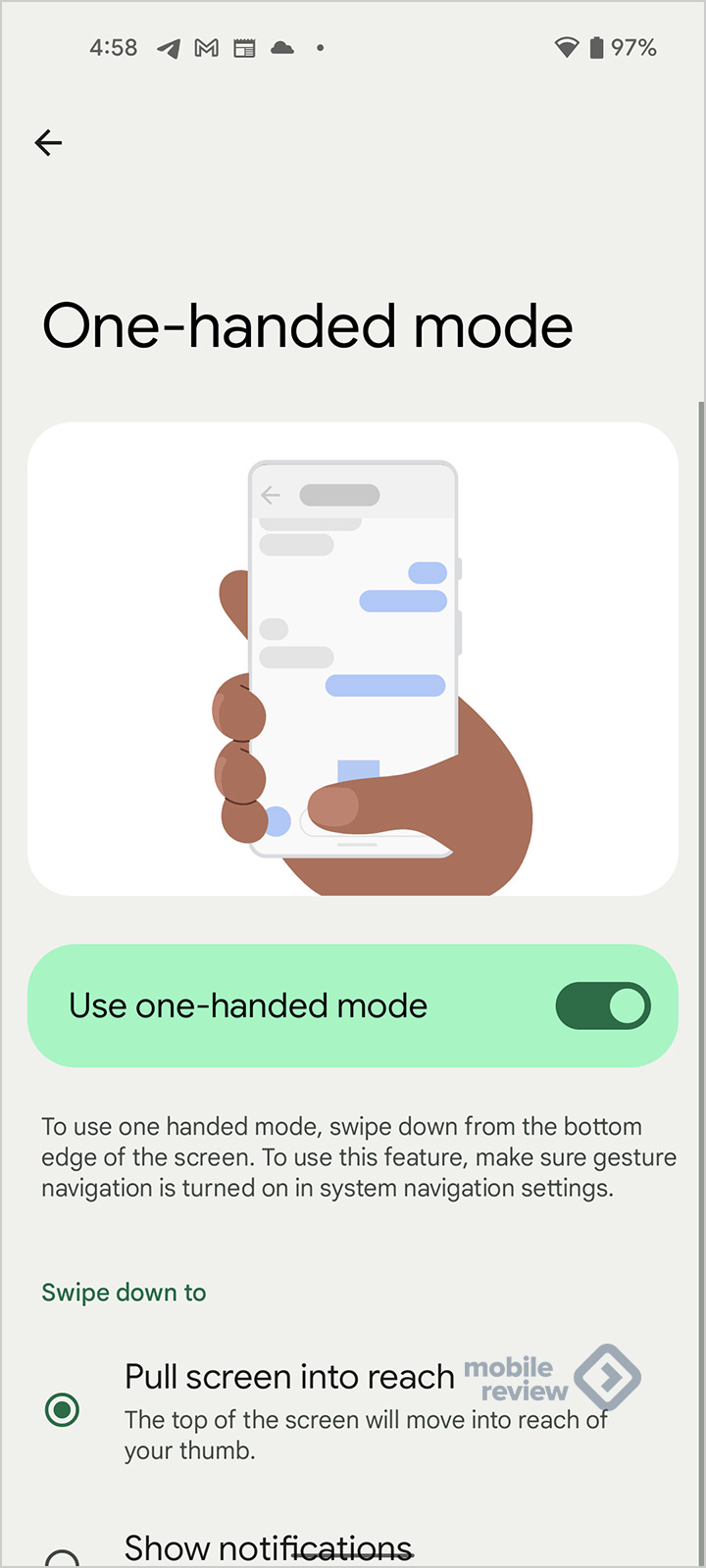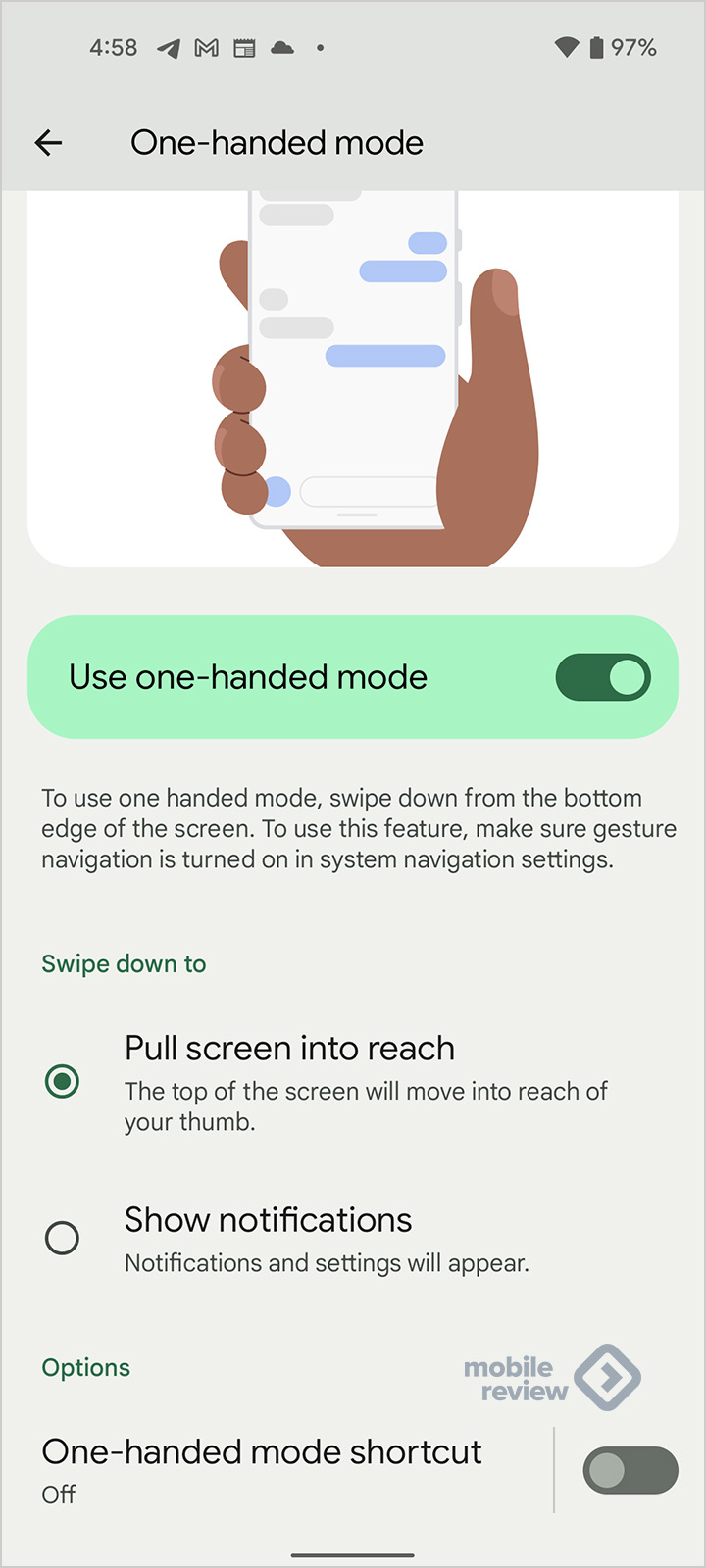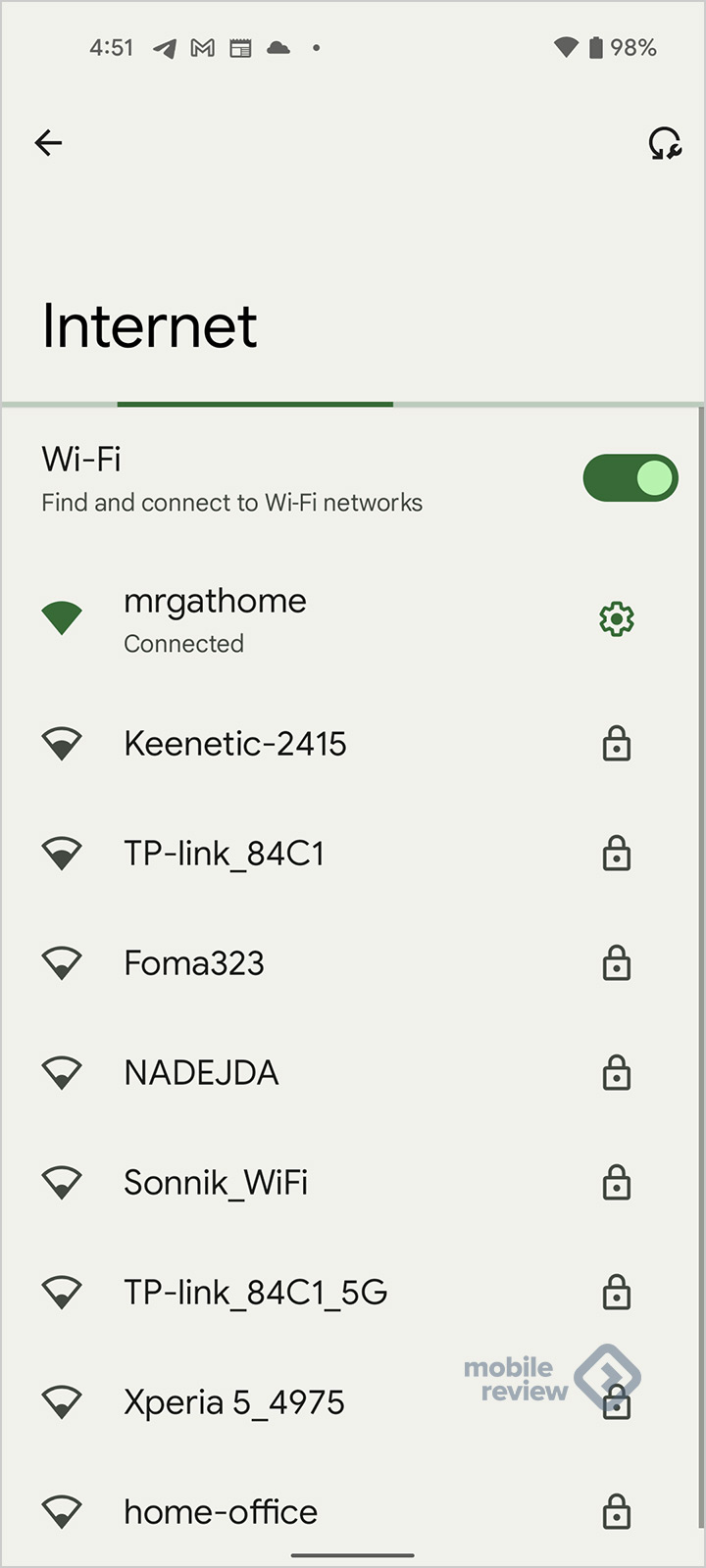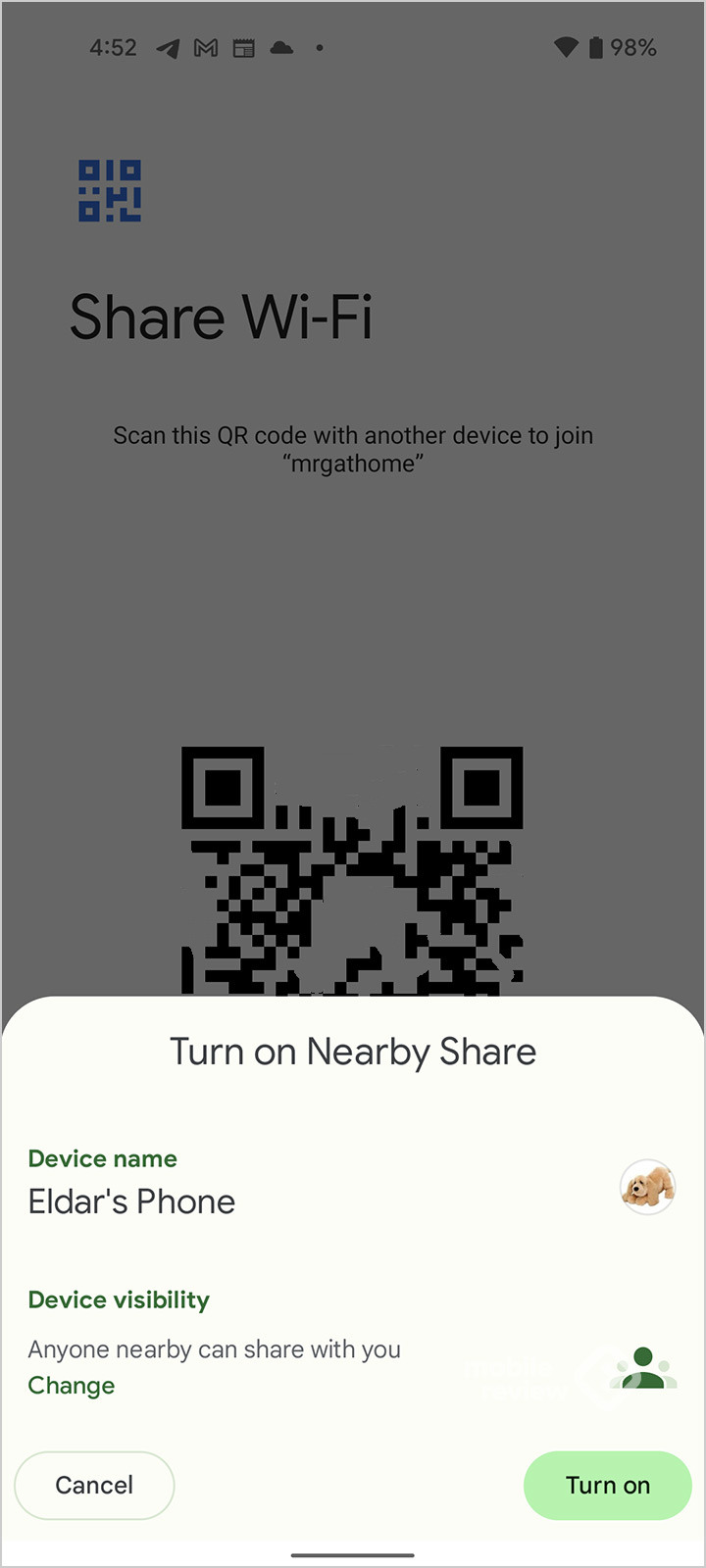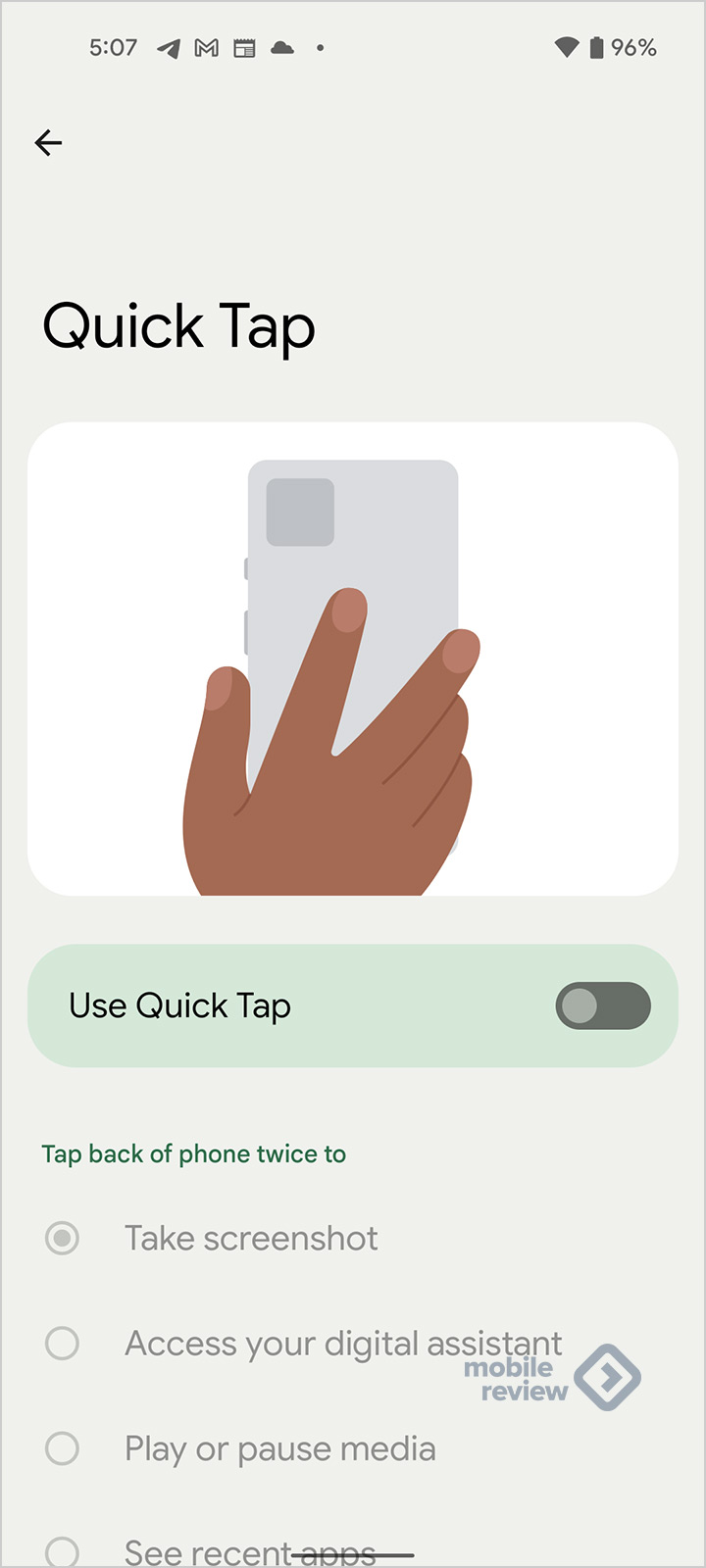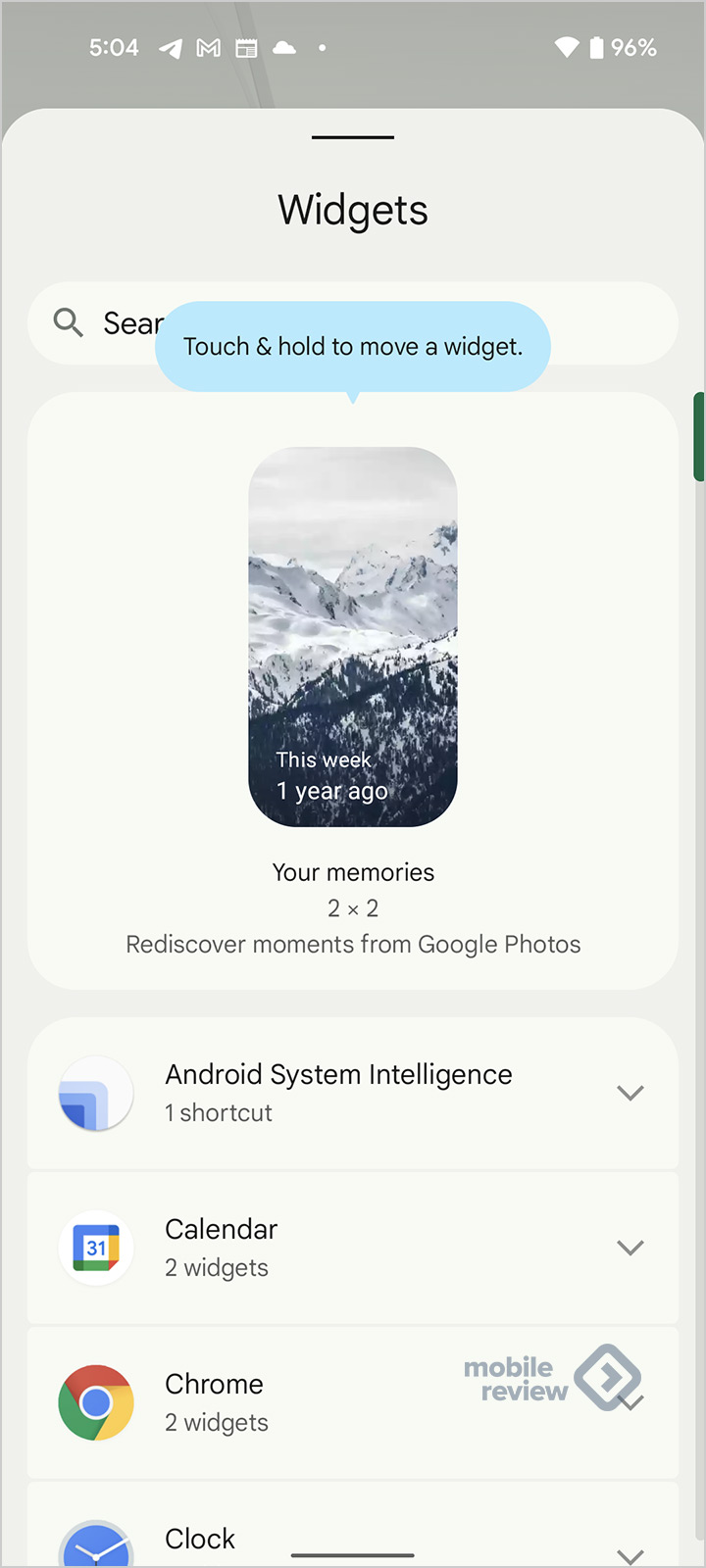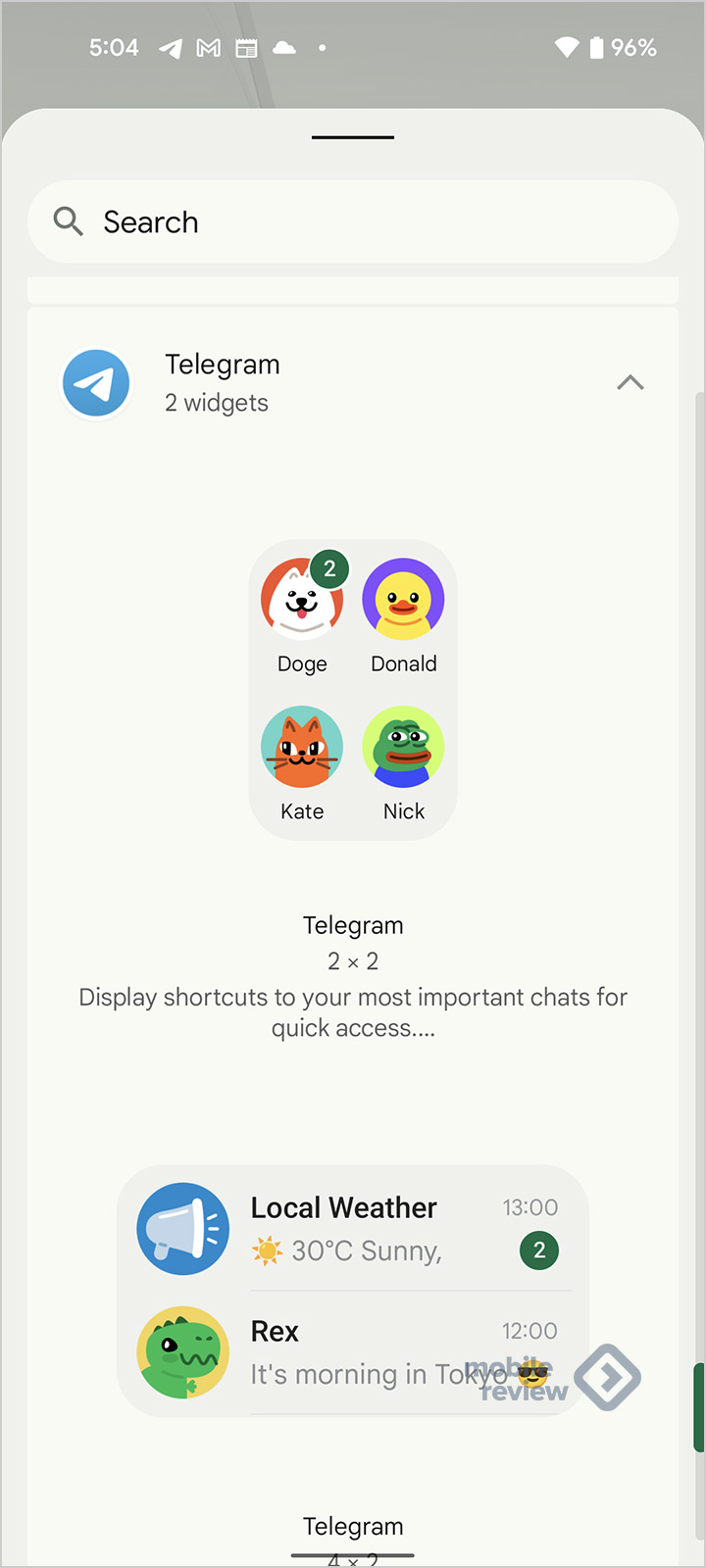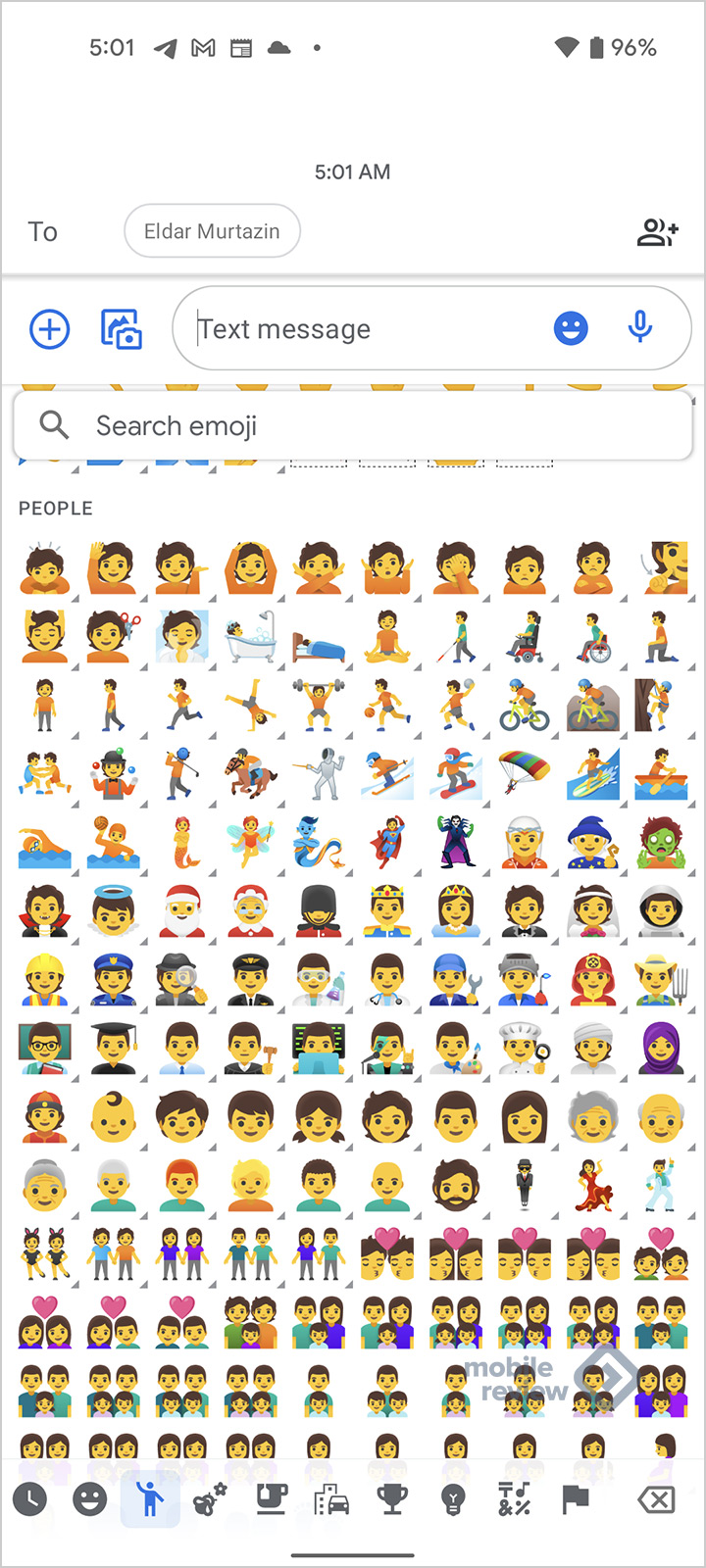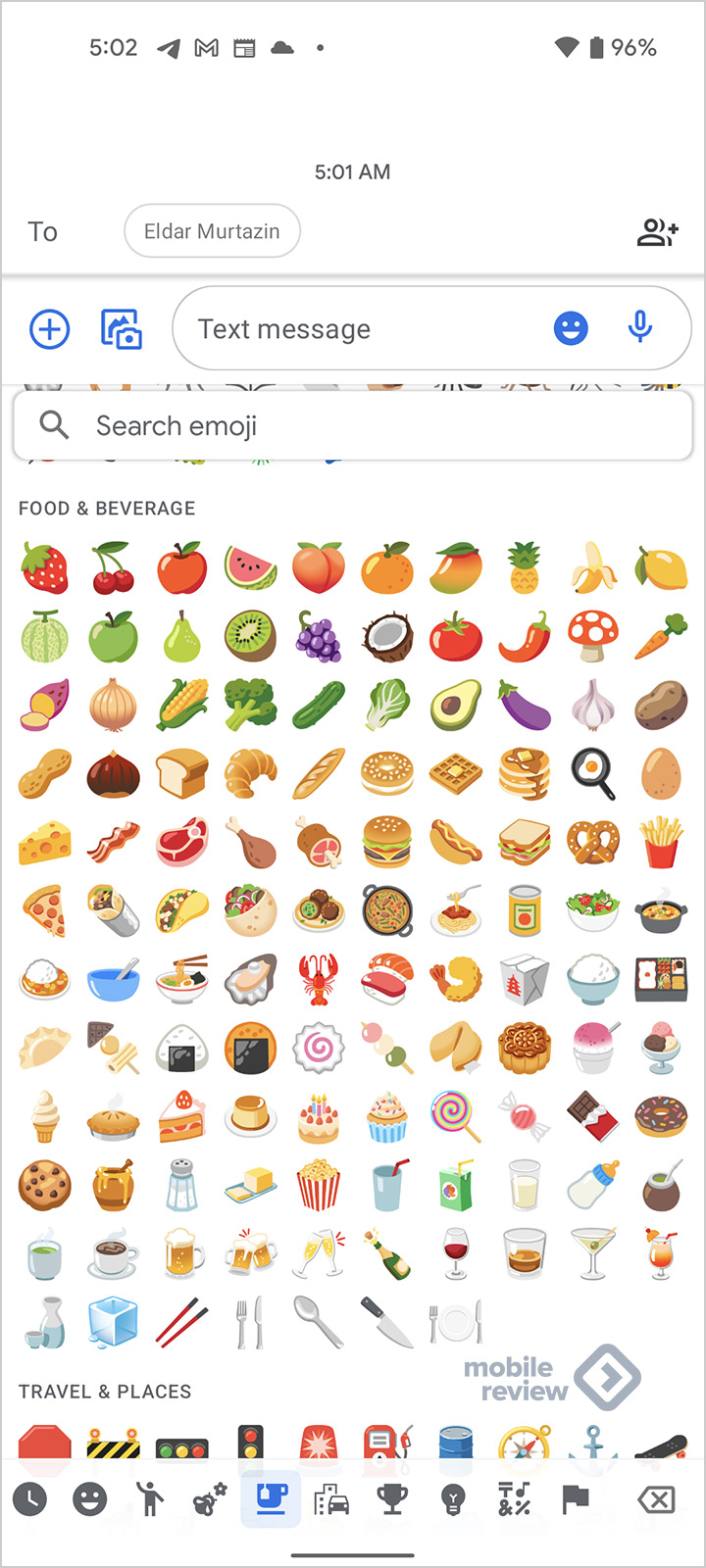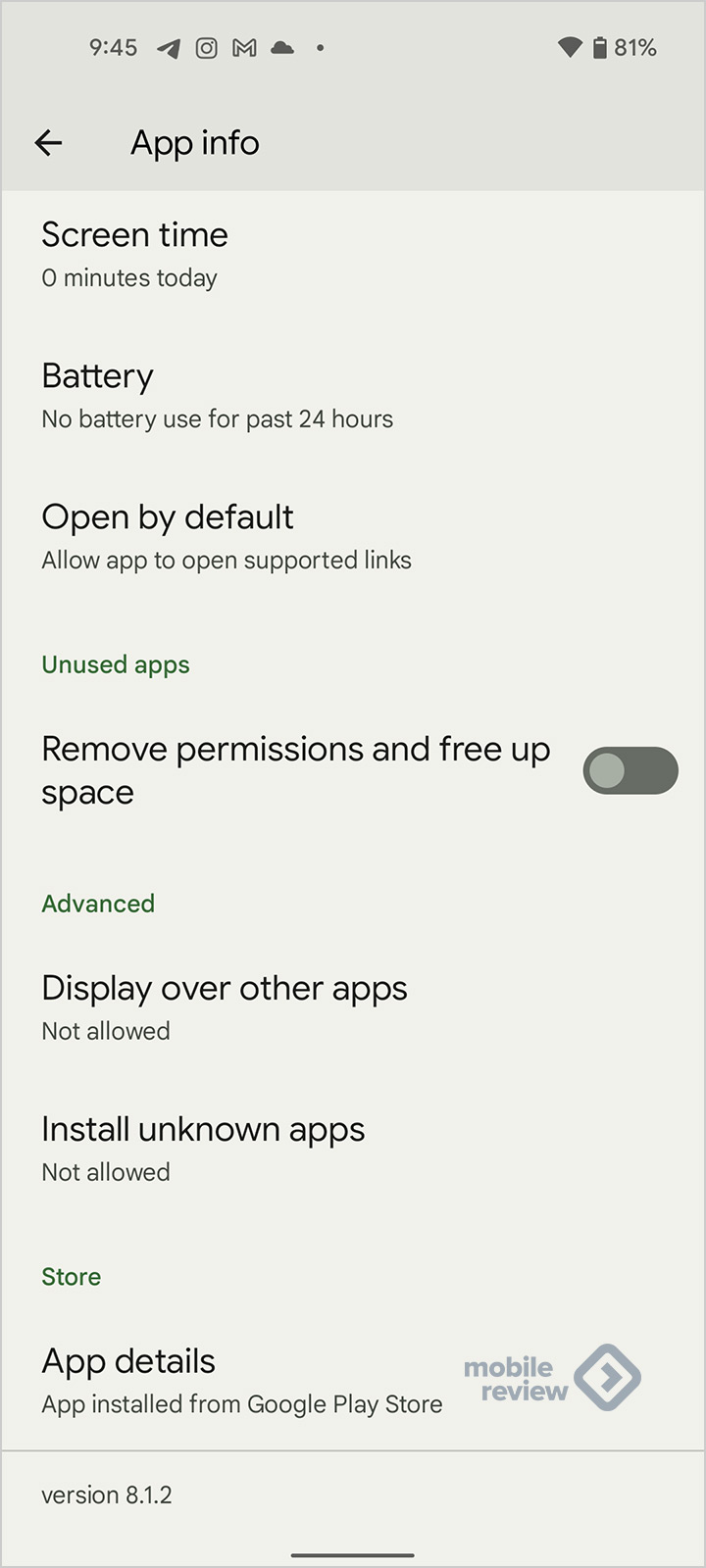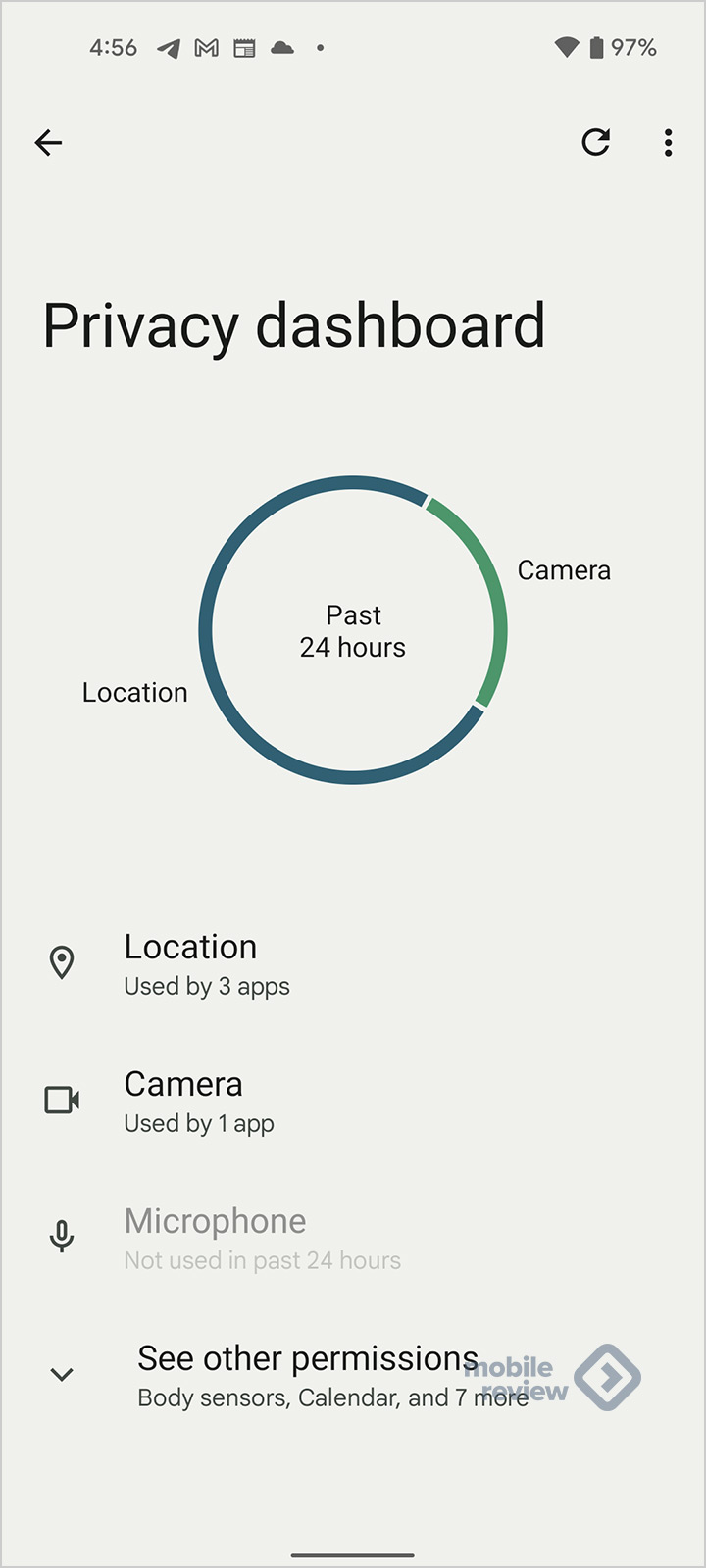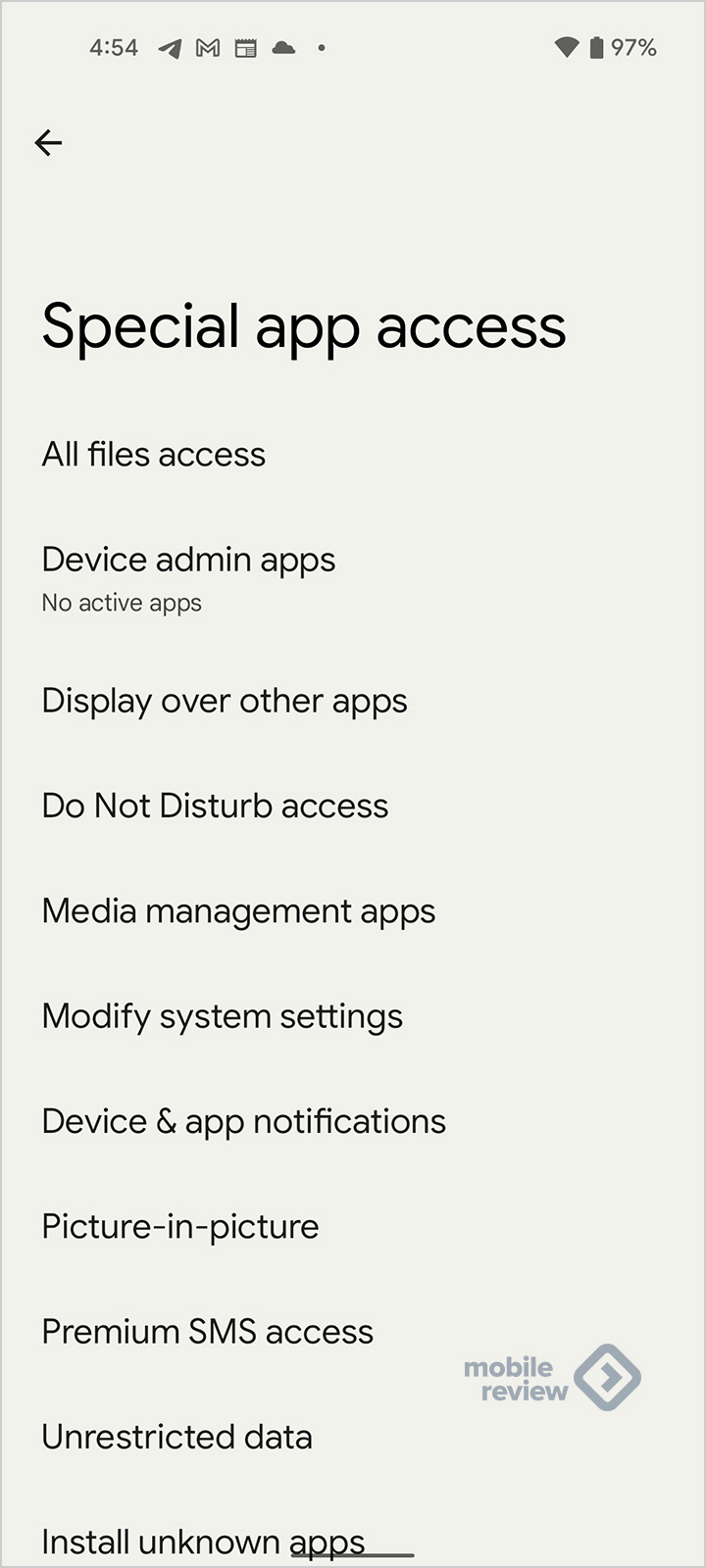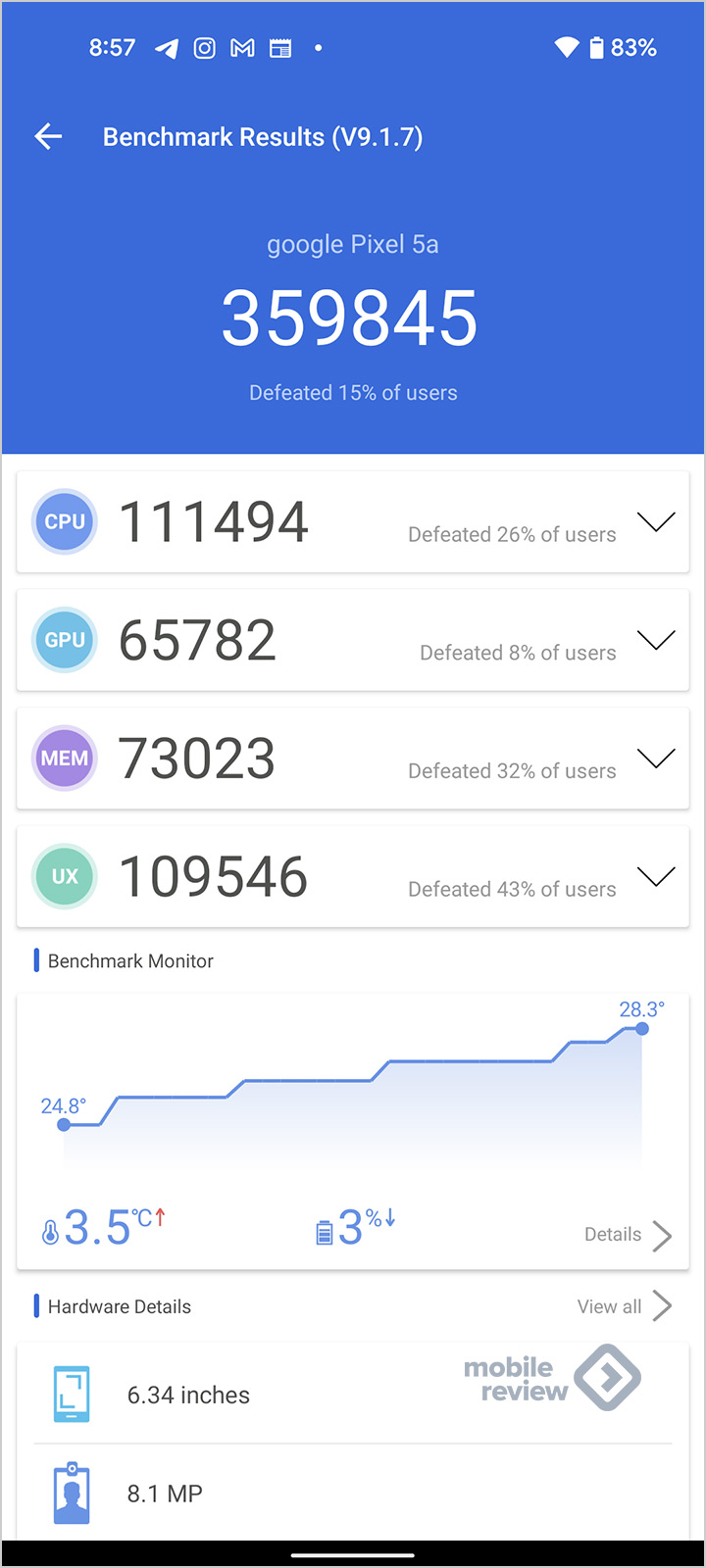15 августа компания Google внезапно объявила о выпуске первой стабильной версии Android 13. До этого дня пользователям были доступны лишь бета-версии операционной системы. Сейчас же все маски сняты и можно смело говорить о полноценном запуске мобильной ОС. Google успела перевыполнить план и устранить неполадки раньше положенного срока, учитывая, что Андроид 12 увидела свет лишь в октябре 2021 года, а датой выхода Андроид 13 предварительно называлось 1 сентября.
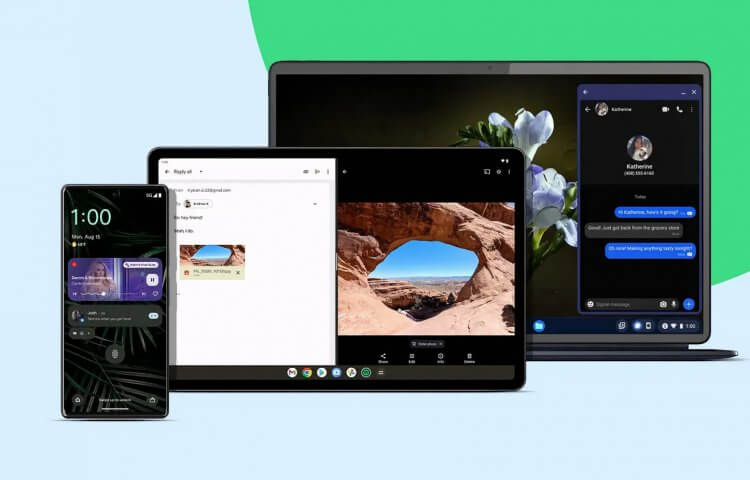
Android 13 предлагает новые функции персонализации, улучшение безопасности и опыта взаимодействия с экосистемными устройствами
Релиз нового Андроида знаменует собой появление новых фишек, которые ранее были недоступны в версиях для бета-тестировщиков или поставлялись в урезанном формате. Оценить Android 13 во всей красе можно уже сегодня, но, разумеется, не всем. Google традиционно поощряет вниманием обладателей своих смартфонов Pixel, вызывая зависть со стороны владельцев устройств других производителей.
❗️ ЕЩЕ БОЛЬШЕ НОВОСТЕЙ В НАШЕМ КАНАЛЕ НА ЯНДЕКС.ДЗЕН
Что нового в Android 13
При разработке тринадцатого поколения мобильной ОС упор был сделан на персонализацию. Android 13 продолжает эксплуатировать дизайн Material You и адаптирует внешний вид сторонних приложений в соответствии с темой и обоями смартфона. Таким образом, все программное обеспечение устройства сливается в единое целое, и ни одна утилита не выбивается из общего ряда.
![]()
Наконец-то иконки выполнены в едином стиле
Если вы являетесь носителем нескольких языков, то вас порадует наличие функции, позволяющей выбрать язык интерфейса для каждого отдельно взятого приложения. Ранее программное обеспечение работало только на языке системы.
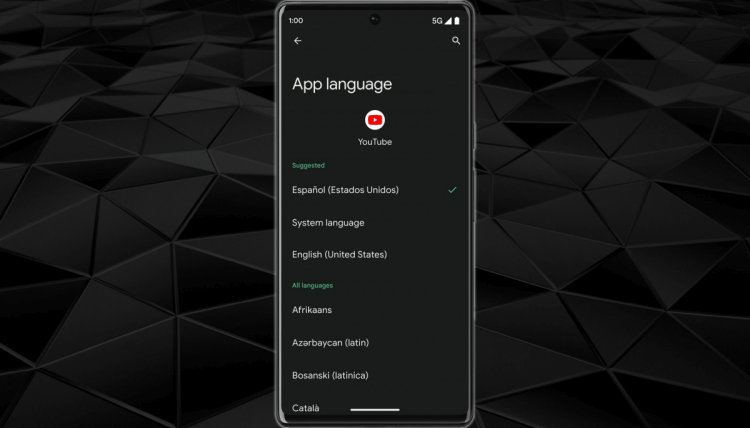
Изменить язык можно в каждом отдельно взятом приложении
Google серьезно переработала дизайн встроенного медиаплеера. Как и другие элементы интерфейса, он готов похвастать адаптивным оформлением, которое подстраивается под обложку альбома. Причем такая фишка актуальна даже при воспроизведении контента через Chrome. Наконец, в Android 13 появились дополнительные настройки темной темы, позволяющие в том числе затемнить обои. Теперь вы сможете быстрее отойти ко сну.

Теперь медиаплеер подстраивается под обложку альбома
Как и всегда, большое внимание в Android 13 было уделено безопасности и конфиденциальности. Так, в новой версии ОС компании Google приложению можно разрешить доступ только к одной фотографии, а не ко всей медиатеке целиком. Еще более важной выглядит функция автоматической очистки буфера обмена, если пользователь копирует конфиденциальную информацию вроде адреса электронной почты или номера телефона.
❗️ ПОСМОТРИ, КАКАЯ ГОДНОТА В НАШЕМ ТЕЛЕГРАМ-КАНАЛЕ СУНДУК АЛИБАБЫ
Последнее интересное изменение, касающееся конфиденциальности, — выдача разрешений на отправку уведомлений. В Android 13 оповещения не включаются автоматически, а пользователь сам при первом запуске ПО выбирает, стоит ли той или иной утилите тревожить хозяина своими пушами.
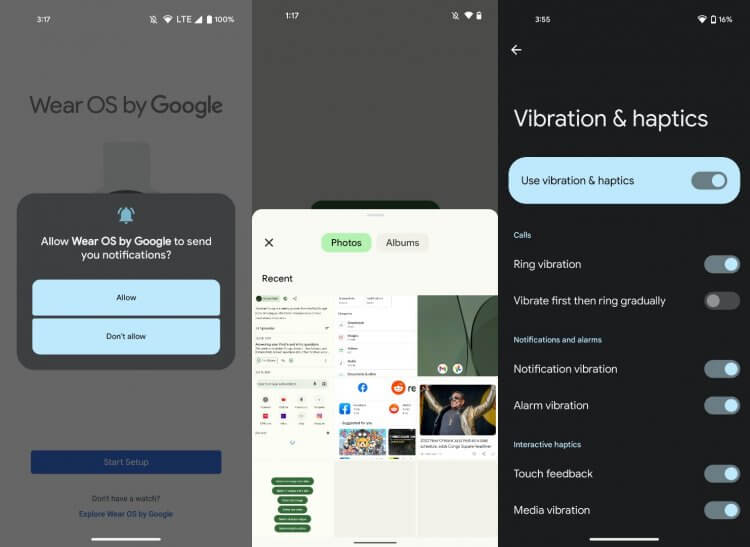
Разрешить или запретить приложению присылать уведомления теперь можно при первом запуске
Заключительная категория изменений затронула взаимодействия смартфона с остальными гаджетами вашего дома. В новой версии операционной системы появилась не только поддержка Bluetooth LE, но и пространственного звучания Spatial Audio. Андроид 13 автоматически изменяет направление звука в зависимости от поворота головы пользователя. Конечно, для работы такой функции необходимо наличие соответствующего аудиоустройства вроде беспроводных наушников Pixel Buds Pro.
При наличии Chromebook вы можете воспользоваться функцией потоковой передачи контента с одного устройства на другое. К примеру, можно выделить картинку на смартфоне, нажать кнопку «Копировать», а в качестве адресата выбрать планшет или ноутбук Google. Изображение сразу же появится на втором устройстве, и вы сможете быстро приступить к его редактированию или выполнению других задач.
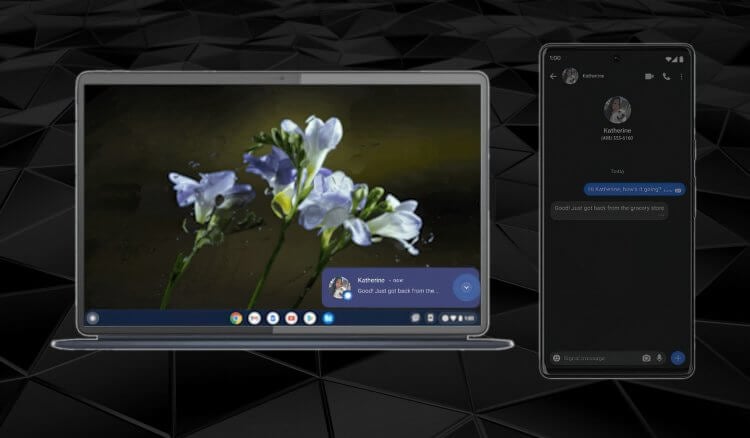
Передавать можно не только мультимедиа, но и сообщения
Конечно, это далеко не все фишки, которыми порадует Android 13. Также для новой ОС заявлена поддержка записи HDR-видео в сторонних приложениях камеры, а для планшетов Google переработана панель задач для одновременного выполнения двух действий.
Какие смартфоны получат Android 13
Начиная с 15 августа, скачать и установить Android 13 на свой телефон могут обладатели устройств Google Pixel, а именно следующих моделей:
- Pixel 4;
- Pixel 4a (5G);
- Pixel 4 XL;
- Pixel 5;
- Pixel 5a;
- Pixel 6;
- Pixel 6a.
- Pixel 6 Pro.
До конца 2022 года обновление получат обладатели смартфонов ASUS, OnePlus, Samsung, Sony, realme, vivo, Xiaomi и даже TECNO. Google не сообщает, какие именно модели могут рассчитывать на апдейт прошивки, но у нас есть материал с полным списком устройств. По опыту прошлых лет можно предположить, что до конца 2022 года обновятся только флагманские смартфоны. Остальные модели смогут обзавестись Android 13, начиная с 2023 года.
❗️ ПОДЕЛИСЬ СВОИМ МНЕНИЕМ ОБ ANDROID 13 В НАШЕМ ТЕЛЕГРАМ-ЧАТЕ
Как установить Android 13 на телефон
Если вы являетесь владельцем одного из поддерживаемых устройств Google Pixel, то можете загрузить Android 13 по воздуху, просто проверив наличие обновлений в разделе настроек «Система». В случае обнаружения апдейта нужно подтвердить его загрузку и последующую установку.

Обновление по воздуху выполняется в два клика
Также установить обновление можно вручную, но этот вариант подойдет только тем, кто умеет пользоваться ADB (Android Debug Bridge). Краткая инструкция выглядит следующим образом:
- Загрузите файл образа системы на компьютер по ссылке.
- Активируйте на смартфоне отладку по USB через настройки разработчиков.
- Выключите телефон.
- Перейдите в режим восстановления (recovery mode), зажав кнопку питания и нижнюю качельку громкости.
- Распакуйте пакет ADB на ПК и переместите в распакованную папку образ ОС.
- Подключите смартфон к ПК, используя USB-кабель.
- Запустите «ADB.exe» на компьютере.
- Введите команду формата «adb sideload X», где вместо «X» укажите точное имя образа системы с его расширением (например, «android13.zip»).
- Перезагрузите смартфон, выбрав в режиме восстановления «reboot system now».
Во всех остальных случаях настоятельно рекомендуем дождаться обновления по воздуху, чтобы не испытывать удачу с ручной установкой Android 13, которая может привести к непоправимым последствиям
https://ria.ru/20211017/android-1754788374.html
Все секреты Android 12: стоит ли обновлять смартфон на новую ОС Google
Все секреты Android 12: стоит ли обновлять смартфон на новую ОС Google — РИА Новости, 17.10.2021
Все секреты Android 12: стоит ли обновлять смартфон на новую ОС Google
Компания Google планово и без лишнего шума представила 12-ю версию мобильной операционной системы Android. Говорить о радикальном обновлении не приходится, но… РИА Новости, 17.10.2021
2021-10-17T08:00
2021-10-17T08:00
2021-10-17T08:08
наука
технологии
apple ios
google android
samsung
/html/head/meta[@name=’og:title’]/@content
/html/head/meta[@name=’og:description’]/@content
https://cdnn21.img.ria.ru/images/07e5/0a/0f/1754787864_0:161:3070:1888_1920x0_80_0_0_64af3dd4b093408a91aa0f7be48b8f22.jpg
МОСКВА, 17 окт — РИА Новости, Кирилл Каримов. Компания Google планово и без лишнего шума представила 12-ю версию мобильной операционной системы Android. Говорить о радикальном обновлении не приходится, но интересного там много. О том, что скоро получат Android-смартфоны, — в материале РИА Новости.Иной дизайнВ Google объявили о переходе к дизайн-концепции Material You. По названию легко догадаться, что разработчики вдохновлялись идеей кастомизации системы для конкретного пользователя. В Android с этим всегда было все хорошо, но в 12-й версии «корпорация добра» пошла еще дальше.Теперь в системе единое цветовое пространство. При смене обоев главного экрана ОС автоматически подстраивает под них всю цветовую гамму — от иконок быстрых настроек до подложки окон. Причем система распознает не только главные цвета снимка для обоев, но и оттенки, используя их в оформлении.Традиционно некоторые функции и решения в новую версию ОС перекочевали со сторонних оболочек производителей Android-устройств. Например, если для пользователей MIUI или ColorOS давно уже не диковинка возможность скрытия выреза под фронтальную камеру, то вот на чистом Android — это впервые.В шторке уведомлений привычные иконки заменили на увеличенные плашки. На них помещается больше информации, это явно отход от минимализма «ванильного» Android. Элементы интерфейса стали более плавными — в очередной раз Google закругляет углы. В этом смысле Android 12 следует тренду индустрии — эта мода настолько актуальна, что докатилась даже до консервативной Windows.Не ждите новых функцийА вот каких-то уникальных возможностей от Android 12 ждать не стоит — Google уже несколько лет предпочитает добавлять новые функции в свои многочисленные сервисы, но не в систему. Хотя не обошлось без интересных мелочей.Удивительно, но до 12-й версии Android не умел делать так называемые длинные скриншоты, когда снимок захватывает несколько страниц экрана. Теперь это доступно «из коробки». Впрочем, многие и так этим пользуются несколько лет — подобный скриншот умеют снимать практически все сторонние оболочки.Кое-что в Android 12 перекочевало из iOS, например возможность назначить на постукивание по корпусу разные действия или вызов приложений. В iPhone такое есть уже второй год, смартфоны же на гугловской ОС получат ограниченную поддержку расширенного взаимодействия, ведь пока оно будет доступно лишь на моделях линейки Pixel. Зато всем достанется другая функция iOS — в строке уведомлений появился индикатор того, что приложение использует микрофон или камеру.Google по традиции обещает, что новая версия Android оптимизирована лучше и работает быстрее, чем предшественница. Дескать, теперь до 22 процентов шустрее с обновлением. И владельцы смартфонов Pixel отчасти это подтверждают — синтетические тесты демонстрируют, что процессоры смартфонов ненамного, но все же стали быстрее.Безопасности много не бываетНе забыли и про общую безопасность системы и конфиденциальность пользователя. Ветер из мира ноутбуков задул и здесь — отныне можно не только запрещать программам доступ к камере или микрофону, но и отключать сенсоры через шторку. Правда, лишь на время.Вместе с этим есть доступ к расширенной статистике («Панель приватности») того, какие приложения получали доступ к сенсорам устройства за последние сутки, в том числе к камере и микрофону. Система даже подсчитает, сколько времени тот или иной софт использовал, например, данные о геолокации.Google внедряет функцию режима гибернации для софта. В настройках приложения нужно это отметить. Если апплет не запускается, стираются все временные файлы и перестают поступать от него уведомления. Эта функция поможет оптимизировать потребление системных ресурсов.Какие смартфоны получат Android 12Первыми Android 12 обрели смартфоны Pixel: от Pixel 3 до Pixel 5. Естественно, референсные модели Google работают на эталонной версии операционной системы, максимально обновленной.Android 12 достанется и смартфонам других производителей, но гораздо позже. В предварительном списке — десятки моделей от OnePlus, Xiaomi, Samsung, Oppo и realme. Большая часть этих трубок представлены в 2020-2021 годах. Так, Xiaomi обновит ОС на 11T Pro, Redmi Note 10, Poco X3 Pro, планшете Pad 5 и ряде других устройств. В случае с этим китайским производителем, новый «зеленый робот» придет к ним в виде оболочки MIUI 13.Если ваш смартфон не попал в список, не расстраивайтесь. Во-первых, рассылка апдейтов растянется до лета следующего года — может, еще и получите. Во-вторых, нового в 12-м «роботе» не так уж и много. И наконец, большинство производителей смартфонов давно используют собственные оболочки со своим дизайном. Даже если обновление к ним все-таки поступит, внешних изменений почти не будет. Энтузиасты же всегда смогут прошить подопытное устройство на ту или иную сборку, основанную на Android 12.
https://ria.ru/20211009/windows-1753721889.html
РИА Новости
internet-group@rian.ru
7 495 645-6601
ФГУП МИА «Россия сегодня»
https://xn--c1acbl2abdlkab1og.xn--p1ai/awards/
2021
РИА Новости
internet-group@rian.ru
7 495 645-6601
ФГУП МИА «Россия сегодня»
https://xn--c1acbl2abdlkab1og.xn--p1ai/awards/
Новости
ru-RU
https://ria.ru/docs/about/copyright.html
https://xn--c1acbl2abdlkab1og.xn--p1ai/
РИА Новости
internet-group@rian.ru
7 495 645-6601
ФГУП МИА «Россия сегодня»
https://xn--c1acbl2abdlkab1og.xn--p1ai/awards/
https://cdnn21.img.ria.ru/images/07e5/0a/0f/1754787864_170:0:2901:2048_1920x0_80_0_0_48cbd77e975b57c083d95468d7faa415.jpg
РИА Новости
internet-group@rian.ru
7 495 645-6601
ФГУП МИА «Россия сегодня»
https://xn--c1acbl2abdlkab1og.xn--p1ai/awards/
РИА Новости
internet-group@rian.ru
7 495 645-6601
ФГУП МИА «Россия сегодня»
https://xn--c1acbl2abdlkab1og.xn--p1ai/awards/
технологии, apple ios, google android, google, samsung
Наука, Технологии, Apple iOS, Google Android, Google, Samsung
08:00 17.10.2021 (обновлено: 08:08 17.10.2021)
МОСКВА, 17 окт — РИА Новости, Кирилл Каримов. Компания Google планово и без лишнего шума представила 12-ю версию мобильной операционной системы Android. Говорить о радикальном обновлении не приходится, но интересного там много. О том, что скоро получат Android-смартфоны, — в материале РИА Новости.
В Google объявили о переходе к дизайн-концепции Material You. По названию легко догадаться, что разработчики вдохновлялись идеей кастомизации системы для конкретного пользователя. В Android с этим всегда было все хорошо, но в 12-й версии «корпорация добра» пошла еще дальше.
Теперь в системе единое цветовое пространство. При смене обоев главного экрана ОС автоматически подстраивает под них всю цветовую гамму — от иконок быстрых настроек до подложки окон. Причем система распознает не только главные цвета снимка для обоев, но и оттенки, используя их в оформлении.
Традиционно некоторые функции и решения в новую версию ОС перекочевали со сторонних оболочек производителей Android-устройств. Например, если для пользователей MIUI или ColorOS давно уже не диковинка возможность скрытия выреза под фронтальную камеру, то вот на чистом Android — это впервые.
В шторке уведомлений привычные иконки заменили на увеличенные плашки. На них помещается больше информации, это явно отход от минимализма «ванильного» Android. Элементы интерфейса стали более плавными — в очередной раз Google закругляет углы. В этом смысле Android 12 следует тренду индустрии — эта мода настолько актуальна, что докатилась даже до консервативной Windows.
Не ждите новых функций
А вот каких-то уникальных возможностей от Android 12 ждать не стоит — Google уже несколько лет предпочитает добавлять новые функции в свои многочисленные сервисы, но не в систему. Хотя не обошлось без интересных мелочей.
Удивительно, но до 12-й версии Android не умел делать так называемые длинные скриншоты, когда снимок захватывает несколько страниц экрана. Теперь это доступно «из коробки». Впрочем, многие и так этим пользуются несколько лет — подобный скриншот умеют снимать практически все сторонние оболочки.
Кое-что в Android 12 перекочевало из iOS, например возможность назначить на постукивание по корпусу разные действия или вызов приложений. В iPhone такое есть уже второй год, смартфоны же на гугловской ОС получат ограниченную поддержку расширенного взаимодействия, ведь пока оно будет доступно лишь на моделях линейки Pixel. Зато всем достанется другая функция iOS — в строке уведомлений появился индикатор того, что приложение использует микрофон или камеру.
Google по традиции обещает, что новая версия Android оптимизирована лучше и работает быстрее, чем предшественница. Дескать, теперь до 22 процентов шустрее с обновлением. И владельцы смартфонов Pixel отчасти это подтверждают — синтетические тесты демонстрируют, что процессоры смартфонов ненамного, но все же стали быстрее.
Чистый Android 12 можно увидеть только на Pixel
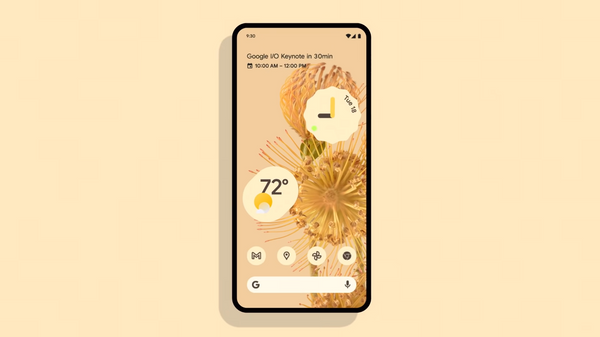
1 из 4
Чистый Android 12 можно увидеть только на Pixel
Новая шторка Android
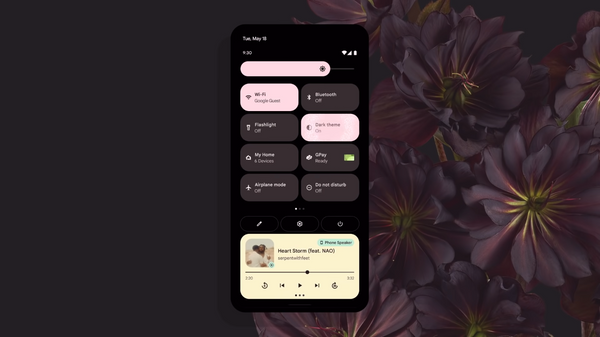
В Android 12 можно отследить то, как работает приложение
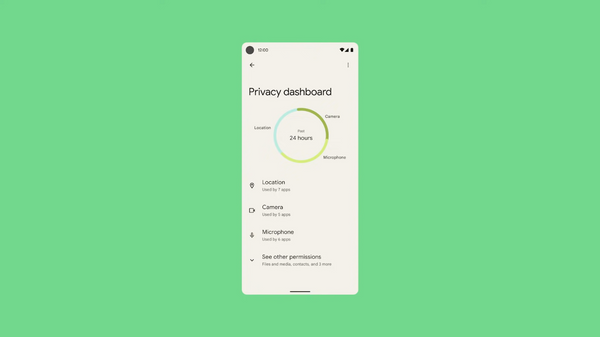
3 из 4
В Android 12 можно отследить то, как работает приложение
Дизайн Material You будет подстраиваться под пользователя

4 из 4
Дизайн Material You будет подстраиваться под пользователя
1 из 4
Чистый Android 12 можно увидеть только на Pixel
3 из 4
В Android 12 можно отследить то, как работает приложение
4 из 4
Дизайн Material You будет подстраиваться под пользователя
Безопасности много не бывает
Не забыли и про общую безопасность системы и конфиденциальность пользователя. Ветер из мира ноутбуков задул и здесь — отныне можно не только запрещать программам доступ к камере или микрофону, но и отключать сенсоры через шторку. Правда, лишь на время.
Вместе с этим есть доступ к расширенной статистике («Панель приватности») того, какие приложения получали доступ к сенсорам устройства за последние сутки, в том числе к камере и микрофону. Система даже подсчитает, сколько времени тот или иной софт использовал, например, данные о геолокации.
Google внедряет функцию режима гибернации для софта. В настройках приложения нужно это отметить. Если апплет не запускается, стираются все временные файлы и перестают поступать от него уведомления. Эта функция поможет оптимизировать потребление системных ресурсов.
Какие смартфоны получат Android 12
Первыми Android 12 обрели смартфоны Pixel: от Pixel 3 до Pixel 5. Естественно, референсные модели Google работают на эталонной версии операционной системы, максимально обновленной.
Android 12 достанется и смартфонам других производителей, но гораздо позже. В предварительном списке — десятки моделей от OnePlus, Xiaomi, Samsung, Oppo и realme. Большая часть этих трубок представлены в 2020-2021 годах. Так, Xiaomi обновит ОС на 11T Pro, Redmi Note 10, Poco X3 Pro, планшете Pad 5 и ряде других устройств. В случае с этим китайским производителем, новый «зеленый робот» придет к ним в виде оболочки MIUI 13.
Если ваш смартфон не попал в список, не расстраивайтесь. Во-первых, рассылка апдейтов растянется до лета следующего года — может, еще и получите. Во-вторых, нового в 12-м «роботе» не так уж и много. И наконец, большинство производителей смартфонов давно используют собственные оболочки со своим дизайном. Даже если обновление к ним все-таки поступит, внешних изменений почти не будет. Энтузиасты же всегда смогут прошить подопытное устройство на ту или иную сборку, основанную на Android 12.
The version history of the Android mobile operating system began with the public release of the Android beta on November 5, 2007. The first commercial version, Android 1.0, was released on September 23, 2008. Android is developed by Google in which new major releases are announced at Google I/O along with its first public beta to supported Google Pixel devices and its stable version released later in the year.
Overview
The development of Android started in 2003 by Android, Inc., which was purchased by Google in 2005.[1] There were at least two internal releases of the software inside Google and the Open Handset Alliance (OHA) before the beta version was released.[2][3] The beta was released on November 5, 2007,[4][5] while the software development kit (SDK) was released on November 12, 2007.[6] Several public beta versions of the SDK were released.[7] These releases were done through software emulation as physical devices did not exist to test the operating system. Both the operating system itself and the SDK were released along with their source code, as free software under the Apache License.[8]
The first public release of Android 1.0 occurred with the release of the T-Mobile G1 (aka HTC Dream) in October 2008.[9] Android 1.0 and 1.1 were not released under specific code names.[10] The code names «Astro Boy» and «Bender» were tagged internally on some of the early pre-1.0 milestone builds and were never used as the actual code names of the 1.0 and 1.1 releases of the OS.[11]
The project manager, Ryan Gibson, conceived using a confectionery-themed naming scheme for public releases, starting with Android 1.5 Cupcake. Google announced in August 2019 they were ending the confectionery theming scheme to use numerical ordering for future versions.[12] The first release under the numerical order format was Android 10, which was released September 2019.
In 2017, Google announced that Google Play would begin to require apps to target a recent Android version.[13] Since then, a new major Android version has been released in the second half of each year, and apps must target it by August 1 of the following year for new apps, or November 1 for app updates.[14]
| Name | Internal codename[10] | Version number(s) | API level | Initial stable release date | Latest security patch date[15] | Latest Google Play Services version[16] (release date) |
|---|---|---|---|---|---|---|
| Android 1.0 | — | 1.0 | 1 | September 23, 2008 | — | — |
| Android 1.1 | Petit Four | 1.1 | 2 | February 9, 2009 | ||
| Android Cupcake | Cupcake | 1.5 | 3 | April 27, 2009 | ||
| Android Donut | Donut | 1.6 | 4 | September 15, 2009 | ||
| Android Eclair | Eclair | 2.0 | 5 | October 27, 2009 | ||
| 2.0.1 | 6 | December 3, 2009 | ||||
| 2.1 | 7 | January 11, 2010[17] | ||||
| Android Froyo | Froyo | 2.2 – 2.2.3 | 8 | May 20, 2010 | 3.2.25 (October 2014) | |
| Android Gingerbread | Gingerbread | 2.3 – 2.3.2 | 9 | December 6, 2010 | 10.0.84 (November 2016) | |
| 2.3.3 – 2.3.7 | 10 | February 9, 2011 | ||||
| Android Honeycomb | Honeycomb | 3.0 | 11 | February 22, 2011 | ||
| 3.1 | 12 | May 10, 2011 | ||||
| 3.2 – 3.2.6 | 13 | July 15, 2011 | ||||
| Android Ice Cream Sandwich | Ice Cream Sandwich | 4.0 – 4.0.2 | 14 | October 18, 2011 | 14.8.49 (February 2019) | |
| 4.0.3 – 4.0.4 | 15 | December 16, 2011 | ||||
| Android Jelly Bean | Jelly Bean | 4.1 – 4.1.2 | 16 | July 9, 2012 | 21.33.56 (September 2021) | |
| 4.2 – 4.2.2 | 17 | November 13, 2012 | ||||
| 4.3 – 4.3.1 | 18 | July 24, 2013 | ||||
| Android KitKat | Key Lime Pie | 4.4 – 4.4.4 | 19 | October 31, 2013 | October 2017 | 22.49.13 (December 2022) |
| 4.4W – 4.4W.2 | 20 | June 25, 2014 | ? | |||
| Android Lollipop | Lemon Meringue Pie | 5.0 – 5.0.2 | 21 | November 4, 2014[18] | November 2017 | |
| 5.1 – 5.1.1 | 22 | March 2, 2015[19] | March 2018 | |||
| Android Marshmallow | Macadamia Nut Cookie | 6.0 – 6.0.1 | 23 | October 2, 2015[20] | August 2018 | |
| Android Nougat | New York Cheesecake | 7.0 | 24 | August 22, 2016 | August 2019 | |
| 7.1 – 7.1.2 | 25 | October 4, 2016 | October 2019 | |||
| Android Oreo | Oatmeal Cookie | 8.0 | 26 | August 21, 2017 | January 2021 | |
| 8.1 | 27 | December 5, 2017 | October 2021 | |||
| Android Pie | Pistachio Ice Cream[21] | 9 | 28 | August 6, 2018 | January 2022 | |
| Android 10 | Quince Tart[22] | 10 | 29 | September 3, 2019 | December 2022 | |
| Android 11 | Red Velvet Cake[22] | 11 | 30 | September 8, 2020 | ||
| Android 12 | Snow Cone | 12 | 31 | October 4, 2021 | ||
| Android 12L | Snow Cone v2 | 12.1[a] | 32 | March 7, 2022 | ||
| Android 13 | Tiramisu[24] | 13 | 33 | August 15, 2022 | ||
| Android 14 | Upside Down Cake[25] | 14 | 34 | Q3 2023 | — | — |
| Legend: Old version Older version, still maintained Latest version Future release |
Version history
The following tables show the release dates and key features of all Android operating system updates to date, listed chronologically by their official application programming interface (API) levels.
Android 1.0
| Android 1.0 (API 1) | ||
|---|---|---|
| Android 1.0, the first commercial version of the software, was released on September 23, 2008.[26] The first commercially available Android device was the HTC Dream.[27] Android 1.0 incorporated the following features: | ||
| Version | Release date | Features |
| 1.0 | September 23, 2008 |
|
Android 1.1
| Android 1.1 (API 2) | ||
|---|---|---|
| On February 9, 2009, the Android 1.1 update was released, initially for the HTC Dream only. Android 1.1 was known as «Petit Four» internally, though this name was not used officially.[11][34] The update resolved bugs, changed the Android API and added a number of features:[35] | ||
| Version | Release date | Features |
| 1.1 | February 9, 2009 |
|
Android 1.5 Cupcake
| Android 1.5 Cupcake (API 3) | |||
|---|---|---|---|
| On April 27, 2009, the Android 1.5 update was released, based on Linux kernel 2.6.27.[36][37] This was the first release to officially use a codename based on a dessert item («Cupcake»), a theme used for all releases until Android Pie, with Android 10 using a number-only system. The update included several new features and UI amendments:[38] | |||
| Version | Release date | Features | Image(s) |
| 1.5 | April 27, 2009[36] |
|  Android 1.5 home screen |
Android 1.6 Donut
| Android 1.6 Donut (API 4) | |||
|---|---|---|---|
| On September 15, 2009, Android 1.6 – dubbed Donut – was released, based on Linux kernel 2.6.29.[41][42][43] Included in the update were numerous new features:[41] | |||
| Version | Release date | Features | Image(s) |
| 1.6 | September 15, 2009[42] |
|  Android 1.6 home screen |
Android 2.0 Eclair
| Android 2.0 Eclair (API 5) | |||
|---|---|---|---|
| On October 27, 2009, the Android 2.0 SDK was released, based on Linux kernel 2.6.29 and codenamed Eclair.[44] Changes include the ones listed below.[45] | |||
| Version | Release date | Features | Image(s) |
| 2.0 | October 27, 2009[46] |
|
Android 2.0.1 Eclair
| Android 2.0.1 Eclair (API 6) | |||
|---|---|---|---|
| Version | Release date | Features | Image(s) |
| 2.0.1 | December 3, 2009[50] |
|
Android 2.1 Eclair
| Android 2.1 Eclair (API 7) | |||
|---|---|---|---|
| Version | Release date | Features | Image(s) |
| 2.1 | January 11, 2010[51][17] |
|  Android 2.1 home screen |
Android 2.2 Froyo
Android 2.2 Froyo (API  | |||
|---|---|---|---|
| On May 20, 2010, the SDK for Android 2.2 (Froyo, short for frozen yogurt) was released, based on Linux kernel 2.6.32.[52] | |||
| Version | Release date | Features | Image(s) |
| 2.2 | May 20, 2010 |
|  Android 2.2 home screen |
| 2.2.1 | September 27, 2010[60] |
| |
| 2.2.2 | January 21, 2011[61] |
| |
| 2.2.3 | November 21, 2011[63] |
|
Android 2.3 Gingerbread
| Android 2.3 Gingerbread (API 9) | |||
|---|---|---|---|
| On December 6, 2010, the Android 2.3 (Gingerbread) SDK was released, based on Linux kernel 2.6.35.[64][65] Changes included:[64] | |||
| Version | Release date | Features | Image(s) |
| 2.3 | December 6, 2010[65] |
|  Android 2.3 home screen |
| 2.3.1 | December 22, 2010[68] |
| |
| 2.3.2 | January 21, 2011[69] |
|
Android 2.3.3 Gingerbread
| Android 2.3.3 Gingerbread (API 10) | |||
|---|---|---|---|
| Version | Release date | Features | Image(s) |
| 2.3.3 | February 9, 2011[70] |
| |
| 2.3.4 | April 28, 2011[72] |
| |
| 2.3.5 | July 25, 2011[77] |
| |
| 2.3.6 | September 2, 2011[79] |
| |
| 2.3.7 | September 21, 2011 |
|
Android 3.0 Honeycomb
| Android 3.0 Honeycomb (API 11) | |||
|---|---|---|---|
| On February 22, 2011, the Android 3.0 (Honeycomb) SDK – the first tablet-only Android update – was released, based on Linux kernel 2.6.36.[82][83][84][85] The first device featuring this version, the Motorola Xoom tablet, was released on February 24, 2011.[86] The update’s features included:[82] | |||
| Version | Release date | Features | Image(s) |
| 3.0 | February 22, 2011[84] |
|  Android 3.0 home screen |
Android 3.1 Honeycomb
| Android 3.1 Honeycomb (API 12) | |||
|---|---|---|---|
| Version | Release date | Features | Image(s) |
| 3.1 | May 10, 2011[90] |
|
Android 3.2 Honeycomb
| Android 3.2 Honeycomb (API 13) | |||
|---|---|---|---|
| Version | Release date | Features | Image(s) |
| 3.2 | July 15, 2011[93] |
| |
| 3.2.1 | September 20, 2011 |
| |
| 3.2.2 | September 30, 2011 |
| |
| 3.2.4 | December 15, 2011 |
| |
| 3.2.6 | February 15, 2012 |
|
Android 4.0 Ice Cream Sandwich
| Android 4.0 Ice Cream Sandwich (API 14) | |||
|---|---|---|---|
| The SDK for Android 4.0.1 (Ice Cream Sandwich), based on Linux kernel 3.0.1,[95] was publicly released on October 19, 2011.[96] Google’s Gabe Cohen stated that Android 4.0 was «theoretically compatible» with any Android 2.3.x device in production at that time.[97] The source code for Android 4.0 became available on November 14, 2011.[98] Ice Cream Sandwich was the last version to officially support Adobe Systems’ Flash player.[99] The update introduced numerous new features:[100][101][102] | |||
| Version | Release date | Features | Image(s) |
| 4.0 | October 18, 2011[100] |
| 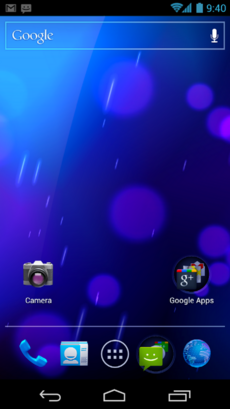 Android 4.0 home screen |
| 4.0.1 | October 19, 2011 |
| |
| 4.0.2 | November 28, 2011 |
|
Android 4.0.3 Ice Cream Sandwich
| Android 4.0.3 Ice Cream Sandwich (API 15) | |||
|---|---|---|---|
| Version | Release date | Features | Image(s) |
| 4.0.3 | December 16, 2011[108] |
| |
| 4.0.4 | March 28, 2012 |
|
Android 4.1 Jelly Bean
| Android 4.1 Jelly Bean (API 16) | |||
|---|---|---|---|
| Google announced Android 4.1 (Jelly Bean) at the Google I/O conference on June 27, 2012. Based on Linux kernel 3.0.31, Jelly Bean was an incremental update with the primary aim of improving the functionality and performance of the user interface. The performance improvement involved «Project Butter», which uses touch anticipation, triple buffering, extended vsync timing and a fixed frame rate of 60 fps to create a fluid and «buttery-smooth» UI.[111] Android 4.1 Jelly Bean was released to the Android Open Source Project on July 9, 2012,[112] and the Nexus 7 tablet, the first device to run Jelly Bean, was released on July 13, 2012. | |||
| Version | Release date | Features | Image(s) |
| 4.1 | July 9, 2012 |
|  Android 4.1 home screen |
| 4.1.1 | July 9, 2012[116] |
| |
| 4.1.2 | October 9, 2012[117] |
|
Android 4.2 Jelly Bean
| Android 4.2 Jelly Bean (API 17) | ||
|---|---|---|
| Google was expected to announce Jelly Bean 4.2 at an event in New York City on October 29, 2012, but the event was cancelled due to Hurricane Sandy.[120] Instead of rescheduling the live event, Google announced the new version with a press release, under the slogan «A new flavor of Jelly Bean». Jelly Bean 4.2 was based on Linux kernel 3.4.0, and debuted on Google’s Nexus 4 and Nexus 10, which were released on November 13, 2012.[121][122] | ||
| Version | Release date | Features |
| 4.2 | November 13, 2012[123] |
|
| 4.2.1 | November 27, 2012[128][129] |
|
| 4.2.2 | February 11, 2013[131] |
|
Android 4.3 Jelly Bean
| Android 4.3 Jelly Bean (API 18) | ||
|---|---|---|
| Google released Jelly Bean 4.3 under the slogan «An even sweeter Jelly Bean» on July 24, 2013, during an event in San Francisco called «Breakfast with Sundar Pichai». Most Nexus devices received the update within a week, although the second-generation Nexus 7 tablet was the first device to officially ship with it.[133] A minor bug fix update was released on August 22, 2013.[134] | ||
| Version | Release date | Features |
| 4.3 | July 24, 2013[135] |
|
| 4.3.1 | October 3, 2013[144] |
|
Android 4.4 KitKat
| Android 4.4 KitKat (API 19) | |||
|---|---|---|---|
| Google announced Android 4.4 KitKat on September 3, 2013. Although initially under the «Key Lime Pie» («KLP») codename, the name was changed because «very few people actually know the taste of a key lime pie.»[146] Some technology bloggers also expected the «Key Lime Pie» release to be Android 5.[147] KitKat debuted on Google’s Nexus 5 on October 31, 2013, and was optimized to run on a greater range of devices than earlier Android versions, having 512 MB of RAM as a recommended minimum; those improvements were known as «Project Svelte» internally at Google.[148] The required minimum amount of RAM available to Android is 340 MB, and all devices with less than 512 MB of RAM must report themselves as «low RAM» devices.[149] | |||
| Version | Release date | Features | Image(s) |
| 4.4 | October 31, 2013[150][151] |
|  Android 4.4 home screen |
| 4.4.1 | December 5, 2013[165][166] |
| |
| 4.4.2 | December 9, 2013[167] |
| |
| 4.4.3 | June 2, 2014[169][170] |
| |
| 4.4.4 | June 19, 2014[173] |
|
Android 4.4W KitKat, with wearable extensions
| Android 4.4W KitKat, with wearable extensions (API 20) | ||
|---|---|---|
| On June 24, 2014, a version of Android KitKat exclusive to Android Wear devices was released. | ||
| Version | Release date | Features |
| 4.4W[175] | June 25, 2014[176] |
|
| 4.4W.1 | September 6, 2014[177] |
|
| 4.4W.2 | October 21, 2014[178] |
|
Android 5.0 Lollipop
| Android 5.0 Lollipop (API 21) | |||
|---|---|---|---|
| Android 5.0 «Lollipop» was unveiled under the codename «Android L» on June 25, 2014, during Google I/O. It became available as an official over-the-air (OTA) update on November 12, 2014, for select devices that run distributions of Android serviced by Google, including Nexus and Google Play edition devices. Its source code was made available on November 3, 2014.[179][180] Lollipop features a redesigned user interface built around a responsive design language referred to as «material design». Other changes include improvements to the notifications, which can be accessed from the lockscreen and displayed within applications as top-of-the-screen banners. Furthermore, Google made internal changes to the platform, with the Android Runtime (ART) officially replacing Dalvik for improved application performance, and with changes intended to improve and optimize battery usage, known internally as Project Volta.[181][182][183][184] | |||
| Version | Release date | Features | Image(s) |
| 5.0[185] | November 4, 2014[18] |
|  Android 5.0 home screen |
| 5.0.1 | December 2, 2014[199] |
| |
| 5.0.2 | December 19, 2014[23] |
|
Android 5.1 Lollipop
| Android 5.1 Lollipop (API 22) | |||
|---|---|---|---|
| Version | Release date | Features | Image(s) |
| 5.1 | March 2, 2015[19] |
| |
| 5.1.1 | April 20, 2015[204][205] |
|
Android 6.0 Marshmallow
| Android 6.0 Marshmallow (API 23) | |||
|---|---|---|---|
| Android 6.0 «Marshmallow» was unveiled under the codename «Android M» during Google I/O on May 28, 2015, for the Nexus 5 and Nexus 6 phones, Nexus 9 tablet, and Nexus Player set-top box, under the build number MPZ44Q.[207] The third developer preview (MPA44G) was released on August 17, 2015 for the Nexus 5, Nexus 6, Nexus 9 and Nexus Player devices,[208] and was updated to MPA44I that brought fixes related to Android for Work profiles.[209] | |||
| Version | Release date | Features | Image(s) |
| 6.0 | October 2, 2015[20][210] |
|  Android 6.0 home screen |
| 6.0.1 | December 7, 2015[228] |
|
Android 7.0 Nougat
| Android 7.0 Nougat (API 24) | |||
|---|---|---|---|
| Android «Nougat» (codenamed N in-development) is the seventh major release of the Android operating system. It was first released as a developer preview on March 9, 2016, with factory images for supported Nexus devices, as well as with the new «Android Beta Program» which allows supported devices to be upgraded directly to the Android Nougat beta via an over-the-air update. The final release was on August 22, 2016. The final preview build was released on July 18, 2016,[230] with the build number NPD90G. | |||
| Version | Release date | Features | Image(s) |
| 7.0 | August 22, 2016[231] |
| 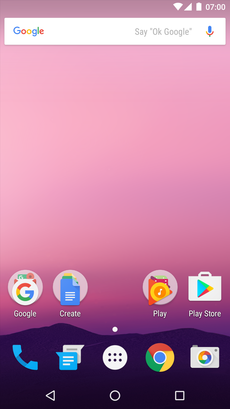 Android 7.0 home screen |
Android 7.1 Nougat
| Android 7.1 Nougat (API 25) | |||
|---|---|---|---|
| On October 19, 2016, Google released Android 7.1.1 as a developer preview for the Nexus 5X, Nexus 6P and the Pixel C. A second preview became available on November 22, 2016, before the final version was released to the public on December 5, 2016. | |||
| Version | Release date | Features | Image(s) |
| 7.1 | October 4, 2016[239] |
|  Android 7.1 home screen |
| 7.1.1[241] | December 1, 2016[242] |
| |
| 7.1.2[243][244] | April 2, 2017[245] |
|
Android 8.0 Oreo
| Android 8.0 Oreo (API 26) | |||
|---|---|---|---|
| Android Oreo is the eighth major release of the Android operating system. It was first released as a developer preview, codenamed Android O, on March 21, 2017, with factory images for supported Nexus and Pixel devices. The final developer preview was released on July 24, 2017, with the stable version released in August 2017. | |||
| Version | Release date | Features | Image(s) |
| 8.0[246] | August 21, 2017 |
| Android 8.0 home screen |
Android 8.1 Oreo
| Android 8.1 Oreo (API 27) | |||
|---|---|---|---|
| Android 8.1 Oreo is the sixteenth minor release of the Android operating system. It was first released as a developer preview on October 25, 2017, with factory images for current Nexus and Pixel devices. A second developer preview was made available on November 27, 2017, for Nexus and Pixel devices, before the stable version was released on December 5, 2017. | |||
| Version | Release date | Features | Image(s) |
| 8.1[248][249] | December 5, 2017[250][251] |
|  Android 8.1 home screen |
Android 9 Pie
| Android 9 Pie (API 28) | |||
|---|---|---|---|
| Android Pie is the ninth major version of the Android operating system. It was first announced by Google on March 7, 2018, and the first developer preview was released on the same day. The second preview, considered beta quality, was released on May 8, 2018. The final beta of Android Pie (fifth preview, also considered as a «Release Candidate») was released on July 25, 2018. The first official release was released on August 6, 2018. | |||
| Version | Release date | Features | Image(s) |
| 9 | August 6, 2018 |
|  Android 9 home screen |
Android 10
| Android 10 (API 29) | |||
|---|---|---|---|
| Android 10 is the tenth major version of the Android operating system. The stable version of Android 10 was released on September 3, 2019. | |||
| Version | Release date | Features | Image(s) |
| 10 | September 3, 2019 |
| 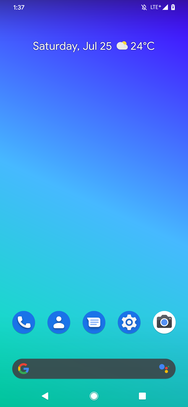 Android 10 home screen |
Android 11
| Android 11 (API 30) | |||
|---|---|---|---|
| Android 11 is the eleventh major version of the Android operating system. It was first announced by Google on February 19, 2020, and the first developer preview released on the same day.[273][274] The launch of Android 11 Beta was postponed from June 3, 2020 to June 10, 2020.[275] | |||
| Version | Release date | Features | Image(s) |
| 11 | September 8, 2020 |
| Android 11 home screen |
Android 12
| Android 12 (API 31) | |||
|---|---|---|---|
| Android 12 is the twelfth major version of the Android operating system. It was first announced by Google on February 18, 2021, and the first developer preview was released on the same day.[281][282] | |||
| Version | Release date | Features | Image(s) |
| 12 | October 4, 2021 |
|  Android 12 home screen with themed icons and widgets |
Android 12L
| Android 12L (API 32) | |||
|---|---|---|---|
| Android 12L[d] is an interim release for Android 12 that includes design tweaks for larger displays and minor stability changes to the operating system. It was announced on October 2021 alongside Beta releases with a stable version launching on March 7, 2022. | |||
| Version | Release date | Features | Image(s) |
| 12L | March 7, 2022 | Improvements specific for foldable phones, tablets, desktop-sized screens and Chromebooks, and modifications to the user interface to tailor it to larger screens.[294] |
Android 13
| Android 13 (API 33) | |||
|---|---|---|---|
| Android 13 is the thirteenth major version of the Android operating system. | |||
| Version | Release date | Features | Image(s) |
| 13 | August 16, 2022 |
|  Android 13 home screen with themed icons and widgets |
Hardware requirements
The main hardware platform for Android is the 64-bit ARM architecture (i.e. ARMv8-A; previously the 32-bit ARMv7 architecture was supported and first ARMv5), with x86[e] and MIPS[f] architectures also officially supported in later versions of Android, but MIPS support has since been deprecated and support was removed in NDK r17.[306]
Android 1.0 through 1.5 required a 2 megapixel camera with autofocus camera. This was relaxed to a fixed-focus camera with Android 1.6.[307]
In 2012, Android devices with Intel processors began to appear, including phones[308] and tablets. While gaining support for 64-bit platforms, Android was first made to run on 64-bit x86 and then on ARM64.[309][310] Since Android 5.0 Lollipop, 64-bit variants of all platforms are supported in addition to the 32-bit variants.
Requirements for the minimum amount of RAM for devices running Android 7.1 depend on screen size and density and type of CPU, ranging from 816 MB–1.8 GB for 64-bit and 512 MB–1.3 GB for 32-bit meaning in practice 1 GB for the most common type of display (while minimum for Android watch is 416 MB).[311][g] The recommendation for Android 4.4 is to have at least 512 MB of RAM,[312] while for «low RAM» devices 340 MB is the required minimum amount that does not include memory dedicated to various hardware components such as the baseband processor.[149] Android 4.4 requires a 32-bit ARMv7, MIPS or x86 architecture processor,[313] together with an OpenGL ES 2.0 compatible graphics processing unit (GPU).[314] Android supports OpenGL ES 1.1, 2.0, 3.0, 3.2 and since Android 7.0 Vulkan (and version 1.1 available for some devices[315]). Some applications may explicitly require a certain version of the OpenGL ES, and suitable GPU hardware is required to run such applications.[314] In 2021, Android was ported to RISC-V.[316] In 2021, Qualcomm said it will support more updates.[317]
See also
- iOS version history
- Wear OS § Version history
Explanatory notes
- ^ 12L launched as part of the March 2022 update to supported Pixel devices. The factory images for March 2022 and subsequent updates displays the version as 12.1.[23] However, the software information on supported devices continues to show Android version 12 with no indication of the update.
- ^ The 2.3.6 update had the side-effect of impairing the Wi-Fi hotspot functionality of many Canadian Nexus S phones. Google acknowledged this problem and fixed it in late September.[80][81]
- ^ For Canadian consumers, 4.0.2 reportedly created a bug on the Galaxy Nexus that crashed the application market when users attempted to view details of any Android application. It also inadvertently reduced the NFC capabilities of the Nexus phone.[106][107]
- ^ Released as «Android 12.1» for smartphones
- ^ Lowest supported x86 generation is the P6 microarchitecture, also called i686.[304]
- ^ Supported is revision 1 of MIPS32[305] and revision 6 for 64-bit MIPS64[304]
- ^ Disk-based memory (hard drives), solid state disk devices such as USB drives, DVD-based storage, bit rates, bus speeds, and network speeds, are specified using decimal meanings for k (10001), M (10002), G (10003), etc.
References
- ^ Elgin, Ben (August 17, 2005). «Google Buys Android for Its Mobile Arsenal». Bloomberg Businessweek. Bloomberg. Archived from the original on February 27, 2011. Retrieved February 20, 2012.
- ^ «A History of Pre-Cupcake Android Codenames». Android Police. June 12, 2013. Archived from the original on June 12, 2013 – via Google+.
{{cite web}}: CS1 maint: unfit URL (link) See post by Dianne Hackborn - ^ «Dan Morrill». Google+. January 2, 2013. Archived from the original on January 19, 2013. Retrieved January 5, 2013.
- ^ «Google Launches Android, an Open Mobile Platform». Google Operating System. November 5, 2007. Archived from the original on September 30, 2011.
- ^ «Live Google’s gPhone Open handset alliance conference call» (transcript). Gizmodo. November 5, 2007. Archived from the original on February 7, 2013. Retrieved February 8, 2013.
- ^ «Google releases Android SDK». MacWorld. November 12, 2007. Archived from the original on August 22, 2010. Retrieved February 8, 2013.
- ^ «SDK Archives». Android Developers. Archived from the original on March 3, 2015. Retrieved March 7, 2015.
- ^ Paul, Ryan (November 6, 2007). «Why Google chose the Apache Software License over GPLv2 for Android». Ars Technica. Retrieved December 9, 2022.
- ^ «The history of Android: Android 1.0—introducing Google Apps and actual hardware». Ars Technica. June 16, 2014. Archived from the original on March 10, 2015. Retrieved December 5, 2018.
- ^ a b «Codenames, Tags, and Build Numbers». Android Open Source Project. Google. Retrieved June 1, 2022.
- ^ a b «A History of Pre-Cupcake Android Codenames». Android Police. September 17, 2012. Archived from the original on August 25, 2013. Retrieved December 5, 2019.
- ^ «A pop of color and more: updates to Android’s brand». Google. August 22, 2019.
- ^ Cunningham, Edward (December 19, 2017). «Improving app security and performance on Google Play for years to come». Android Developers Blog. Retrieved June 30, 2020.
- ^ «Target API level requirements for Google Play apps — Play Console Help». support.google.com. Retrieved October 4, 2022.
- ^ «Android Security Bulletins». Android Open Source Project. Retrieved February 8, 2022.
- ^ «Google Play services by Google LLC». APKMirror. Retrieved February 8, 2022.
- ^ a b «Android 2.1 SDK».
- ^ a b «refs/tags/android-5.0.0_r1 – platform/system/core – Git at Google». android.googlesource.com.
- ^ a b «refs/tags/android-5.1.0_r1 – platform/system/core – Git at Google». android.googlesource.com.
- ^ a b «refs/tags/android-6.0.0_r1 – platform/system/core – Git at Google». android.googlesource.com.
- ^ Parker, Steven. «Android P being referred to as ‘Pistachio Ice Cream’ internally at Google». Neowin. Neowin LLC. Retrieved December 15, 2021.
- ^ a b Gartenberg, Chaim (July 23, 2020). «Even Android 11 is cake». The Verge. Vox Media, LLC. Retrieved July 27, 2021.
Burke revealed last year that Android Q had been internally known as «Quince Tart»
- ^ a b «Factory Images for Nexus and Pixel Devices». Google Developers. Retrieved March 31, 2022.
- ^ «13 Developer Preview | Android 13». Android Developers. Retrieved February 11, 2022.
- ^ Bradshaw, Kyle (April 22, 2022). «Android 14 gets official internal codename… Upside Down Cake». 9to5Google. Retrieved October 5, 2022.
- ^ Morrill, Dan (September 23, 2008). «Announcing the Android 1.0 SDK, release 1». Android Developers Blog. Retrieved January 12, 2011.
- ^ «T-Mobile Unveils the T-Mobile G1 – the First Phone Powered by Android». T-Mobile. Archived from the original on October 16, 2013. Retrieved October 15, 2013.
- ^ a b Topolsky, Joshua (October 16, 2008). «T-Mobile G1 review, part 2: software and wrap-up». Engadget. Retrieved June 28, 2013.
- ^ a b c d e «Release features – Android 1.0». 2008. Retrieved February 7, 2013.
- ^ a b c Segan, Sascha (October 16, 2008). «T-Mobile G1 (Google Android Phone)». PC Magazine. Retrieved February 6, 2013.
- ^ LaCouvee, Darcy (October 17, 2008). «Folders on the Android desktop, and how to rename them». Android Authority. Retrieved June 28, 2013.
- ^ «Status Bar Notifications». Android Developers. May 24, 2012. Retrieved June 1, 2012.
- ^ «What is Android?». TechPluto.com. September 18, 2008. Retrieved June 28, 2013.
- ^ «Android Platform Overview». Android Source. Archived from the original on September 22, 2012. Retrieved September 15, 2012.
- ^ «Android 1.1 Version Notes». Android Developers. February 2009. Archived from the original on February 21, 2011. Retrieved April 10, 2020.
- ^ a b Ducrohet, Xavier (April 27, 2009). «Android 1.5 is here!». Android Developers Blog. Archived from the original on September 25, 2009. Retrieved September 3, 2009.
- ^ Rob, Jackson (April 30, 2009). «CONFIRMED: Official Cupcake Update Underway for T-Mobile G1 USA & UK!». Phandroid. Retrieved September 3, 2009.
- ^ «Android 1.5 Platform Highlights». Android Developers. April 2009. Archived from the original on September 1, 2009. Retrieved September 3, 2009.
- ^ «App Widgets». Android Developers. 2012. Retrieved October 23, 2012.
- ^ «Phone Usage History». 101 Android. 2017. Archived from the original on February 23, 2018. Retrieved December 24, 2017.
- ^ a b «Android 1.6 Platform Highlights». Android Developers. September 2009. Archived from the original on April 30, 2010. Retrieved October 1, 2009.
- ^ a b Ducrohet, Xavier (September 15, 2009). «Android 1.6 SDK is here». Android Developers Blog. Archived from the original on September 25, 2009. Retrieved October 1, 2009.
- ^ Ryan, Paul (October 1, 2009). «Google releases Android 1.6; Palm unleashes WebOS 1.2». Ars Technica. Archived from the original on October 2, 2009. Retrieved October 1, 2009.
- ^ «Android 2.0, Release 1». Android Developers. Archived from the original on October 30, 2009. Retrieved October 27, 2009.
- ^ «Android 2.0 Platform Highlights». Android Developers. Archived from the original on October 30, 2009. Retrieved October 27, 2009.
- ^ «Announcing Android 2.0 support in the SDK!».
- ^ «Android 2.0 API Changes Summary». Archived from the original on October 30, 2009. Retrieved March 6, 2010.
- ^ «Force Touch? Android has had that for years». Pocketnow. September 7, 2015. Retrieved June 13, 2021.
- ^ «MotionEvent § getPressure()». Android Developers.
- ^ «Android 2.0.1, Release 1 SDK». Android Developers. Archived from the original on January 15, 2010. Retrieved January 17, 2010.
- ^ «Android 2.1, Release 1». Android Developers. Archived from the original on January 14, 2010. Retrieved January 17, 2010.
- ^ Ducrohet, Xavier (May 20, 2010). «Android 2.2 and developers goodies». Android Developers Blog. Retrieved May 20, 2010.
- ^ a b «Unofficially Confirmed Froyo Features, Post-Day-1 Of Google I/O». Android Police. May 20, 2010. Retrieved May 20, 2010.
- ^ «Nexus One Is Running Android 2.2 Froyo. How Fast Is It Compared To 2.1? Oh, Only About 450% Faster». Android Police. Retrieved May 13, 2010.
- ^ Harbor (June 29, 2010). «Android now fully supports Exchange». harborcomputerservices.net. harborcomputerservices.net. Retrieved September 11, 2010.
- ^ Sorrel, Charlie (May 13, 2010). «Android 2.2 ‘Froyo’ Features USB, Wi-Fi Tethering». Wired. Retrieved February 14, 2013.
- ^ «Browser support for file upload field is coming in Froyo». Retrieved May 13, 2010.
- ^ Stone, Brad (April 27, 2010). «Google’s Andy Rubin on Everything Android». The New York Times. Archived from the original on April 30, 2010. Retrieved May 20, 2010.
- ^ a b «Supporting Multiple Screens: Range of screens supported». Android Developers. Retrieved February 8, 2013.
- ^ «refs/tags/android-2.2.1_r1 – platform/system/core – Git at Google». android.googlesource.com.
- ^ «refs/tags/android-2.2.2_r1 – platform/system/core – Git at Google». android.googlesource.com.
- ^ Hollister, Sean (January 22, 2011). «Nexus One gets tiny update to Android 2.2.2, fixes SMS routing issues». Engadget. Retrieved November 17, 2011.
- ^ «Android 2.2.3 source tag». Retrieved September 2, 2013.
- ^ a b «Android 2.3 Platform Highlights». Android Developers Blog. December 6, 2010. Archived from the original on December 10, 2010. Retrieved December 7, 2010.
- ^ a b Ducrohet, Xavier (December 6, 2010). «Android 2.3 Platform and Updated SDK Tools». Android Developers Blog. Archived from the original on December 27, 2010. Retrieved December 7, 2010.
- ^ Ts’o, Theodore (December 12, 2010). «Android will be using ext4 starting with Gingerbread». Linux Foundation. Archived from the original on May 28, 2011. Retrieved June 11, 2011.
- ^ Tim Bray (December 19, 2010). «Saving Data Safely». Android Developers Blog. Retrieved June 11, 2011.
- ^ «refs/tags/android-2.3.1_r1 – platform/system/core – Git at Google». android.googlesource.com.
- ^ «refs/tags/android-2.3.2_r1 – platform/system/core – Git at Google». android.googlesource.com.
- ^ «Android 2.3.3 Platform, New NFC Capabilities».
- ^ «Android 2.3.3 Platform». Android Developers. 2011. Archived from the original on June 13, 2012. Retrieved November 19, 2012.
- ^ «Android 2.3.4 source tag». Retrieved September 2, 2013.
- ^ «Video Chat on Your Android Phone». Google Mobile Blog. April 28, 2011. Retrieved April 18, 2013.
- ^ «Open Accessory Library 2.3.4». Android Developers. Retrieved August 3, 2012.
- ^ Sarkar, Abhijoy (October 14, 2013). «Is it Java that weakened Android’s SSL security?». Muktware. Retrieved November 2, 2013.
- ^ «Why Android SSL was downgraded from AES256-SHA to RC4-MD5 in late 2010». op-co.de. October 15, 2013. Retrieved November 2, 2013.
- ^ «refs/tags/android-2.3.5_r1 – platform/system/core – Git at Google». android.googlesource.com.
- ^ Arghire, Ionut. «Android 2.3.5 Arrives on Galaxy S in the UK». Softpedia.com. Retrieved December 1, 2011.
- ^ Stephen Schenck (September 2, 2011). «Nexus S Ushers-In Android 2.3.6, But Does It Fix Or Cause Bugs?». pocketnow. Retrieved August 4, 2014.
- ^ Ali Waqas (September 28, 2011). «Android 2.3.6 Gingerbread Update For Nexus S Available (Wi-Fi And Tethering Fix)». Addictive Tips. Retrieved December 20, 2011.
- ^ Anton D. Nagy (September 27, 2011). «Google Samsung Nexus S Gets Android 2.3.6 Update». PocketNow. Archived from the original on December 30, 2011. Retrieved December 20, 2011.
- ^ a b «Android 3.0 Platform Highlights». Android Developers. Archived from the original on February 16, 2011. Retrieved February 23, 2011.
- ^ Rubin, Andy (January 5, 2011). «A Sneak Peek of Android 3.0, Honeycomb». Google Mobile Blog. Archived from the original on January 8, 2011. Retrieved January 5, 2011.
- ^ a b Xavier Ducrohet (February 22, 2011). «Final Android 3.0 Platform and Updated SDK Tools». Android Developers Blog. Archived from the original on March 5, 2011. Retrieved February 23, 2011.
- ^ Mithun Chandrasekhar (February 2, 2011). «Google’s Android Event Analysis». AnandTech. Retrieved February 5, 2011.
I confirmed this with Google; Honeycomb, at least in the current form, will not be coming to non-tablet devices.
- ^ Nilay Patel (January 26, 2011). «Motorola Atrix 4G and Xoom tablet launching at the end of February, Droid Bionic and LTE Xoom in Q2». Engadget. Retrieved February 5, 2011.
- ^ a b c d e f g Raphael, JR (December 5, 2017). «Android nostalgia: 13 once-trumpeted features that quietly faded away». Computerworld. Retrieved December 6, 2017.
- ^ a b Ho, Joshua. «Examining MicroSD changes in Android 4.4». Anandtech. Retrieved March 28, 2014.
- ^ Cody Toombs (February 17, 2014). «External Blues: Google Has Brought Big Changes To SD Cards In KitKat, And Even Samsung Is Implementing Them». Android Police. Retrieved February 20, 2014.
- ^ Ducrohet, Xavier (May 10, 2011). «Android 3.1 Platform, New SDK tools». Android Developers Blog. Archived from the original on May 11, 2011. Retrieved May 10, 2011.
- ^ a b «Android Supported Media Formats». Android Developers. Retrieved March 30, 2012.
- ^ «Issue 1461 – Android – FLAC file support enhancement request». Retrieved August 5, 2011.
- ^ Ducrohet, Xavier (July 15, 2011). «Android 3.2 Platform and Updated SDK tools». Android Developers Blog. Retrieved July 16, 2011.
- ^ «Supporting Multiple Screens: Declaring Tablet Layouts for Android 3.2». Android Developers. 2012. Retrieved February 18, 2013.
- ^ Maroger (October 19, 2011). «Ice Cream Sandwich Runs on Linux Kernel 3.0.1». Fine Oils. Blogspot. Retrieved July 24, 2013.
- ^ Rey, Francis (October 19, 2011). «Android 4.0 Ice Cream Sandwich SDK Now Available». Social Barrel. Retrieved July 24, 2013.
- ^ Stevens, Tim (October 19, 2011). «Google confirms Nexus S will get Ice Cream Sandwich – for real this time (Gingerbread devices, too)». Engadget. Retrieved July 24, 2013.
- ^ Messina, Vincent (November 15, 2011). «Ice Cream Sandwich source code released, custom ROMs inevitable». AndroidGuys. Retrieved July 24, 2013.
- ^ «Today Is The Last Day To Get Flash For Android». WebProNews. August 14, 2012. Retrieved February 7, 2013.
- ^ a b Molen, Brad (October 19, 2011). «Android 4.0 Ice Cream Sandwich now official, includes revamped design, enhancements galore». Engadget. Retrieved October 19, 2011.
- ^ German, Kent (October 18, 2011). «Ice Cream Sandwich adds tons of new features». CNET. Retrieved July 24, 2013.
- ^ Velazco, Chris (October 18, 2011). «A Quick Android 4.0 Ice Cream Sandwich Feature Rundown». Tech Crunch. Retrieved July 24, 2013.
- ^ Fitzpatrick, Jason. «What Exactly Happens When You Swipe An Android App From the Recent Apps List?». How-To Geek. Retrieved September 19, 2014.
- ^ Kennemer, Quentyn (October 19, 2011). «Android 4.0 Ice Cream Sandwich has Hardware Acceleration». Phandroid. Retrieved October 19, 2011.
- ^ «Wi-Fi Direct». Android Developers. Retrieved July 27, 2013.
- ^ «Verizon’s 4G LTE Galaxy Nexus Gets Pictured, Receives Android 4.0.2 Update». DroidLife. November 28, 2011. Retrieved December 8, 2011.
- ^ «Within 2 Hours of Activation, Your Galaxy Nexus Will Receive an Update». DroidLife. December 15, 2011. Retrieved December 15, 2011.
- ^ «Android 4.0.3 Platform and Updated SDK tools». Android Developers Blog. December 16, 2011. Retrieved January 4, 2012.
- ^ «Android 4.0.3 announced, bringing ‘variety of optimizations and bug fixes’ to phones and tablets». Engadget. December 16, 2011. Retrieved December 17, 2011.
- ^ Google announces 4.0.4 on Google+. March 28, 2012. Retrieved March 31, 2012.
- ^ a b c d «Android 4.1 for Developers». Android Developers. Retrieved February 9, 2013.
- ^ Queru, Jean-Baptiste. «Android 4.1 in AOSP». Retrieved July 12, 2012.
- ^ «Confirmed: Android 4.1 uses different layouts for different tablet sizes». ComputerWorld. Archived from the original on January 19, 2013. Retrieved July 8, 2012.
- ^ «Issue 3461: Implement Gapless Playback of consecutive audio files». Retrieved November 12, 2012.
- ^ «Android 4.1 finally adds gapless music playback to stock music apps». Pocketables.com. June 29, 2012. Retrieved June 30, 2012.
- ^ «refs/tags/android-4.1.1_r1 – platform/system/core – Git at Google». android.googlesource.com.
- ^ «Android 4.1.2 rolling out for Nexus 7». The Verge. October 9, 2012. Retrieved October 9, 2012.
- ^ «Android 4.1.2 brings homescreen rotation to devices». GigaOM. October 9, 2012. Retrieved October 9, 2012.
- ^ «New Feature In Android 4.1.2: Expanding/Collapsing Notifications With One Finger (Video)». Android Police. October 9, 2012. Retrieved October 9, 2012.
- ^ «Monday’s Google event in NYC canceled due to Hurricane Sandy». Android Central. October 27, 2012. Retrieved February 19, 2014.
- ^ «Android 4.2 Jelly Bean lands on Nexus 7». Know Your Mobile. November 14, 2012. Archived from the original on November 17, 2012. Retrieved November 14, 2012.
- ^ «Google Releases Nexus 4, Nexus 10 and Android 4.2». IGN. November 13, 2012. Retrieved November 16, 2012.
- ^ «Android 4.2 adds gestue typing, wireless TV display, multiple user support on tablets, and more». The Verge. October 29, 2012. Retrieved October 29, 2012.
- ^ «Android 4.2 Jelly Bean brings all-new photography powers». TechRadar.com. October 29, 2012. Retrieved November 12, 2012.
- ^ a b Klug, Brian (May 19, 2013). «The Next Version of Android – Some of What’s Coming». anandtech.com. Retrieved October 28, 2014.
- ^ «Jelly Bean». Android developer portal. Retrieved July 2, 2014.
- ^ «Exclusive Android 4.2 Alpha Teardown, Part 2: SELinux, VPN Lockdown, And Premium SMS Confirmation». Android Police. October 17, 2012. Retrieved November 12, 2012.
- ^ «refs/tags/android-4.2.1_r1 – platform/system/core – Git at Google». android.googlesource.com.
- ^ «(Changelog) What’s New In Android 4.2.1 (JOP40D)». Android Police. November 27, 2012. Retrieved November 27, 2012.
- ^ «Sorry, Santa – Google Cancels December In Android 4.2». Android Police. November 17, 2012. Retrieved November 27, 2012.
- ^ «Breaking: Android 4.2.2 (Build JDQ39) Update Rolling Out To GSM Galaxy Nexus, Nexus 7, Nexus 10». Android Police. February 11, 2013. Retrieved February 12, 2013.
- ^ «Android 4.2.2 brings Bluetooth audio fixes to Nexus phones and tablets». Ars Technica. February 12, 2013. Retrieved February 12, 2013.
- ^ «Google Announces Android 4.3, Update Rolling Out Today». Tom’s Hardware. July 24, 2013. Retrieved July 25, 2013.
- ^ «Android Open Source Project now has latest 4.3 fixes for most Nexus hardware». Engadget. August 22, 2013. Retrieved August 22, 2013.
- ^ «Android 4.3 announced, rolling out to Nexus devices today». The Verge. July 24, 2013. Retrieved July 24, 2013.
- ^ a b c d e «Introducing Android 4.3, a sweeter Jelly Bean». Official Android Blog. July 24, 2013. Retrieved July 30, 2013.
- ^ «Android 4.3 supports TRIM, improves performance on Nexus devices». Engadget. July 30, 2013. Retrieved July 30, 2013.
- ^ «Another Android 4.3 Change: Photo Spheres Look A Lot Better Now». Android Police. July 25, 2013. Retrieved July 28, 2013.
- ^ «Android 4.3 And Updated Camera UI Spotted On A Nexus 4 At Thailand Mobile Expo». Android Police. May 24, 2013. Retrieved July 30, 2013.
- ^ «App Ops: Android 4.3’s Hidden App Permission Manager, Control Permissions For Individual Apps!». Android Police. July 25, 2013. Retrieved July 30, 2013.
- ^ «Android 4.3 source code reveals support for 4K resolution». Engadget. July 26, 2013. Retrieved July 30, 2013.
- ^ «An In-Depth Look At The Big (And Small) Additions To Android Jelly Bean 4.3». Android Police. July 24, 2013. Retrieved July 25, 2013.
- ^ Jaymar Cabebe (July 25, 2013). «Google Android 4.3 Jelly Bean Release Date, Price and Specs – CNET». CNET. CBS Interactive.
- ^ «Suddenly, A Wild Android 4.3.1 Appears – LTE Nexus 7 Receiving Android 4.3.1 OTA (JLS36I)». Android Police. October 3, 2013. Retrieved October 4, 2013.
- ^ «Factory Image And Binaries Are Now Available For The Nexus 7 LTE Android 4.3.1 Update (JLS36I)». Android Police. October 8, 2013. Retrieved October 9, 2013.
- ^ Kelion, Leo (September 3, 2013). «Android KitKat announced». BBC News. Retrieved September 3, 2013.
- ^ «Android 5.0 Key Lime Pie release date, news and rumors». TechRadar. July 2, 2013. Retrieved July 22, 2013.
- ^ a b c d e f Molen, Brad (November 5, 2013). «Engadget review the Nexus 5». Engadget. Retrieved November 11, 2013.
- ^ a b «7.6.1». Android Compatibility Definition Document (PDF) (4.4 ed.). November 27, 2013. p. 33. Archived from the original (PDF) on March 4, 2014. Retrieved February 26, 2014.
- ^ «Android for all and the new Nexus 5 «. Google Official Blog. October 31, 2013. Retrieved November 1, 2013.
- ^ «Android KitKat». Android Developers Portal. Retrieved November 1, 2013.
- ^ Bonn, Dieter (October 31, 2013). «Google’s Nexus 5 with KitKat available today, starting at $349: hands-on impressions». The Verge. Retrieved November 1, 2013.
- ^ David Ruddock (October 31, 2013). «KitKat Feature Spotlight: Apps Can Now Go Truly Full-Screen, Hide The Navigation Bar». androidpolice.com. Retrieved November 3, 2013.
- ^ «Android menu button now on by default on all device with KitKat». PhoneArena.com. December 9, 2013. Retrieved February 9, 2014.
- ^ «Got the KitKat SD card blues? Solve the problem with SDFix (root required)» – Android Authority, March 18, 2014 (article includes details of restriction)
- ^ a b «External Storage | Android Developers». May 9, 2015. Archived from the original on May 9, 2015.
- ^ «Getting Your SMS Apps Ready for KitKat». Android Developers Blog. Retrieved October 14, 2013.
- ^ «Android 4.4 brings support for low-power audio playback». PhoneArena.com. October 31, 2013. Retrieved February 25, 2014.
- ^ Jason Cipriani (November 5, 2013). «How to record your screen on Android 4.4 KitKat». CNET. CBS Interactive. Retrieved January 4, 2014.
- ^ «Android Developers: ART and Dalvik». source.android.com. March 9, 2015. Retrieved March 19, 2015.
- ^ David Ruddock (October 31, 2013). «KitKat Feature Spotlight: Android Finally Supports Bluetooth MAP, Will Make Bluetooth Integration With Your Car Suck A Lot Less». Android Police. Retrieved November 2, 2013.
- ^ «Android Issue 61975: Undo removal of access to BATTERY_STATS permission for apps». November 2013. Retrieved January 29, 2014.
- ^ «Android Issue 61834: 4.4 KitKat reception/Wifi indicators no longer show data rx/tx during operation». November 2013. Retrieved February 20, 2014.
- ^ «Android Issue 62378: KitKat WebView text wrap no longer works». code.google.com. Retrieved October 28, 2014.
- ^ «refs/tags/android-4.4.1_r1 – platform/system/core – Git at Google». android.googlesource.com.
- ^ «Android 4.4.1 Released to Nexus 5». Google Plus. December 5, 2013. Retrieved December 5, 2013.
- ^ Artem Russakovskii (December 9, 2013). «Android 4.4.2 (KOT49H) Is Already Rolling Out To All Nexus Devices – Here Are The OTA ZIP Links For Manual Updating». Android Police. Retrieved December 9, 2013.
- ^ Peter Eckersley (December 12, 2013). «Google Removes Vital Privacy Feature From Android, Claiming Its Release Was Accidental». Electronic Frontier Foundation. Retrieved December 14, 2013.
- ^ «refs/tags/android-4.4.3_r1 – platform/system/core – Git at Google». android.googlesource.com.
- ^ Ron Amadeo (June 2, 2014). «Google releases Android 4.4.3 to Nexus devices». Ars Technica. Retrieved June 2, 2014.
- ^ Kellex (June 2, 2014). «Fresh New Dialer Arrives in Android 4.4.3». Droid Life. Retrieved June 2, 2014.
- ^ Android Developers (June 3, 2014). «Android 4.4.3 aka KitKat MR2 is rolling out – Google+». Android Developers (Google+). Retrieved June 4, 2014.
- ^ Kellex (June 19, 2014). «Whoa: Android 4.4.4 Factory Images Posted as Build KTU84P». Droid Life. Retrieved June 19, 2014.
- ^ Ryan Whitwam (June 19, 2014). «Google Rolling Out Android 4.4.4 Update (KTU84P) With A Security Fix, Factory Images/Binaries Up For Nexus Devices». androidpolice.com. Retrieved June 25, 2014.
- ^ Rob, Triggs (July 22, 2014). «Google uploads part of the Android Wear source code to AOSP». Android Authority. Retrieved July 22, 2014.
- ^ Andrew Grush (September 6, 2014). «Android Wear platform fully unveiled at I/O 2014». Android Authority. Retrieved January 25, 2015.
- ^ Michael Crider (September 6, 2014). «Samsung Gear Live Updated To Android Wear 4.4W.1 Build KGW42N: Here’s What’s New». Android Police. Retrieved January 25, 2015.
- ^ Rita El Khoury (October 21, 2014). «Android Wear 4.4W.2 Build KNX01Q Starts Rolling Out For The LG G Watch, Brings Offline Music And GPS Support (Though You Can’t Use The Latter)». Android Police. Retrieved January 25, 2015.
- ^ «From Android L to Google Fit: All the new products and features from Google I/O». PC World. June 25, 2014. Archived from the original on June 26, 2014. Retrieved June 26, 2014.
- ^ «Updated Android Lollipop Developer Preview image coming to Nexus devices in a couple of days». PhoneArena.com. October 15, 2014. Retrieved October 16, 2014.
- ^ «Google’s new ‘Material Design’ UI coming to Android, Chrome OS and the web». Engadget. June 25, 2014. Retrieved June 26, 2014.
- ^ «We just played with Android’s L Developer Preview». Engadget. AOL. Retrieved June 26, 2014.
- ^ «Google Reveals Details About Android L at Google IO». Anandtech. Retrieved June 26, 2014.
- ^ Andrei Frumusanu (July 1, 2014). «A Closer Look at Android RunTime (ART) in Android L». AnandTech. Retrieved July 5, 2014.
- ^ a b «Android 5.0 APIs». Android.com. Retrieved October 28, 2014.
- ^ Ben Cheng; Bill Buzbee (May 2010). «A JIT Compiler for Android’s Dalvik VM» (PDF). android-app-developer.co.uk. pp. 5–14. Archived from the original (PDF) on November 6, 2015. Retrieved March 19, 2015.
- ^ «Exploring Android L: Lockscreen widgets also bite the dust». Pocketables.com. June 2014. Retrieved January 25, 2015.
- ^ a b c d e «Android 5.0 Lollipop’s new features». India Times. November 27, 2014. Retrieved December 23, 2014.
- ^ «Lollipop brings proper multi-user accounts to your phone». Android Central. October 17, 2014. Retrieved January 25, 2015.
- ^ Cody Toombs (November 4, 2014). «Android 5.0 Makes SD Cards Great Again, Extends API To Allow Full Directory Access, Automatic MediaStore, And Improves Security». Android Police. Retrieved November 29, 2014.
- ^ Michael Crider (November 27, 2014). «Root Explorer 3.3 Update Adds SD Card Write Capability Without Root In Lollipop». Android Police. Retrieved November 29, 2014.
- ^ «Lollipop stops Chromium bugs from endangering Android». ZDNet. October 24, 2014. Retrieved October 28, 2014.
- ^ «Android – 5.0 Lollipop». Android.com. November 3, 2014. Retrieved November 28, 2014.
- ^ Jason Cipriani (November 3, 2014). «Set up ‘Priority’ mode on Android 5.0 Lollipop». CNET. Retrieved December 23, 2014.
- ^ «Smart lock screen security options in Android 5.0 Lollipop». November 12, 2015.
- ^ «Android 5.0 Emoji Changelog». Emojipedia. November 26, 2014. Retrieved February 2, 2017.
- ^ «Accessibility features in Android 5.0 Lollipop». Android Central. October 25, 2014. Retrieved January 30, 2016.
- ^ «Block-Based OTAs | Android Open Source Project». Android Source. Retrieved January 30, 2016.
- ^ Liam Spradlin (December 2, 2014). «Android 5.0.1 (LRX22C) Hitting AOSP Now (Update: Factory Images Too)». Android Police. Retrieved December 3, 2014.
- ^ Tate, Christopher (November 21, 2014). «Commit 4f868ed to platform/frameworks/base». Android Git Repositories. Retrieved December 27, 2017.
The current heuristics depend on devices being alive at midnight+ in order to run periodic background fstrim operations…If the device goes a defined time without a background fstrim, we [now] force the fstrim at the next reboot. Once the device hits the midnight+ idle fstrim request time, then we already aggressively attempt to fstrim at the first available moment thereafter…’Available’ here means charging + device idle.
- ^ Stephen Schenck (December 22, 2014). «What’s actually new in Android 5.0.2?». PocketNow.com. Archived from the original on January 6, 2015. Retrieved January 6, 2015.
- ^ a b «Google confirms Android 5.1 is rolling out today, will support multi-SIM devices and HD calls». VentureBeat. March 9, 2015. Retrieved April 24, 2015.
- ^ «Android 5.1 reinstates Silent Mode, but there’s a catch». AndroidPIT. Retrieved March 27, 2015.
- ^ «refs/tags/android-5.1.1_r1 – platform/system/core – Git at Google». android.googlesource.com.
- ^ a b «Android 5.1.1 (LMY47V) officially uploaded to AOSP and here’s the full changelog, Nexus Player factory images also available». April 21, 2015. Retrieved May 1, 2015.
- ^ Jennings, Jack (June 26, 2015). «Google Open Source Code for Wi-Fi Calling». XDA. Retrieved November 2, 2015.
- ^ «Google’s Android M preview build will run on the Nexus 5, 6, 9, and Player [Updated]». Ars Technica. Condé Nast. May 28, 2015. Retrieved May 28, 2015.
- ^ «Downloads Android Developers». August 17, 2015.
- ^ «Support and Release Notes | Android Developers». developer.android.com. Retrieved August 22, 2015.
- ^ «Get ready for the sweet taste of Android 6.0 Marshmallow». Android Developers. Retrieved October 6, 2015.
- ^ Mediati, Nick (October 22, 2015). «How to get to Android Marshmallow’s hidden file manager». Greenbot.
- ^ «Customer Community». Archived from the original on April 16, 2021. Retrieved April 16, 2021.
- ^ Bohn, Dieter (May 28, 2015). «Now on Tap is the coolest Android feature in a long time». The Verge.
- ^ «Android Doze».
- ^ «Android vertical app drawer».
- ^ «Android 6.0 APIs – Android Developers».
- ^ «Handling App Links». developer.android.com.
- ^ «App Linking in Android 6.0». developer.android.com.
- ^ «Use Android 6.0’s Hidden System UI Tuner to Customize Your Quick Settings and Status Bar».
- ^ «Android 6.0 APIs – Android Developers».
- ^ «Android 6.0 APIs – Android Developers».
- ^ «Android 6.0 APIs – Android Developers».
- ^ «Everything you need to know about your SD card and Adoptable storage». April 7, 2017.
- ^ «MIDI – Android Open Source Project».
- ^ «How to Unlock the Hidden Multi-Window Mode in Android 6.0 Marshmallow».
- ^ «Enable Multi-Window mode in Android 6.0 Marshmallow with a bit of tinkering». October 6, 2015.
- ^ «Request App Permissions — Android Developers». Android Developers.
- ^ «Google releases Android 6.0.1 Factory Images for Nexus 6P/6, Nexus 5X/5, Nexus Player, Nexus 9 And Nexus 7 [2013]». GadgetzArena. December 7, 2015. Retrieved March 10, 2016.
- ^ «Android 6.0.1 Emoji Changelog». Emojipedia. December 7, 2015. Retrieved February 2, 2017.
- ^ «Android 7.0 Nougat Developer Preview 5 – the final preview – is available for download». Android Police. July 18, 2016. Retrieved July 19, 2016.
- ^ «Taking the final wrapper off of Android 7.0 Nougat».
- ^ Crowley, Paul; Lawrence, Paul (November 17, 2016). «Pixel Security: Better, Faster, Stronger». Google Security Blog. Retrieved March 4, 2019.
- ^ «Android 7.0 Nougat Emoji Changelog». Emojipedia. August 22, 2016. Retrieved February 2, 2017.
- ^ «DocumentsContract». Android Developers.
- ^ «Android 7.0 for Developers — Android Developers». Android Developers.
- ^ «Android N Feature Spotlight: Multiple Device Locales Are Now Supported, Allowing Search Results In Multiple Languages And Other Goodies». March 12, 2016.
- ^ «Camera Version Support». Android Open Source Project.
- ^ «List of All Android Operating System Names (2020 Update)». ProClockers. November 18, 2020.
- ^ «Android 7.1 Nougat’s changelog is here, includes both Pixel-exclusive and non-Pixel exclusive changes». Android Police. October 4, 2016. Retrieved October 5, 2016.
- ^ Sinha, Rupesh (October 20, 2016). «Android 7.1 Changes: What The New Update Brings». Beebom. Retrieved June 12, 2021.
- ^ «A sweet update to Nougat: Android 7.1.1». Google Blog. December 5, 2016. Retrieved December 13, 2016.
- ^ «refs/tags/android-7.1.1_r1 – platform/system/core – Git at Google». android.googlesource.com.
- ^ «Google Groups». productforums.google.com. Retrieved April 4, 2017.
- ^ «Some Pixel C and Nexus Player owners are getting the official Android 7.1.2 update». Android Authority. April 2, 2017. Retrieved April 2, 2017.
- ^ «refs/tags/android-7.1.2_r1 – platform/system/core – Git at Google». android.googlesource.com.
- ^ a b Gibbs, Samuel; Solon, Olivia (August 21, 2017). «Oreo: Google announces release of the next version of Android 8». The Guardian.
- ^ «How Oreo is better than Nougat: Audio». Android Authority. August 23, 2017. Retrieved December 22, 2019.
- ^ «Google Blog». android-developers.googleblog.com. Retrieved October 25, 2017.
- ^ «Android 8.1 developer preview arrives for Pixel and Nexus devices». GoAndroid. October 25, 2017. Retrieved October 25, 2017.
- ^ «Android 8.1 Oreo goes final, rolling out now to Pixel and Nexus devices». Ars Technica. December 5, 2017. Retrieved December 5, 2017.
- ^ Dave Burke (December 5, 2017). «Welcoming Android 8.1 Oreo and Android Oreo (Go edition)». Retrieved December 5, 2017.
- ^ «Android Go is here to fix super cheap phones». The Verge. March 1, 2018.
- ^ «Android 8.1 feature spotlight: A new Oreo Easter egg». Android Police. October 25, 2017. Retrieved November 28, 2017.
- ^ a b Rahman, Mishaal (March 7, 2018). «Here’s Everything New in Android P Developer Preview 1 for the Google Pixel/XL and Pixel 2/XL». XDA Developers. Retrieved March 8, 2018.
- ^ a b c Welch, Chris (March 7, 2018). «The biggest early visual changes in Android P». The Verge. Retrieved March 8, 2018.
- ^ «DNS over TLS support in Android P Developer Preview». Google Security Blog. April 17, 2018.
- ^ «Android 9/10 call recording issues | ACR – Another Call Recorder by NLL APPS». nllapps.com.
- ^ «[Update: OEM Gestures Allowed] Google’s new navigation gestures in Android Q will be mandatory for all devices». xda-developers. May 9, 2019. Retrieved August 15, 2019.
- ^ «Android 10 launcher port brings new gesture animations to Android 9». xda-developers. September 10, 2019.
- ^ Amadeo, Ron (September 23, 2020). «Android 11—The Ars Technica Review». Ars Technica. Retrieved April 17, 2021.
- ^ «Privacy changes in Android 10». Android Developers.
- ^ a b c d e f g h i j k Burke, Dave (March 13, 2019). «Introducing Android Q Beta». Android Developers Blog. Retrieved March 13, 2019.
- ^ Welch, Chris (March 7, 2018). «Android P won’t let apps secretly use your mic or camera in the background». The Verge.
- ^ «Android P will prevent apps from using your camera or microphone without telling you (Updated)». Android Authority. February 21, 2018.
- ^ Nikolov, Mihail. «Android P will prevent background apps from using the camera». Phone Arena.
- ^ «Audio Implementation». Android Open Source Project. Retrieved December 22, 2019.
- ^ Yeow, Goh Beng (October 22, 2019). «Android 10 devices are going to sound better with LHDC™». Porta-Fi™. Retrieved December 22, 2019.
- ^ Burke, Dave (April 3, 2019). «Android Q Beta 2 update». Android Developers Blog. Retrieved April 25, 2019.
- ^ «Bubbles». Android Developers. Archived from the original on April 10, 2019. Retrieved April 25, 2019.
- ^ «Dark theme». Android Developers.
- ^ Schoon, Ben (October 10, 2019). «Google Dark Mode app roundup: Everything available so far».
- ^ «Fresher OS with Projects Treble and Mainline». Android Developers Blog. Retrieved January 6, 2020.
- ^ Burke, Dave. «Turning it up to 11: the first Developer Preview of Android 11». Android Developers Blog. Retrieved May 11, 2020.
- ^ Fedewa, Joe (February 19, 2020). «Android 11 Developer Preview: All the changes we found from Android 10 so far!». xda-developers. Retrieved May 11, 2020.
- ^ «Google delays the Android 11 Beta announcement as protests roil US cities». www.theverge.com. May 30, 2020. Retrieved June 8, 2020.
- ^ a b c Cuthbertso, Stephanie (June 10, 2020). «Unwrapping the Android 11 Beta, plus more developer updates». Android Developers Blog. Retrieved August 20, 2020.
- ^ «Android 11». Android. Retrieved September 25, 2020.
- ^ «Accelerating Android Updates».
- ^ Marsanyi, Ian (September 8, 2020). «Championing employee privacy, productivity with Android 11». Android Enterprise Blog. Retrieved September 25, 2020.
- ^ Schoon, Ben (February 19, 2020). «Android 11 prepares new settings for Gesture Navigation». 9to5Google.
- ^ «Android S: the first Developer Preview of Android 12». Android Developers Blog. Retrieved February 18, 2021.
- ^ «Android 12 Developer Preview: First Developer preview». xda-developers. February 18, 2021. Retrieved February 18, 2021.
- ^ «Android 12 To Finally Bring Scrolling Screenshots». TechiAI. August 15, 2021.
- ^ «Guide to enable One-Handed Mode on Android 12». Gizmochina. March 28, 2021.
- ^ «Android 12 Features». androidauthority. February 18, 2021. Retrieved February 18, 2021.
- ^ «First preview of Android 12».
- ^ «Magnification feature now offers a useful floating window». 9to5Google. February 19, 2021.
- ^ «Android 12 gets ‘Extra Dim’«. Android Police. April 22, 2021.
- ^ «Android 12 features: Everything you need to know about Google’s latest OS». Android Authority. October 19, 2021.
- ^ «How to access and use the Android 12 Privacy Dashboard». Android Central. September 21, 2021.
- ^ «Android 12 fixes one of the most frustrating things about gesture navigation». Android Police. February 19, 2021.
- ^ «What’s new in Android 12 Beta». Android Developers Blog. Retrieved July 22, 2021.
- ^ «Android 12 will finally let alternative app stores update apps on their own». xda-developers. May 20, 2021. Retrieved September 21, 2021.
- ^ Burke, Dave (October 27, 2021). «12L and new Android APIs and tools for large screens». Android Developers Blog.
- ^ Li, Abner (March 17, 2022). «Here’s everything new in Android 13 Developer Preview 2 [Gallery]». 9to5Google. Retrieved March 18, 2022.
- ^ Amadeo, Ron (August 30, 2022). «Android 13 review: Plans for the future, but not much to offer today». Ars Technica. Retrieved August 31, 2022.
- ^ «Android 13 may finally bring full support for Bluetooth LE Audio». xda-developers. December 22, 2021. Retrieved April 22, 2022.
- ^ «New LC3 Encoder (I5f2f7627)». AOSP Gerrit. Retrieved April 22, 2022.
- ^ «Add new LC3 decoder (I275ea8ba)». AOSP Gerrit. Retrieved April 22, 2022.
- ^ Gidra, Lokesh, What’s new in app performance, retrieved August 16, 2022
- ^ Gidra, Lokesh; Boehm, Hans-J.; Fernandes, Joel (October 12, 2020). «Utilizing the Linux Userfaultfd System Call in a Compaction Phase of a Garbage Collection Process». Defensive Publications Series.
- ^ a b c «Android 13 is in AOSP!». Android Developers Blog. Retrieved August 16, 2022.
- ^ Gidra, Lokesh, What’s new in app performance, retrieved August 16, 2022
- ^ a b «The syntax of the Android.mk build file». developer.android.com. Archived from the original on June 10, 2015. Retrieved June 14, 2015.
- ^ Shah, Agam (March 23, 2015). «Imagination floats sub-$100 MIPS tablet running Firefox OS». PC World. IDG. Archived from the original on June 5, 2015. Retrieved June 5, 2015.
- ^ «ABI Management». Android Developers. Retrieved August 17, 2018.
- ^ «Android Developers: Android Compatibility». android.com. Archived from the original on October 17, 2013. Retrieved June 10, 2021.
- ^ Warman, Matt (June 7, 2012). «Orange San Diego Intel Android mobile phone review». The Daily Telegraph. Archived from the original on January 11, 2022. Retrieved June 19, 2013.
- ^ «Android Lollipop». Android Developers. Archived from the original on November 25, 2014. Retrieved November 24, 2014.
It’s supported on ARM, x86, and MIPS architectures and is fully 64-bit compatible.
- ^ «How to check which of the Processor, ARM, ARM64 or x86, powers your smartphone». April 16, 2016. Archived from the original on November 27, 2016.
- ^ «Android 7.1 Compatibility Definition» (PDF). Retrieved August 23, 2017.
- ^ «Android KitKat». Android Developers Portal. android.com. Archived from the original on November 16, 2013. Retrieved November 16, 2013.
- ^ Shah, Agam (December 1, 2011). «Google’s Android 4.0 ported to x86 processors». Computerworld. International Data Group. Archived from the original on January 24, 2012. Retrieved February 20, 2012.
- ^ a b «Android Developers: Graphics». Android Developers. Archived from the original on October 10, 2014. Retrieved November 15, 2015.
- ^ «Vulkan on Android». NVIDIA Developer. February 10, 2016. Retrieved March 21, 2018.
Vulkan 1.1 is available as a Developer Preview OTA for the NVIDIA SHIELD TV.
- ^ «Android has been ported to a RISC-V board». xda-developers. January 21, 2021. Retrieved January 25, 2021.
- ^ «Future Android phones may get 4 years of updates, thanks to Google and Qualcomm». Android Police. December 16, 2020.
External links
- Official Android website
- Android Open Source Project website
The version history of the Android mobile operating system began with the public release of the Android beta on November 5, 2007. The first commercial version, Android 1.0, was released on September 23, 2008. Android is developed by Google in which new major releases are announced at Google I/O along with its first public beta to supported Google Pixel devices and its stable version released later in the year.
Overview
The development of Android started in 2003 by Android, Inc., which was purchased by Google in 2005.[1] There were at least two internal releases of the software inside Google and the Open Handset Alliance (OHA) before the beta version was released.[2][3] The beta was released on November 5, 2007,[4][5] while the software development kit (SDK) was released on November 12, 2007.[6] Several public beta versions of the SDK were released.[7] These releases were done through software emulation as physical devices did not exist to test the operating system. Both the operating system itself and the SDK were released along with their source code, as free software under the Apache License.[8]
The first public release of Android 1.0 occurred with the release of the T-Mobile G1 (aka HTC Dream) in October 2008.[9] Android 1.0 and 1.1 were not released under specific code names.[10] The code names «Astro Boy» and «Bender» were tagged internally on some of the early pre-1.0 milestone builds and were never used as the actual code names of the 1.0 and 1.1 releases of the OS.[11]
The project manager, Ryan Gibson, conceived using a confectionery-themed naming scheme for public releases, starting with Android 1.5 Cupcake. Google announced in August 2019 they were ending the confectionery theming scheme to use numerical ordering for future versions.[12] The first release under the numerical order format was Android 10, which was released September 2019.
In 2017, Google announced that Google Play would begin to require apps to target a recent Android version.[13] Since then, a new major Android version has been released in the second half of each year, and apps must target it by August 1 of the following year for new apps, or November 1 for app updates.[14]
| Name | Internal codename[10] | Version number(s) | API level | Initial stable release date | Latest security patch date[15] | Latest Google Play Services version[16] (release date) |
|---|---|---|---|---|---|---|
| Android 1.0 | — | 1.0 | 1 | September 23, 2008 | — | — |
| Android 1.1 | Petit Four | 1.1 | 2 | February 9, 2009 | ||
| Android Cupcake | Cupcake | 1.5 | 3 | April 27, 2009 | ||
| Android Donut | Donut | 1.6 | 4 | September 15, 2009 | ||
| Android Eclair | Eclair | 2.0 | 5 | October 27, 2009 | ||
| 2.0.1 | 6 | December 3, 2009 | ||||
| 2.1 | 7 | January 11, 2010[17] | ||||
| Android Froyo | Froyo | 2.2 – 2.2.3 | 8 | May 20, 2010 | 3.2.25 (October 2014) | |
| Android Gingerbread | Gingerbread | 2.3 – 2.3.2 | 9 | December 6, 2010 | 10.0.84 (November 2016) | |
| 2.3.3 – 2.3.7 | 10 | February 9, 2011 | ||||
| Android Honeycomb | Honeycomb | 3.0 | 11 | February 22, 2011 | ||
| 3.1 | 12 | May 10, 2011 | ||||
| 3.2 – 3.2.6 | 13 | July 15, 2011 | ||||
| Android Ice Cream Sandwich | Ice Cream Sandwich | 4.0 – 4.0.2 | 14 | October 18, 2011 | 14.8.49 (February 2019) | |
| 4.0.3 – 4.0.4 | 15 | December 16, 2011 | ||||
| Android Jelly Bean | Jelly Bean | 4.1 – 4.1.2 | 16 | July 9, 2012 | 21.33.56 (September 2021) | |
| 4.2 – 4.2.2 | 17 | November 13, 2012 | ||||
| 4.3 – 4.3.1 | 18 | July 24, 2013 | ||||
| Android KitKat | Key Lime Pie | 4.4 – 4.4.4 | 19 | October 31, 2013 | October 2017 | 22.49.13 (December 2022) |
| 4.4W – 4.4W.2 | 20 | June 25, 2014 | ? | |||
| Android Lollipop | Lemon Meringue Pie | 5.0 – 5.0.2 | 21 | November 4, 2014[18] | November 2017 | |
| 5.1 – 5.1.1 | 22 | March 2, 2015[19] | March 2018 | |||
| Android Marshmallow | Macadamia Nut Cookie | 6.0 – 6.0.1 | 23 | October 2, 2015[20] | August 2018 | |
| Android Nougat | New York Cheesecake | 7.0 | 24 | August 22, 2016 | August 2019 | |
| 7.1 – 7.1.2 | 25 | October 4, 2016 | October 2019 | |||
| Android Oreo | Oatmeal Cookie | 8.0 | 26 | August 21, 2017 | January 2021 | |
| 8.1 | 27 | December 5, 2017 | October 2021 | |||
| Android Pie | Pistachio Ice Cream[21] | 9 | 28 | August 6, 2018 | January 2022 | |
| Android 10 | Quince Tart[22] | 10 | 29 | September 3, 2019 | December 2022 | |
| Android 11 | Red Velvet Cake[22] | 11 | 30 | September 8, 2020 | ||
| Android 12 | Snow Cone | 12 | 31 | October 4, 2021 | ||
| Android 12L | Snow Cone v2 | 12.1[a] | 32 | March 7, 2022 | ||
| Android 13 | Tiramisu[24] | 13 | 33 | August 15, 2022 | ||
| Android 14 | Upside Down Cake[25] | 14 | 34 | Q3 2023 | — | — |
| Legend: Old version Older version, still maintained Latest version Future release |
Version history
The following tables show the release dates and key features of all Android operating system updates to date, listed chronologically by their official application programming interface (API) levels.
Android 1.0
| Android 1.0 (API 1) | ||
|---|---|---|
| Android 1.0, the first commercial version of the software, was released on September 23, 2008.[26] The first commercially available Android device was the HTC Dream.[27] Android 1.0 incorporated the following features: | ||
| Version | Release date | Features |
| 1.0 | September 23, 2008 |
|
Android 1.1
| Android 1.1 (API 2) | ||
|---|---|---|
| On February 9, 2009, the Android 1.1 update was released, initially for the HTC Dream only. Android 1.1 was known as «Petit Four» internally, though this name was not used officially.[11][34] The update resolved bugs, changed the Android API and added a number of features:[35] | ||
| Version | Release date | Features |
| 1.1 | February 9, 2009 |
|
Android 1.5 Cupcake
| Android 1.5 Cupcake (API 3) | |||
|---|---|---|---|
| On April 27, 2009, the Android 1.5 update was released, based on Linux kernel 2.6.27.[36][37] This was the first release to officially use a codename based on a dessert item («Cupcake»), a theme used for all releases until Android Pie, with Android 10 using a number-only system. The update included several new features and UI amendments:[38] | |||
| Version | Release date | Features | Image(s) |
| 1.5 | April 27, 2009[36] |
|  Android 1.5 home screen |
Android 1.6 Donut
| Android 1.6 Donut (API 4) | |||
|---|---|---|---|
| On September 15, 2009, Android 1.6 – dubbed Donut – was released, based on Linux kernel 2.6.29.[41][42][43] Included in the update were numerous new features:[41] | |||
| Version | Release date | Features | Image(s) |
| 1.6 | September 15, 2009[42] |
|  Android 1.6 home screen |
Android 2.0 Eclair
| Android 2.0 Eclair (API 5) | |||
|---|---|---|---|
| On October 27, 2009, the Android 2.0 SDK was released, based on Linux kernel 2.6.29 and codenamed Eclair.[44] Changes include the ones listed below.[45] | |||
| Version | Release date | Features | Image(s) |
| 2.0 | October 27, 2009[46] |
|
Android 2.0.1 Eclair
| Android 2.0.1 Eclair (API 6) | |||
|---|---|---|---|
| Version | Release date | Features | Image(s) |
| 2.0.1 | December 3, 2009[50] |
|
Android 2.1 Eclair
| Android 2.1 Eclair (API 7) | |||
|---|---|---|---|
| Version | Release date | Features | Image(s) |
| 2.1 | January 11, 2010[51][17] |
|  Android 2.1 home screen |
Android 2.2 Froyo
Android 2.2 Froyo (API  | |||
|---|---|---|---|
| On May 20, 2010, the SDK for Android 2.2 (Froyo, short for frozen yogurt) was released, based on Linux kernel 2.6.32.[52] | |||
| Version | Release date | Features | Image(s) |
| 2.2 | May 20, 2010 |
|  Android 2.2 home screen |
| 2.2.1 | September 27, 2010[60] |
| |
| 2.2.2 | January 21, 2011[61] |
| |
| 2.2.3 | November 21, 2011[63] |
|
Android 2.3 Gingerbread
| Android 2.3 Gingerbread (API 9) | |||
|---|---|---|---|
| On December 6, 2010, the Android 2.3 (Gingerbread) SDK was released, based on Linux kernel 2.6.35.[64][65] Changes included:[64] | |||
| Version | Release date | Features | Image(s) |
| 2.3 | December 6, 2010[65] |
|  Android 2.3 home screen |
| 2.3.1 | December 22, 2010[68] |
| |
| 2.3.2 | January 21, 2011[69] |
|
Android 2.3.3 Gingerbread
| Android 2.3.3 Gingerbread (API 10) | |||
|---|---|---|---|
| Version | Release date | Features | Image(s) |
| 2.3.3 | February 9, 2011[70] |
| |
| 2.3.4 | April 28, 2011[72] |
| |
| 2.3.5 | July 25, 2011[77] |
| |
| 2.3.6 | September 2, 2011[79] |
| |
| 2.3.7 | September 21, 2011 |
|
Android 3.0 Honeycomb
| Android 3.0 Honeycomb (API 11) | |||
|---|---|---|---|
| On February 22, 2011, the Android 3.0 (Honeycomb) SDK – the first tablet-only Android update – was released, based on Linux kernel 2.6.36.[82][83][84][85] The first device featuring this version, the Motorola Xoom tablet, was released on February 24, 2011.[86] The update’s features included:[82] | |||
| Version | Release date | Features | Image(s) |
| 3.0 | February 22, 2011[84] |
|  Android 3.0 home screen |
Android 3.1 Honeycomb
| Android 3.1 Honeycomb (API 12) | |||
|---|---|---|---|
| Version | Release date | Features | Image(s) |
| 3.1 | May 10, 2011[90] |
|
Android 3.2 Honeycomb
| Android 3.2 Honeycomb (API 13) | |||
|---|---|---|---|
| Version | Release date | Features | Image(s) |
| 3.2 | July 15, 2011[93] |
| |
| 3.2.1 | September 20, 2011 |
| |
| 3.2.2 | September 30, 2011 |
| |
| 3.2.4 | December 15, 2011 |
| |
| 3.2.6 | February 15, 2012 |
|
Android 4.0 Ice Cream Sandwich
| Android 4.0 Ice Cream Sandwich (API 14) | |||
|---|---|---|---|
| The SDK for Android 4.0.1 (Ice Cream Sandwich), based on Linux kernel 3.0.1,[95] was publicly released on October 19, 2011.[96] Google’s Gabe Cohen stated that Android 4.0 was «theoretically compatible» with any Android 2.3.x device in production at that time.[97] The source code for Android 4.0 became available on November 14, 2011.[98] Ice Cream Sandwich was the last version to officially support Adobe Systems’ Flash player.[99] The update introduced numerous new features:[100][101][102] | |||
| Version | Release date | Features | Image(s) |
| 4.0 | October 18, 2011[100] |
|  Android 4.0 home screen |
| 4.0.1 | October 19, 2011 |
| |
| 4.0.2 | November 28, 2011 |
|
Android 4.0.3 Ice Cream Sandwich
| Android 4.0.3 Ice Cream Sandwich (API 15) | |||
|---|---|---|---|
| Version | Release date | Features | Image(s) |
| 4.0.3 | December 16, 2011[108] |
| |
| 4.0.4 | March 28, 2012 |
|
Android 4.1 Jelly Bean
| Android 4.1 Jelly Bean (API 16) | |||
|---|---|---|---|
| Google announced Android 4.1 (Jelly Bean) at the Google I/O conference on June 27, 2012. Based on Linux kernel 3.0.31, Jelly Bean was an incremental update with the primary aim of improving the functionality and performance of the user interface. The performance improvement involved «Project Butter», which uses touch anticipation, triple buffering, extended vsync timing and a fixed frame rate of 60 fps to create a fluid and «buttery-smooth» UI.[111] Android 4.1 Jelly Bean was released to the Android Open Source Project on July 9, 2012,[112] and the Nexus 7 tablet, the first device to run Jelly Bean, was released on July 13, 2012. | |||
| Version | Release date | Features | Image(s) |
| 4.1 | July 9, 2012 |
|  Android 4.1 home screen |
| 4.1.1 | July 9, 2012[116] |
| |
| 4.1.2 | October 9, 2012[117] |
|
Android 4.2 Jelly Bean
| Android 4.2 Jelly Bean (API 17) | ||
|---|---|---|
| Google was expected to announce Jelly Bean 4.2 at an event in New York City on October 29, 2012, but the event was cancelled due to Hurricane Sandy.[120] Instead of rescheduling the live event, Google announced the new version with a press release, under the slogan «A new flavor of Jelly Bean». Jelly Bean 4.2 was based on Linux kernel 3.4.0, and debuted on Google’s Nexus 4 and Nexus 10, which were released on November 13, 2012.[121][122] | ||
| Version | Release date | Features |
| 4.2 | November 13, 2012[123] |
|
| 4.2.1 | November 27, 2012[128][129] |
|
| 4.2.2 | February 11, 2013[131] |
|
Android 4.3 Jelly Bean
| Android 4.3 Jelly Bean (API 18) | ||
|---|---|---|
| Google released Jelly Bean 4.3 under the slogan «An even sweeter Jelly Bean» on July 24, 2013, during an event in San Francisco called «Breakfast with Sundar Pichai». Most Nexus devices received the update within a week, although the second-generation Nexus 7 tablet was the first device to officially ship with it.[133] A minor bug fix update was released on August 22, 2013.[134] | ||
| Version | Release date | Features |
| 4.3 | July 24, 2013[135] |
|
| 4.3.1 | October 3, 2013[144] |
|
Android 4.4 KitKat
| Android 4.4 KitKat (API 19) | |||
|---|---|---|---|
| Google announced Android 4.4 KitKat on September 3, 2013. Although initially under the «Key Lime Pie» («KLP») codename, the name was changed because «very few people actually know the taste of a key lime pie.»[146] Some technology bloggers also expected the «Key Lime Pie» release to be Android 5.[147] KitKat debuted on Google’s Nexus 5 on October 31, 2013, and was optimized to run on a greater range of devices than earlier Android versions, having 512 MB of RAM as a recommended minimum; those improvements were known as «Project Svelte» internally at Google.[148] The required minimum amount of RAM available to Android is 340 MB, and all devices with less than 512 MB of RAM must report themselves as «low RAM» devices.[149] | |||
| Version | Release date | Features | Image(s) |
| 4.4 | October 31, 2013[150][151] |
|  Android 4.4 home screen |
| 4.4.1 | December 5, 2013[165][166] |
| |
| 4.4.2 | December 9, 2013[167] |
| |
| 4.4.3 | June 2, 2014[169][170] |
| |
| 4.4.4 | June 19, 2014[173] |
|
Android 4.4W KitKat, with wearable extensions
| Android 4.4W KitKat, with wearable extensions (API 20) | ||
|---|---|---|
| On June 24, 2014, a version of Android KitKat exclusive to Android Wear devices was released. | ||
| Version | Release date | Features |
| 4.4W[175] | June 25, 2014[176] |
|
| 4.4W.1 | September 6, 2014[177] |
|
| 4.4W.2 | October 21, 2014[178] |
|
Android 5.0 Lollipop
| Android 5.0 Lollipop (API 21) | |||
|---|---|---|---|
| Android 5.0 «Lollipop» was unveiled under the codename «Android L» on June 25, 2014, during Google I/O. It became available as an official over-the-air (OTA) update on November 12, 2014, for select devices that run distributions of Android serviced by Google, including Nexus and Google Play edition devices. Its source code was made available on November 3, 2014.[179][180] Lollipop features a redesigned user interface built around a responsive design language referred to as «material design». Other changes include improvements to the notifications, which can be accessed from the lockscreen and displayed within applications as top-of-the-screen banners. Furthermore, Google made internal changes to the platform, with the Android Runtime (ART) officially replacing Dalvik for improved application performance, and with changes intended to improve and optimize battery usage, known internally as Project Volta.[181][182][183][184] | |||
| Version | Release date | Features | Image(s) |
| 5.0[185] | November 4, 2014[18] |
|  Android 5.0 home screen |
| 5.0.1 | December 2, 2014[199] |
| |
| 5.0.2 | December 19, 2014[23] |
|
Android 5.1 Lollipop
| Android 5.1 Lollipop (API 22) | |||
|---|---|---|---|
| Version | Release date | Features | Image(s) |
| 5.1 | March 2, 2015[19] |
| |
| 5.1.1 | April 20, 2015[204][205] |
|
Android 6.0 Marshmallow
| Android 6.0 Marshmallow (API 23) | |||
|---|---|---|---|
| Android 6.0 «Marshmallow» was unveiled under the codename «Android M» during Google I/O on May 28, 2015, for the Nexus 5 and Nexus 6 phones, Nexus 9 tablet, and Nexus Player set-top box, under the build number MPZ44Q.[207] The third developer preview (MPA44G) was released on August 17, 2015 for the Nexus 5, Nexus 6, Nexus 9 and Nexus Player devices,[208] and was updated to MPA44I that brought fixes related to Android for Work profiles.[209] | |||
| Version | Release date | Features | Image(s) |
| 6.0 | October 2, 2015[20][210] |
|  Android 6.0 home screen |
| 6.0.1 | December 7, 2015[228] |
|
Android 7.0 Nougat
| Android 7.0 Nougat (API 24) | |||
|---|---|---|---|
| Android «Nougat» (codenamed N in-development) is the seventh major release of the Android operating system. It was first released as a developer preview on March 9, 2016, with factory images for supported Nexus devices, as well as with the new «Android Beta Program» which allows supported devices to be upgraded directly to the Android Nougat beta via an over-the-air update. The final release was on August 22, 2016. The final preview build was released on July 18, 2016,[230] with the build number NPD90G. | |||
| Version | Release date | Features | Image(s) |
| 7.0 | August 22, 2016[231] |
|  Android 7.0 home screen |
Android 7.1 Nougat
| Android 7.1 Nougat (API 25) | |||
|---|---|---|---|
| On October 19, 2016, Google released Android 7.1.1 as a developer preview for the Nexus 5X, Nexus 6P and the Pixel C. A second preview became available on November 22, 2016, before the final version was released to the public on December 5, 2016. | |||
| Version | Release date | Features | Image(s) |
| 7.1 | October 4, 2016[239] |
|  Android 7.1 home screen |
| 7.1.1[241] | December 1, 2016[242] |
| |
| 7.1.2[243][244] | April 2, 2017[245] |
|
Android 8.0 Oreo
| Android 8.0 Oreo (API 26) | |||
|---|---|---|---|
| Android Oreo is the eighth major release of the Android operating system. It was first released as a developer preview, codenamed Android O, on March 21, 2017, with factory images for supported Nexus and Pixel devices. The final developer preview was released on July 24, 2017, with the stable version released in August 2017. | |||
| Version | Release date | Features | Image(s) |
| 8.0[246] | August 21, 2017 |
| Android 8.0 home screen |
Android 8.1 Oreo
| Android 8.1 Oreo (API 27) | |||
|---|---|---|---|
| Android 8.1 Oreo is the sixteenth minor release of the Android operating system. It was first released as a developer preview on October 25, 2017, with factory images for current Nexus and Pixel devices. A second developer preview was made available on November 27, 2017, for Nexus and Pixel devices, before the stable version was released on December 5, 2017. | |||
| Version | Release date | Features | Image(s) |
| 8.1[248][249] | December 5, 2017[250][251] |
|  Android 8.1 home screen |
Android 9 Pie
| Android 9 Pie (API 28) | |||
|---|---|---|---|
| Android Pie is the ninth major version of the Android operating system. It was first announced by Google on March 7, 2018, and the first developer preview was released on the same day. The second preview, considered beta quality, was released on May 8, 2018. The final beta of Android Pie (fifth preview, also considered as a «Release Candidate») was released on July 25, 2018. The first official release was released on August 6, 2018. | |||
| Version | Release date | Features | Image(s) |
| 9 | August 6, 2018 |
|  Android 9 home screen |
Android 10
| Android 10 (API 29) | |||
|---|---|---|---|
| Android 10 is the tenth major version of the Android operating system. The stable version of Android 10 was released on September 3, 2019. | |||
| Version | Release date | Features | Image(s) |
| 10 | September 3, 2019 |
|  Android 10 home screen |
Android 11
| Android 11 (API 30) | |||
|---|---|---|---|
| Android 11 is the eleventh major version of the Android operating system. It was first announced by Google on February 19, 2020, and the first developer preview released on the same day.[273][274] The launch of Android 11 Beta was postponed from June 3, 2020 to June 10, 2020.[275] | |||
| Version | Release date | Features | Image(s) |
| 11 | September 8, 2020 |
| Android 11 home screen |
Android 12
| Android 12 (API 31) | |||
|---|---|---|---|
| Android 12 is the twelfth major version of the Android operating system. It was first announced by Google on February 18, 2021, and the first developer preview was released on the same day.[281][282] | |||
| Version | Release date | Features | Image(s) |
| 12 | October 4, 2021 |
|  Android 12 home screen with themed icons and widgets |
Android 12L
| Android 12L (API 32) | |||
|---|---|---|---|
| Android 12L[d] is an interim release for Android 12 that includes design tweaks for larger displays and minor stability changes to the operating system. It was announced on October 2021 alongside Beta releases with a stable version launching on March 7, 2022. | |||
| Version | Release date | Features | Image(s) |
| 12L | March 7, 2022 | Improvements specific for foldable phones, tablets, desktop-sized screens and Chromebooks, and modifications to the user interface to tailor it to larger screens.[294] |
Android 13
| Android 13 (API 33) | |||
|---|---|---|---|
| Android 13 is the thirteenth major version of the Android operating system. | |||
| Version | Release date | Features | Image(s) |
| 13 | August 16, 2022 |
|  Android 13 home screen with themed icons and widgets |
Hardware requirements
The main hardware platform for Android is the 64-bit ARM architecture (i.e. ARMv8-A; previously the 32-bit ARMv7 architecture was supported and first ARMv5), with x86[e] and MIPS[f] architectures also officially supported in later versions of Android, but MIPS support has since been deprecated and support was removed in NDK r17.[306]
Android 1.0 through 1.5 required a 2 megapixel camera with autofocus camera. This was relaxed to a fixed-focus camera with Android 1.6.[307]
In 2012, Android devices with Intel processors began to appear, including phones[308] and tablets. While gaining support for 64-bit platforms, Android was first made to run on 64-bit x86 and then on ARM64.[309][310] Since Android 5.0 Lollipop, 64-bit variants of all platforms are supported in addition to the 32-bit variants.
Requirements for the minimum amount of RAM for devices running Android 7.1 depend on screen size and density and type of CPU, ranging from 816 MB–1.8 GB for 64-bit and 512 MB–1.3 GB for 32-bit meaning in practice 1 GB for the most common type of display (while minimum for Android watch is 416 MB).[311][g] The recommendation for Android 4.4 is to have at least 512 MB of RAM,[312] while for «low RAM» devices 340 MB is the required minimum amount that does not include memory dedicated to various hardware components such as the baseband processor.[149] Android 4.4 requires a 32-bit ARMv7, MIPS or x86 architecture processor,[313] together with an OpenGL ES 2.0 compatible graphics processing unit (GPU).[314] Android supports OpenGL ES 1.1, 2.0, 3.0, 3.2 and since Android 7.0 Vulkan (and version 1.1 available for some devices[315]). Some applications may explicitly require a certain version of the OpenGL ES, and suitable GPU hardware is required to run such applications.[314] In 2021, Android was ported to RISC-V.[316] In 2021, Qualcomm said it will support more updates.[317]
See also
- iOS version history
- Wear OS § Version history
Explanatory notes
- ^ 12L launched as part of the March 2022 update to supported Pixel devices. The factory images for March 2022 and subsequent updates displays the version as 12.1.[23] However, the software information on supported devices continues to show Android version 12 with no indication of the update.
- ^ The 2.3.6 update had the side-effect of impairing the Wi-Fi hotspot functionality of many Canadian Nexus S phones. Google acknowledged this problem and fixed it in late September.[80][81]
- ^ For Canadian consumers, 4.0.2 reportedly created a bug on the Galaxy Nexus that crashed the application market when users attempted to view details of any Android application. It also inadvertently reduced the NFC capabilities of the Nexus phone.[106][107]
- ^ Released as «Android 12.1» for smartphones
- ^ Lowest supported x86 generation is the P6 microarchitecture, also called i686.[304]
- ^ Supported is revision 1 of MIPS32[305] and revision 6 for 64-bit MIPS64[304]
- ^ Disk-based memory (hard drives), solid state disk devices such as USB drives, DVD-based storage, bit rates, bus speeds, and network speeds, are specified using decimal meanings for k (10001), M (10002), G (10003), etc.
References
- ^ Elgin, Ben (August 17, 2005). «Google Buys Android for Its Mobile Arsenal». Bloomberg Businessweek. Bloomberg. Archived from the original on February 27, 2011. Retrieved February 20, 2012.
- ^ «A History of Pre-Cupcake Android Codenames». Android Police. June 12, 2013. Archived from the original on June 12, 2013 – via Google+.
{{cite web}}: CS1 maint: unfit URL (link) See post by Dianne Hackborn - ^ «Dan Morrill». Google+. January 2, 2013. Archived from the original on January 19, 2013. Retrieved January 5, 2013.
- ^ «Google Launches Android, an Open Mobile Platform». Google Operating System. November 5, 2007. Archived from the original on September 30, 2011.
- ^ «Live Google’s gPhone Open handset alliance conference call» (transcript). Gizmodo. November 5, 2007. Archived from the original on February 7, 2013. Retrieved February 8, 2013.
- ^ «Google releases Android SDK». MacWorld. November 12, 2007. Archived from the original on August 22, 2010. Retrieved February 8, 2013.
- ^ «SDK Archives». Android Developers. Archived from the original on March 3, 2015. Retrieved March 7, 2015.
- ^ Paul, Ryan (November 6, 2007). «Why Google chose the Apache Software License over GPLv2 for Android». Ars Technica. Retrieved December 9, 2022.
- ^ «The history of Android: Android 1.0—introducing Google Apps and actual hardware». Ars Technica. June 16, 2014. Archived from the original on March 10, 2015. Retrieved December 5, 2018.
- ^ a b «Codenames, Tags, and Build Numbers». Android Open Source Project. Google. Retrieved June 1, 2022.
- ^ a b «A History of Pre-Cupcake Android Codenames». Android Police. September 17, 2012. Archived from the original on August 25, 2013. Retrieved December 5, 2019.
- ^ «A pop of color and more: updates to Android’s brand». Google. August 22, 2019.
- ^ Cunningham, Edward (December 19, 2017). «Improving app security and performance on Google Play for years to come». Android Developers Blog. Retrieved June 30, 2020.
- ^ «Target API level requirements for Google Play apps — Play Console Help». support.google.com. Retrieved October 4, 2022.
- ^ «Android Security Bulletins». Android Open Source Project. Retrieved February 8, 2022.
- ^ «Google Play services by Google LLC». APKMirror. Retrieved February 8, 2022.
- ^ a b «Android 2.1 SDK».
- ^ a b «refs/tags/android-5.0.0_r1 – platform/system/core – Git at Google». android.googlesource.com.
- ^ a b «refs/tags/android-5.1.0_r1 – platform/system/core – Git at Google». android.googlesource.com.
- ^ a b «refs/tags/android-6.0.0_r1 – platform/system/core – Git at Google». android.googlesource.com.
- ^ Parker, Steven. «Android P being referred to as ‘Pistachio Ice Cream’ internally at Google». Neowin. Neowin LLC. Retrieved December 15, 2021.
- ^ a b Gartenberg, Chaim (July 23, 2020). «Even Android 11 is cake». The Verge. Vox Media, LLC. Retrieved July 27, 2021.
Burke revealed last year that Android Q had been internally known as «Quince Tart»
- ^ a b «Factory Images for Nexus and Pixel Devices». Google Developers. Retrieved March 31, 2022.
- ^ «13 Developer Preview | Android 13». Android Developers. Retrieved February 11, 2022.
- ^ Bradshaw, Kyle (April 22, 2022). «Android 14 gets official internal codename… Upside Down Cake». 9to5Google. Retrieved October 5, 2022.
- ^ Morrill, Dan (September 23, 2008). «Announcing the Android 1.0 SDK, release 1». Android Developers Blog. Retrieved January 12, 2011.
- ^ «T-Mobile Unveils the T-Mobile G1 – the First Phone Powered by Android». T-Mobile. Archived from the original on October 16, 2013. Retrieved October 15, 2013.
- ^ a b Topolsky, Joshua (October 16, 2008). «T-Mobile G1 review, part 2: software and wrap-up». Engadget. Retrieved June 28, 2013.
- ^ a b c d e «Release features – Android 1.0». 2008. Retrieved February 7, 2013.
- ^ a b c Segan, Sascha (October 16, 2008). «T-Mobile G1 (Google Android Phone)». PC Magazine. Retrieved February 6, 2013.
- ^ LaCouvee, Darcy (October 17, 2008). «Folders on the Android desktop, and how to rename them». Android Authority. Retrieved June 28, 2013.
- ^ «Status Bar Notifications». Android Developers. May 24, 2012. Retrieved June 1, 2012.
- ^ «What is Android?». TechPluto.com. September 18, 2008. Retrieved June 28, 2013.
- ^ «Android Platform Overview». Android Source. Archived from the original on September 22, 2012. Retrieved September 15, 2012.
- ^ «Android 1.1 Version Notes». Android Developers. February 2009. Archived from the original on February 21, 2011. Retrieved April 10, 2020.
- ^ a b Ducrohet, Xavier (April 27, 2009). «Android 1.5 is here!». Android Developers Blog. Archived from the original on September 25, 2009. Retrieved September 3, 2009.
- ^ Rob, Jackson (April 30, 2009). «CONFIRMED: Official Cupcake Update Underway for T-Mobile G1 USA & UK!». Phandroid. Retrieved September 3, 2009.
- ^ «Android 1.5 Platform Highlights». Android Developers. April 2009. Archived from the original on September 1, 2009. Retrieved September 3, 2009.
- ^ «App Widgets». Android Developers. 2012. Retrieved October 23, 2012.
- ^ «Phone Usage History». 101 Android. 2017. Archived from the original on February 23, 2018. Retrieved December 24, 2017.
- ^ a b «Android 1.6 Platform Highlights». Android Developers. September 2009. Archived from the original on April 30, 2010. Retrieved October 1, 2009.
- ^ a b Ducrohet, Xavier (September 15, 2009). «Android 1.6 SDK is here». Android Developers Blog. Archived from the original on September 25, 2009. Retrieved October 1, 2009.
- ^ Ryan, Paul (October 1, 2009). «Google releases Android 1.6; Palm unleashes WebOS 1.2». Ars Technica. Archived from the original on October 2, 2009. Retrieved October 1, 2009.
- ^ «Android 2.0, Release 1». Android Developers. Archived from the original on October 30, 2009. Retrieved October 27, 2009.
- ^ «Android 2.0 Platform Highlights». Android Developers. Archived from the original on October 30, 2009. Retrieved October 27, 2009.
- ^ «Announcing Android 2.0 support in the SDK!».
- ^ «Android 2.0 API Changes Summary». Archived from the original on October 30, 2009. Retrieved March 6, 2010.
- ^ «Force Touch? Android has had that for years». Pocketnow. September 7, 2015. Retrieved June 13, 2021.
- ^ «MotionEvent § getPressure()». Android Developers.
- ^ «Android 2.0.1, Release 1 SDK». Android Developers. Archived from the original on January 15, 2010. Retrieved January 17, 2010.
- ^ «Android 2.1, Release 1». Android Developers. Archived from the original on January 14, 2010. Retrieved January 17, 2010.
- ^ Ducrohet, Xavier (May 20, 2010). «Android 2.2 and developers goodies». Android Developers Blog. Retrieved May 20, 2010.
- ^ a b «Unofficially Confirmed Froyo Features, Post-Day-1 Of Google I/O». Android Police. May 20, 2010. Retrieved May 20, 2010.
- ^ «Nexus One Is Running Android 2.2 Froyo. How Fast Is It Compared To 2.1? Oh, Only About 450% Faster». Android Police. Retrieved May 13, 2010.
- ^ Harbor (June 29, 2010). «Android now fully supports Exchange». harborcomputerservices.net. harborcomputerservices.net. Retrieved September 11, 2010.
- ^ Sorrel, Charlie (May 13, 2010). «Android 2.2 ‘Froyo’ Features USB, Wi-Fi Tethering». Wired. Retrieved February 14, 2013.
- ^ «Browser support for file upload field is coming in Froyo». Retrieved May 13, 2010.
- ^ Stone, Brad (April 27, 2010). «Google’s Andy Rubin on Everything Android». The New York Times. Archived from the original on April 30, 2010. Retrieved May 20, 2010.
- ^ a b «Supporting Multiple Screens: Range of screens supported». Android Developers. Retrieved February 8, 2013.
- ^ «refs/tags/android-2.2.1_r1 – platform/system/core – Git at Google». android.googlesource.com.
- ^ «refs/tags/android-2.2.2_r1 – platform/system/core – Git at Google». android.googlesource.com.
- ^ Hollister, Sean (January 22, 2011). «Nexus One gets tiny update to Android 2.2.2, fixes SMS routing issues». Engadget. Retrieved November 17, 2011.
- ^ «Android 2.2.3 source tag». Retrieved September 2, 2013.
- ^ a b «Android 2.3 Platform Highlights». Android Developers Blog. December 6, 2010. Archived from the original on December 10, 2010. Retrieved December 7, 2010.
- ^ a b Ducrohet, Xavier (December 6, 2010). «Android 2.3 Platform and Updated SDK Tools». Android Developers Blog. Archived from the original on December 27, 2010. Retrieved December 7, 2010.
- ^ Ts’o, Theodore (December 12, 2010). «Android will be using ext4 starting with Gingerbread». Linux Foundation. Archived from the original on May 28, 2011. Retrieved June 11, 2011.
- ^ Tim Bray (December 19, 2010). «Saving Data Safely». Android Developers Blog. Retrieved June 11, 2011.
- ^ «refs/tags/android-2.3.1_r1 – platform/system/core – Git at Google». android.googlesource.com.
- ^ «refs/tags/android-2.3.2_r1 – platform/system/core – Git at Google». android.googlesource.com.
- ^ «Android 2.3.3 Platform, New NFC Capabilities».
- ^ «Android 2.3.3 Platform». Android Developers. 2011. Archived from the original on June 13, 2012. Retrieved November 19, 2012.
- ^ «Android 2.3.4 source tag». Retrieved September 2, 2013.
- ^ «Video Chat on Your Android Phone». Google Mobile Blog. April 28, 2011. Retrieved April 18, 2013.
- ^ «Open Accessory Library 2.3.4». Android Developers. Retrieved August 3, 2012.
- ^ Sarkar, Abhijoy (October 14, 2013). «Is it Java that weakened Android’s SSL security?». Muktware. Retrieved November 2, 2013.
- ^ «Why Android SSL was downgraded from AES256-SHA to RC4-MD5 in late 2010». op-co.de. October 15, 2013. Retrieved November 2, 2013.
- ^ «refs/tags/android-2.3.5_r1 – platform/system/core – Git at Google». android.googlesource.com.
- ^ Arghire, Ionut. «Android 2.3.5 Arrives on Galaxy S in the UK». Softpedia.com. Retrieved December 1, 2011.
- ^ Stephen Schenck (September 2, 2011). «Nexus S Ushers-In Android 2.3.6, But Does It Fix Or Cause Bugs?». pocketnow. Retrieved August 4, 2014.
- ^ Ali Waqas (September 28, 2011). «Android 2.3.6 Gingerbread Update For Nexus S Available (Wi-Fi And Tethering Fix)». Addictive Tips. Retrieved December 20, 2011.
- ^ Anton D. Nagy (September 27, 2011). «Google Samsung Nexus S Gets Android 2.3.6 Update». PocketNow. Archived from the original on December 30, 2011. Retrieved December 20, 2011.
- ^ a b «Android 3.0 Platform Highlights». Android Developers. Archived from the original on February 16, 2011. Retrieved February 23, 2011.
- ^ Rubin, Andy (January 5, 2011). «A Sneak Peek of Android 3.0, Honeycomb». Google Mobile Blog. Archived from the original on January 8, 2011. Retrieved January 5, 2011.
- ^ a b Xavier Ducrohet (February 22, 2011). «Final Android 3.0 Platform and Updated SDK Tools». Android Developers Blog. Archived from the original on March 5, 2011. Retrieved February 23, 2011.
- ^ Mithun Chandrasekhar (February 2, 2011). «Google’s Android Event Analysis». AnandTech. Retrieved February 5, 2011.
I confirmed this with Google; Honeycomb, at least in the current form, will not be coming to non-tablet devices.
- ^ Nilay Patel (January 26, 2011). «Motorola Atrix 4G and Xoom tablet launching at the end of February, Droid Bionic and LTE Xoom in Q2». Engadget. Retrieved February 5, 2011.
- ^ a b c d e f g Raphael, JR (December 5, 2017). «Android nostalgia: 13 once-trumpeted features that quietly faded away». Computerworld. Retrieved December 6, 2017.
- ^ a b Ho, Joshua. «Examining MicroSD changes in Android 4.4». Anandtech. Retrieved March 28, 2014.
- ^ Cody Toombs (February 17, 2014). «External Blues: Google Has Brought Big Changes To SD Cards In KitKat, And Even Samsung Is Implementing Them». Android Police. Retrieved February 20, 2014.
- ^ Ducrohet, Xavier (May 10, 2011). «Android 3.1 Platform, New SDK tools». Android Developers Blog. Archived from the original on May 11, 2011. Retrieved May 10, 2011.
- ^ a b «Android Supported Media Formats». Android Developers. Retrieved March 30, 2012.
- ^ «Issue 1461 – Android – FLAC file support enhancement request». Retrieved August 5, 2011.
- ^ Ducrohet, Xavier (July 15, 2011). «Android 3.2 Platform and Updated SDK tools». Android Developers Blog. Retrieved July 16, 2011.
- ^ «Supporting Multiple Screens: Declaring Tablet Layouts for Android 3.2». Android Developers. 2012. Retrieved February 18, 2013.
- ^ Maroger (October 19, 2011). «Ice Cream Sandwich Runs on Linux Kernel 3.0.1». Fine Oils. Blogspot. Retrieved July 24, 2013.
- ^ Rey, Francis (October 19, 2011). «Android 4.0 Ice Cream Sandwich SDK Now Available». Social Barrel. Retrieved July 24, 2013.
- ^ Stevens, Tim (October 19, 2011). «Google confirms Nexus S will get Ice Cream Sandwich – for real this time (Gingerbread devices, too)». Engadget. Retrieved July 24, 2013.
- ^ Messina, Vincent (November 15, 2011). «Ice Cream Sandwich source code released, custom ROMs inevitable». AndroidGuys. Retrieved July 24, 2013.
- ^ «Today Is The Last Day To Get Flash For Android». WebProNews. August 14, 2012. Retrieved February 7, 2013.
- ^ a b Molen, Brad (October 19, 2011). «Android 4.0 Ice Cream Sandwich now official, includes revamped design, enhancements galore». Engadget. Retrieved October 19, 2011.
- ^ German, Kent (October 18, 2011). «Ice Cream Sandwich adds tons of new features». CNET. Retrieved July 24, 2013.
- ^ Velazco, Chris (October 18, 2011). «A Quick Android 4.0 Ice Cream Sandwich Feature Rundown». Tech Crunch. Retrieved July 24, 2013.
- ^ Fitzpatrick, Jason. «What Exactly Happens When You Swipe An Android App From the Recent Apps List?». How-To Geek. Retrieved September 19, 2014.
- ^ Kennemer, Quentyn (October 19, 2011). «Android 4.0 Ice Cream Sandwich has Hardware Acceleration». Phandroid. Retrieved October 19, 2011.
- ^ «Wi-Fi Direct». Android Developers. Retrieved July 27, 2013.
- ^ «Verizon’s 4G LTE Galaxy Nexus Gets Pictured, Receives Android 4.0.2 Update». DroidLife. November 28, 2011. Retrieved December 8, 2011.
- ^ «Within 2 Hours of Activation, Your Galaxy Nexus Will Receive an Update». DroidLife. December 15, 2011. Retrieved December 15, 2011.
- ^ «Android 4.0.3 Platform and Updated SDK tools». Android Developers Blog. December 16, 2011. Retrieved January 4, 2012.
- ^ «Android 4.0.3 announced, bringing ‘variety of optimizations and bug fixes’ to phones and tablets». Engadget. December 16, 2011. Retrieved December 17, 2011.
- ^ Google announces 4.0.4 on Google+. March 28, 2012. Retrieved March 31, 2012.
- ^ a b c d «Android 4.1 for Developers». Android Developers. Retrieved February 9, 2013.
- ^ Queru, Jean-Baptiste. «Android 4.1 in AOSP». Retrieved July 12, 2012.
- ^ «Confirmed: Android 4.1 uses different layouts for different tablet sizes». ComputerWorld. Archived from the original on January 19, 2013. Retrieved July 8, 2012.
- ^ «Issue 3461: Implement Gapless Playback of consecutive audio files». Retrieved November 12, 2012.
- ^ «Android 4.1 finally adds gapless music playback to stock music apps». Pocketables.com. June 29, 2012. Retrieved June 30, 2012.
- ^ «refs/tags/android-4.1.1_r1 – platform/system/core – Git at Google». android.googlesource.com.
- ^ «Android 4.1.2 rolling out for Nexus 7». The Verge. October 9, 2012. Retrieved October 9, 2012.
- ^ «Android 4.1.2 brings homescreen rotation to devices». GigaOM. October 9, 2012. Retrieved October 9, 2012.
- ^ «New Feature In Android 4.1.2: Expanding/Collapsing Notifications With One Finger (Video)». Android Police. October 9, 2012. Retrieved October 9, 2012.
- ^ «Monday’s Google event in NYC canceled due to Hurricane Sandy». Android Central. October 27, 2012. Retrieved February 19, 2014.
- ^ «Android 4.2 Jelly Bean lands on Nexus 7». Know Your Mobile. November 14, 2012. Archived from the original on November 17, 2012. Retrieved November 14, 2012.
- ^ «Google Releases Nexus 4, Nexus 10 and Android 4.2». IGN. November 13, 2012. Retrieved November 16, 2012.
- ^ «Android 4.2 adds gestue typing, wireless TV display, multiple user support on tablets, and more». The Verge. October 29, 2012. Retrieved October 29, 2012.
- ^ «Android 4.2 Jelly Bean brings all-new photography powers». TechRadar.com. October 29, 2012. Retrieved November 12, 2012.
- ^ a b Klug, Brian (May 19, 2013). «The Next Version of Android – Some of What’s Coming». anandtech.com. Retrieved October 28, 2014.
- ^ «Jelly Bean». Android developer portal. Retrieved July 2, 2014.
- ^ «Exclusive Android 4.2 Alpha Teardown, Part 2: SELinux, VPN Lockdown, And Premium SMS Confirmation». Android Police. October 17, 2012. Retrieved November 12, 2012.
- ^ «refs/tags/android-4.2.1_r1 – platform/system/core – Git at Google». android.googlesource.com.
- ^ «(Changelog) What’s New In Android 4.2.1 (JOP40D)». Android Police. November 27, 2012. Retrieved November 27, 2012.
- ^ «Sorry, Santa – Google Cancels December In Android 4.2». Android Police. November 17, 2012. Retrieved November 27, 2012.
- ^ «Breaking: Android 4.2.2 (Build JDQ39) Update Rolling Out To GSM Galaxy Nexus, Nexus 7, Nexus 10». Android Police. February 11, 2013. Retrieved February 12, 2013.
- ^ «Android 4.2.2 brings Bluetooth audio fixes to Nexus phones and tablets». Ars Technica. February 12, 2013. Retrieved February 12, 2013.
- ^ «Google Announces Android 4.3, Update Rolling Out Today». Tom’s Hardware. July 24, 2013. Retrieved July 25, 2013.
- ^ «Android Open Source Project now has latest 4.3 fixes for most Nexus hardware». Engadget. August 22, 2013. Retrieved August 22, 2013.
- ^ «Android 4.3 announced, rolling out to Nexus devices today». The Verge. July 24, 2013. Retrieved July 24, 2013.
- ^ a b c d e «Introducing Android 4.3, a sweeter Jelly Bean». Official Android Blog. July 24, 2013. Retrieved July 30, 2013.
- ^ «Android 4.3 supports TRIM, improves performance on Nexus devices». Engadget. July 30, 2013. Retrieved July 30, 2013.
- ^ «Another Android 4.3 Change: Photo Spheres Look A Lot Better Now». Android Police. July 25, 2013. Retrieved July 28, 2013.
- ^ «Android 4.3 And Updated Camera UI Spotted On A Nexus 4 At Thailand Mobile Expo». Android Police. May 24, 2013. Retrieved July 30, 2013.
- ^ «App Ops: Android 4.3’s Hidden App Permission Manager, Control Permissions For Individual Apps!». Android Police. July 25, 2013. Retrieved July 30, 2013.
- ^ «Android 4.3 source code reveals support for 4K resolution». Engadget. July 26, 2013. Retrieved July 30, 2013.
- ^ «An In-Depth Look At The Big (And Small) Additions To Android Jelly Bean 4.3». Android Police. July 24, 2013. Retrieved July 25, 2013.
- ^ Jaymar Cabebe (July 25, 2013). «Google Android 4.3 Jelly Bean Release Date, Price and Specs – CNET». CNET. CBS Interactive.
- ^ «Suddenly, A Wild Android 4.3.1 Appears – LTE Nexus 7 Receiving Android 4.3.1 OTA (JLS36I)». Android Police. October 3, 2013. Retrieved October 4, 2013.
- ^ «Factory Image And Binaries Are Now Available For The Nexus 7 LTE Android 4.3.1 Update (JLS36I)». Android Police. October 8, 2013. Retrieved October 9, 2013.
- ^ Kelion, Leo (September 3, 2013). «Android KitKat announced». BBC News. Retrieved September 3, 2013.
- ^ «Android 5.0 Key Lime Pie release date, news and rumors». TechRadar. July 2, 2013. Retrieved July 22, 2013.
- ^ a b c d e f Molen, Brad (November 5, 2013). «Engadget review the Nexus 5». Engadget. Retrieved November 11, 2013.
- ^ a b «7.6.1». Android Compatibility Definition Document (PDF) (4.4 ed.). November 27, 2013. p. 33. Archived from the original (PDF) on March 4, 2014. Retrieved February 26, 2014.
- ^ «Android for all and the new Nexus 5 «. Google Official Blog. October 31, 2013. Retrieved November 1, 2013.
- ^ «Android KitKat». Android Developers Portal. Retrieved November 1, 2013.
- ^ Bonn, Dieter (October 31, 2013). «Google’s Nexus 5 with KitKat available today, starting at $349: hands-on impressions». The Verge. Retrieved November 1, 2013.
- ^ David Ruddock (October 31, 2013). «KitKat Feature Spotlight: Apps Can Now Go Truly Full-Screen, Hide The Navigation Bar». androidpolice.com. Retrieved November 3, 2013.
- ^ «Android menu button now on by default on all device with KitKat». PhoneArena.com. December 9, 2013. Retrieved February 9, 2014.
- ^ «Got the KitKat SD card blues? Solve the problem with SDFix (root required)» – Android Authority, March 18, 2014 (article includes details of restriction)
- ^ a b «External Storage | Android Developers». May 9, 2015. Archived from the original on May 9, 2015.
- ^ «Getting Your SMS Apps Ready for KitKat». Android Developers Blog. Retrieved October 14, 2013.
- ^ «Android 4.4 brings support for low-power audio playback». PhoneArena.com. October 31, 2013. Retrieved February 25, 2014.
- ^ Jason Cipriani (November 5, 2013). «How to record your screen on Android 4.4 KitKat». CNET. CBS Interactive. Retrieved January 4, 2014.
- ^ «Android Developers: ART and Dalvik». source.android.com. March 9, 2015. Retrieved March 19, 2015.
- ^ David Ruddock (October 31, 2013). «KitKat Feature Spotlight: Android Finally Supports Bluetooth MAP, Will Make Bluetooth Integration With Your Car Suck A Lot Less». Android Police. Retrieved November 2, 2013.
- ^ «Android Issue 61975: Undo removal of access to BATTERY_STATS permission for apps». November 2013. Retrieved January 29, 2014.
- ^ «Android Issue 61834: 4.4 KitKat reception/Wifi indicators no longer show data rx/tx during operation». November 2013. Retrieved February 20, 2014.
- ^ «Android Issue 62378: KitKat WebView text wrap no longer works». code.google.com. Retrieved October 28, 2014.
- ^ «refs/tags/android-4.4.1_r1 – platform/system/core – Git at Google». android.googlesource.com.
- ^ «Android 4.4.1 Released to Nexus 5». Google Plus. December 5, 2013. Retrieved December 5, 2013.
- ^ Artem Russakovskii (December 9, 2013). «Android 4.4.2 (KOT49H) Is Already Rolling Out To All Nexus Devices – Here Are The OTA ZIP Links For Manual Updating». Android Police. Retrieved December 9, 2013.
- ^ Peter Eckersley (December 12, 2013). «Google Removes Vital Privacy Feature From Android, Claiming Its Release Was Accidental». Electronic Frontier Foundation. Retrieved December 14, 2013.
- ^ «refs/tags/android-4.4.3_r1 – platform/system/core – Git at Google». android.googlesource.com.
- ^ Ron Amadeo (June 2, 2014). «Google releases Android 4.4.3 to Nexus devices». Ars Technica. Retrieved June 2, 2014.
- ^ Kellex (June 2, 2014). «Fresh New Dialer Arrives in Android 4.4.3». Droid Life. Retrieved June 2, 2014.
- ^ Android Developers (June 3, 2014). «Android 4.4.3 aka KitKat MR2 is rolling out – Google+». Android Developers (Google+). Retrieved June 4, 2014.
- ^ Kellex (June 19, 2014). «Whoa: Android 4.4.4 Factory Images Posted as Build KTU84P». Droid Life. Retrieved June 19, 2014.
- ^ Ryan Whitwam (June 19, 2014). «Google Rolling Out Android 4.4.4 Update (KTU84P) With A Security Fix, Factory Images/Binaries Up For Nexus Devices». androidpolice.com. Retrieved June 25, 2014.
- ^ Rob, Triggs (July 22, 2014). «Google uploads part of the Android Wear source code to AOSP». Android Authority. Retrieved July 22, 2014.
- ^ Andrew Grush (September 6, 2014). «Android Wear platform fully unveiled at I/O 2014». Android Authority. Retrieved January 25, 2015.
- ^ Michael Crider (September 6, 2014). «Samsung Gear Live Updated To Android Wear 4.4W.1 Build KGW42N: Here’s What’s New». Android Police. Retrieved January 25, 2015.
- ^ Rita El Khoury (October 21, 2014). «Android Wear 4.4W.2 Build KNX01Q Starts Rolling Out For The LG G Watch, Brings Offline Music And GPS Support (Though You Can’t Use The Latter)». Android Police. Retrieved January 25, 2015.
- ^ «From Android L to Google Fit: All the new products and features from Google I/O». PC World. June 25, 2014. Archived from the original on June 26, 2014. Retrieved June 26, 2014.
- ^ «Updated Android Lollipop Developer Preview image coming to Nexus devices in a couple of days». PhoneArena.com. October 15, 2014. Retrieved October 16, 2014.
- ^ «Google’s new ‘Material Design’ UI coming to Android, Chrome OS and the web». Engadget. June 25, 2014. Retrieved June 26, 2014.
- ^ «We just played with Android’s L Developer Preview». Engadget. AOL. Retrieved June 26, 2014.
- ^ «Google Reveals Details About Android L at Google IO». Anandtech. Retrieved June 26, 2014.
- ^ Andrei Frumusanu (July 1, 2014). «A Closer Look at Android RunTime (ART) in Android L». AnandTech. Retrieved July 5, 2014.
- ^ a b «Android 5.0 APIs». Android.com. Retrieved October 28, 2014.
- ^ Ben Cheng; Bill Buzbee (May 2010). «A JIT Compiler for Android’s Dalvik VM» (PDF). android-app-developer.co.uk. pp. 5–14. Archived from the original (PDF) on November 6, 2015. Retrieved March 19, 2015.
- ^ «Exploring Android L: Lockscreen widgets also bite the dust». Pocketables.com. June 2014. Retrieved January 25, 2015.
- ^ a b c d e «Android 5.0 Lollipop’s new features». India Times. November 27, 2014. Retrieved December 23, 2014.
- ^ «Lollipop brings proper multi-user accounts to your phone». Android Central. October 17, 2014. Retrieved January 25, 2015.
- ^ Cody Toombs (November 4, 2014). «Android 5.0 Makes SD Cards Great Again, Extends API To Allow Full Directory Access, Automatic MediaStore, And Improves Security». Android Police. Retrieved November 29, 2014.
- ^ Michael Crider (November 27, 2014). «Root Explorer 3.3 Update Adds SD Card Write Capability Without Root In Lollipop». Android Police. Retrieved November 29, 2014.
- ^ «Lollipop stops Chromium bugs from endangering Android». ZDNet. October 24, 2014. Retrieved October 28, 2014.
- ^ «Android – 5.0 Lollipop». Android.com. November 3, 2014. Retrieved November 28, 2014.
- ^ Jason Cipriani (November 3, 2014). «Set up ‘Priority’ mode on Android 5.0 Lollipop». CNET. Retrieved December 23, 2014.
- ^ «Smart lock screen security options in Android 5.0 Lollipop». November 12, 2015.
- ^ «Android 5.0 Emoji Changelog». Emojipedia. November 26, 2014. Retrieved February 2, 2017.
- ^ «Accessibility features in Android 5.0 Lollipop». Android Central. October 25, 2014. Retrieved January 30, 2016.
- ^ «Block-Based OTAs | Android Open Source Project». Android Source. Retrieved January 30, 2016.
- ^ Liam Spradlin (December 2, 2014). «Android 5.0.1 (LRX22C) Hitting AOSP Now (Update: Factory Images Too)». Android Police. Retrieved December 3, 2014.
- ^ Tate, Christopher (November 21, 2014). «Commit 4f868ed to platform/frameworks/base». Android Git Repositories. Retrieved December 27, 2017.
The current heuristics depend on devices being alive at midnight+ in order to run periodic background fstrim operations…If the device goes a defined time without a background fstrim, we [now] force the fstrim at the next reboot. Once the device hits the midnight+ idle fstrim request time, then we already aggressively attempt to fstrim at the first available moment thereafter…’Available’ here means charging + device idle.
- ^ Stephen Schenck (December 22, 2014). «What’s actually new in Android 5.0.2?». PocketNow.com. Archived from the original on January 6, 2015. Retrieved January 6, 2015.
- ^ a b «Google confirms Android 5.1 is rolling out today, will support multi-SIM devices and HD calls». VentureBeat. March 9, 2015. Retrieved April 24, 2015.
- ^ «Android 5.1 reinstates Silent Mode, but there’s a catch». AndroidPIT. Retrieved March 27, 2015.
- ^ «refs/tags/android-5.1.1_r1 – platform/system/core – Git at Google». android.googlesource.com.
- ^ a b «Android 5.1.1 (LMY47V) officially uploaded to AOSP and here’s the full changelog, Nexus Player factory images also available». April 21, 2015. Retrieved May 1, 2015.
- ^ Jennings, Jack (June 26, 2015). «Google Open Source Code for Wi-Fi Calling». XDA. Retrieved November 2, 2015.
- ^ «Google’s Android M preview build will run on the Nexus 5, 6, 9, and Player [Updated]». Ars Technica. Condé Nast. May 28, 2015. Retrieved May 28, 2015.
- ^ «Downloads Android Developers». August 17, 2015.
- ^ «Support and Release Notes | Android Developers». developer.android.com. Retrieved August 22, 2015.
- ^ «Get ready for the sweet taste of Android 6.0 Marshmallow». Android Developers. Retrieved October 6, 2015.
- ^ Mediati, Nick (October 22, 2015). «How to get to Android Marshmallow’s hidden file manager». Greenbot.
- ^ «Customer Community». Archived from the original on April 16, 2021. Retrieved April 16, 2021.
- ^ Bohn, Dieter (May 28, 2015). «Now on Tap is the coolest Android feature in a long time». The Verge.
- ^ «Android Doze».
- ^ «Android vertical app drawer».
- ^ «Android 6.0 APIs – Android Developers».
- ^ «Handling App Links». developer.android.com.
- ^ «App Linking in Android 6.0». developer.android.com.
- ^ «Use Android 6.0’s Hidden System UI Tuner to Customize Your Quick Settings and Status Bar».
- ^ «Android 6.0 APIs – Android Developers».
- ^ «Android 6.0 APIs – Android Developers».
- ^ «Android 6.0 APIs – Android Developers».
- ^ «Everything you need to know about your SD card and Adoptable storage». April 7, 2017.
- ^ «MIDI – Android Open Source Project».
- ^ «How to Unlock the Hidden Multi-Window Mode in Android 6.0 Marshmallow».
- ^ «Enable Multi-Window mode in Android 6.0 Marshmallow with a bit of tinkering». October 6, 2015.
- ^ «Request App Permissions — Android Developers». Android Developers.
- ^ «Google releases Android 6.0.1 Factory Images for Nexus 6P/6, Nexus 5X/5, Nexus Player, Nexus 9 And Nexus 7 [2013]». GadgetzArena. December 7, 2015. Retrieved March 10, 2016.
- ^ «Android 6.0.1 Emoji Changelog». Emojipedia. December 7, 2015. Retrieved February 2, 2017.
- ^ «Android 7.0 Nougat Developer Preview 5 – the final preview – is available for download». Android Police. July 18, 2016. Retrieved July 19, 2016.
- ^ «Taking the final wrapper off of Android 7.0 Nougat».
- ^ Crowley, Paul; Lawrence, Paul (November 17, 2016). «Pixel Security: Better, Faster, Stronger». Google Security Blog. Retrieved March 4, 2019.
- ^ «Android 7.0 Nougat Emoji Changelog». Emojipedia. August 22, 2016. Retrieved February 2, 2017.
- ^ «DocumentsContract». Android Developers.
- ^ «Android 7.0 for Developers — Android Developers». Android Developers.
- ^ «Android N Feature Spotlight: Multiple Device Locales Are Now Supported, Allowing Search Results In Multiple Languages And Other Goodies». March 12, 2016.
- ^ «Camera Version Support». Android Open Source Project.
- ^ «List of All Android Operating System Names (2020 Update)». ProClockers. November 18, 2020.
- ^ «Android 7.1 Nougat’s changelog is here, includes both Pixel-exclusive and non-Pixel exclusive changes». Android Police. October 4, 2016. Retrieved October 5, 2016.
- ^ Sinha, Rupesh (October 20, 2016). «Android 7.1 Changes: What The New Update Brings». Beebom. Retrieved June 12, 2021.
- ^ «A sweet update to Nougat: Android 7.1.1». Google Blog. December 5, 2016. Retrieved December 13, 2016.
- ^ «refs/tags/android-7.1.1_r1 – platform/system/core – Git at Google». android.googlesource.com.
- ^ «Google Groups». productforums.google.com. Retrieved April 4, 2017.
- ^ «Some Pixel C and Nexus Player owners are getting the official Android 7.1.2 update». Android Authority. April 2, 2017. Retrieved April 2, 2017.
- ^ «refs/tags/android-7.1.2_r1 – platform/system/core – Git at Google». android.googlesource.com.
- ^ a b Gibbs, Samuel; Solon, Olivia (August 21, 2017). «Oreo: Google announces release of the next version of Android 8». The Guardian.
- ^ «How Oreo is better than Nougat: Audio». Android Authority. August 23, 2017. Retrieved December 22, 2019.
- ^ «Google Blog». android-developers.googleblog.com. Retrieved October 25, 2017.
- ^ «Android 8.1 developer preview arrives for Pixel and Nexus devices». GoAndroid. October 25, 2017. Retrieved October 25, 2017.
- ^ «Android 8.1 Oreo goes final, rolling out now to Pixel and Nexus devices». Ars Technica. December 5, 2017. Retrieved December 5, 2017.
- ^ Dave Burke (December 5, 2017). «Welcoming Android 8.1 Oreo and Android Oreo (Go edition)». Retrieved December 5, 2017.
- ^ «Android Go is here to fix super cheap phones». The Verge. March 1, 2018.
- ^ «Android 8.1 feature spotlight: A new Oreo Easter egg». Android Police. October 25, 2017. Retrieved November 28, 2017.
- ^ a b Rahman, Mishaal (March 7, 2018). «Here’s Everything New in Android P Developer Preview 1 for the Google Pixel/XL and Pixel 2/XL». XDA Developers. Retrieved March 8, 2018.
- ^ a b c Welch, Chris (March 7, 2018). «The biggest early visual changes in Android P». The Verge. Retrieved March 8, 2018.
- ^ «DNS over TLS support in Android P Developer Preview». Google Security Blog. April 17, 2018.
- ^ «Android 9/10 call recording issues | ACR – Another Call Recorder by NLL APPS». nllapps.com.
- ^ «[Update: OEM Gestures Allowed] Google’s new navigation gestures in Android Q will be mandatory for all devices». xda-developers. May 9, 2019. Retrieved August 15, 2019.
- ^ «Android 10 launcher port brings new gesture animations to Android 9». xda-developers. September 10, 2019.
- ^ Amadeo, Ron (September 23, 2020). «Android 11—The Ars Technica Review». Ars Technica. Retrieved April 17, 2021.
- ^ «Privacy changes in Android 10». Android Developers.
- ^ a b c d e f g h i j k Burke, Dave (March 13, 2019). «Introducing Android Q Beta». Android Developers Blog. Retrieved March 13, 2019.
- ^ Welch, Chris (March 7, 2018). «Android P won’t let apps secretly use your mic or camera in the background». The Verge.
- ^ «Android P will prevent apps from using your camera or microphone without telling you (Updated)». Android Authority. February 21, 2018.
- ^ Nikolov, Mihail. «Android P will prevent background apps from using the camera». Phone Arena.
- ^ «Audio Implementation». Android Open Source Project. Retrieved December 22, 2019.
- ^ Yeow, Goh Beng (October 22, 2019). «Android 10 devices are going to sound better with LHDC™». Porta-Fi™. Retrieved December 22, 2019.
- ^ Burke, Dave (April 3, 2019). «Android Q Beta 2 update». Android Developers Blog. Retrieved April 25, 2019.
- ^ «Bubbles». Android Developers. Archived from the original on April 10, 2019. Retrieved April 25, 2019.
- ^ «Dark theme». Android Developers.
- ^ Schoon, Ben (October 10, 2019). «Google Dark Mode app roundup: Everything available so far».
- ^ «Fresher OS with Projects Treble and Mainline». Android Developers Blog. Retrieved January 6, 2020.
- ^ Burke, Dave. «Turning it up to 11: the first Developer Preview of Android 11». Android Developers Blog. Retrieved May 11, 2020.
- ^ Fedewa, Joe (February 19, 2020). «Android 11 Developer Preview: All the changes we found from Android 10 so far!». xda-developers. Retrieved May 11, 2020.
- ^ «Google delays the Android 11 Beta announcement as protests roil US cities». www.theverge.com. May 30, 2020. Retrieved June 8, 2020.
- ^ a b c Cuthbertso, Stephanie (June 10, 2020). «Unwrapping the Android 11 Beta, plus more developer updates». Android Developers Blog. Retrieved August 20, 2020.
- ^ «Android 11». Android. Retrieved September 25, 2020.
- ^ «Accelerating Android Updates».
- ^ Marsanyi, Ian (September 8, 2020). «Championing employee privacy, productivity with Android 11». Android Enterprise Blog. Retrieved September 25, 2020.
- ^ Schoon, Ben (February 19, 2020). «Android 11 prepares new settings for Gesture Navigation». 9to5Google.
- ^ «Android S: the first Developer Preview of Android 12». Android Developers Blog. Retrieved February 18, 2021.
- ^ «Android 12 Developer Preview: First Developer preview». xda-developers. February 18, 2021. Retrieved February 18, 2021.
- ^ «Android 12 To Finally Bring Scrolling Screenshots». TechiAI. August 15, 2021.
- ^ «Guide to enable One-Handed Mode on Android 12». Gizmochina. March 28, 2021.
- ^ «Android 12 Features». androidauthority. February 18, 2021. Retrieved February 18, 2021.
- ^ «First preview of Android 12».
- ^ «Magnification feature now offers a useful floating window». 9to5Google. February 19, 2021.
- ^ «Android 12 gets ‘Extra Dim’«. Android Police. April 22, 2021.
- ^ «Android 12 features: Everything you need to know about Google’s latest OS». Android Authority. October 19, 2021.
- ^ «How to access and use the Android 12 Privacy Dashboard». Android Central. September 21, 2021.
- ^ «Android 12 fixes one of the most frustrating things about gesture navigation». Android Police. February 19, 2021.
- ^ «What’s new in Android 12 Beta». Android Developers Blog. Retrieved July 22, 2021.
- ^ «Android 12 will finally let alternative app stores update apps on their own». xda-developers. May 20, 2021. Retrieved September 21, 2021.
- ^ Burke, Dave (October 27, 2021). «12L and new Android APIs and tools for large screens». Android Developers Blog.
- ^ Li, Abner (March 17, 2022). «Here’s everything new in Android 13 Developer Preview 2 [Gallery]». 9to5Google. Retrieved March 18, 2022.
- ^ Amadeo, Ron (August 30, 2022). «Android 13 review: Plans for the future, but not much to offer today». Ars Technica. Retrieved August 31, 2022.
- ^ «Android 13 may finally bring full support for Bluetooth LE Audio». xda-developers. December 22, 2021. Retrieved April 22, 2022.
- ^ «New LC3 Encoder (I5f2f7627)». AOSP Gerrit. Retrieved April 22, 2022.
- ^ «Add new LC3 decoder (I275ea8ba)». AOSP Gerrit. Retrieved April 22, 2022.
- ^ Gidra, Lokesh, What’s new in app performance, retrieved August 16, 2022
- ^ Gidra, Lokesh; Boehm, Hans-J.; Fernandes, Joel (October 12, 2020). «Utilizing the Linux Userfaultfd System Call in a Compaction Phase of a Garbage Collection Process». Defensive Publications Series.
- ^ a b c «Android 13 is in AOSP!». Android Developers Blog. Retrieved August 16, 2022.
- ^ Gidra, Lokesh, What’s new in app performance, retrieved August 16, 2022
- ^ a b «The syntax of the Android.mk build file». developer.android.com. Archived from the original on June 10, 2015. Retrieved June 14, 2015.
- ^ Shah, Agam (March 23, 2015). «Imagination floats sub-$100 MIPS tablet running Firefox OS». PC World. IDG. Archived from the original on June 5, 2015. Retrieved June 5, 2015.
- ^ «ABI Management». Android Developers. Retrieved August 17, 2018.
- ^ «Android Developers: Android Compatibility». android.com. Archived from the original on October 17, 2013. Retrieved June 10, 2021.
- ^ Warman, Matt (June 7, 2012). «Orange San Diego Intel Android mobile phone review». The Daily Telegraph. Archived from the original on January 11, 2022. Retrieved June 19, 2013.
- ^ «Android Lollipop». Android Developers. Archived from the original on November 25, 2014. Retrieved November 24, 2014.
It’s supported on ARM, x86, and MIPS architectures and is fully 64-bit compatible.
- ^ «How to check which of the Processor, ARM, ARM64 or x86, powers your smartphone». April 16, 2016. Archived from the original on November 27, 2016.
- ^ «Android 7.1 Compatibility Definition» (PDF). Retrieved August 23, 2017.
- ^ «Android KitKat». Android Developers Portal. android.com. Archived from the original on November 16, 2013. Retrieved November 16, 2013.
- ^ Shah, Agam (December 1, 2011). «Google’s Android 4.0 ported to x86 processors». Computerworld. International Data Group. Archived from the original on January 24, 2012. Retrieved February 20, 2012.
- ^ a b «Android Developers: Graphics». Android Developers. Archived from the original on October 10, 2014. Retrieved November 15, 2015.
- ^ «Vulkan on Android». NVIDIA Developer. February 10, 2016. Retrieved March 21, 2018.
Vulkan 1.1 is available as a Developer Preview OTA for the NVIDIA SHIELD TV.
- ^ «Android has been ported to a RISC-V board». xda-developers. January 21, 2021. Retrieved January 25, 2021.
- ^ «Future Android phones may get 4 years of updates, thanks to Google and Qualcomm». Android Police. December 16, 2020.
External links
- Official Android website
- Android Open Source Project website
Разбираемся, актуален ли ваш телефон с Android смартфон. Не пора ли менять. Если пора — на что обратить внимание в первую очередь.
Android — сведения, статистика, актуальные и устаревшие версии
Содержание
- 1 Android — сведения, статистика, актуальные и устаревшие версии
- 1.1 Полностью поддерживаемые Android 12, 11 и 10
- 1.2 Относительно актуальны — если есть нужные приложения
- 1.3 Какие версии Android устарели
- 1.4 Какой Андроид использовать в 2022 году в телефоне
- 2 Какой размер экрана лучше в телефоне
- 3 Камера Android смартфона — селфи, панорама, предметная съемка
- 4 Аккумулятор и энергоэффективность
- 5 Будет ли телефон обновляться до нового Android
- 6 4G или 5G
Android на сегодня самая популярная мобильная ОС с долей рынка ~75%. Развивает данную платформу компания Google. Более 2,5 млрд активных пользователей в мире. 14 000—24 000 моделей устройств с данной системой от разных брендов. Не только телефоны, в том числе — планшеты, ТВ, носимые гаджеты и Android Auto.
Полностью поддерживаемые Android 12, 11 и 10
Свежайшая версия Android 12 вышла в октябре 2021 года. Доля приближается к 7,5%. Самая глубокая переработка интерфейса с версии Android 5.0 Lollipop (2014).
Обновлена система виджетов. Улучшены производительность, безопасность и конфиденциальность. Включены простые средства контроля пользователя за тем, как приложения используют его данные. Предусмотрен изолированный раздел ОС, который позволяет искусственному интеллекту работать на устройстве без доступа к сети и раскрытия данных.
Android 11 выпущена в сентябре 2020 года. На сегодня наиболее распространенная версия ОС. По свежим данным установлена на ~34% девайсов. Пользователь может предоставлять приложениям разрешения на доступ к местоположению, камере и микрофону не навсегда. Одноразовый — по необходимости.
В Android 10 (сентябрь 2019) появилась общесистемная темная тема. ОС ~24% девайсов с Android. Обновлена система разрешений приложениям с более глубоким контролем пользователя над данными о местоположении. Первая за долгое время ОС линейки без имени десерта.
Относительно актуальны — если есть нужные приложения
Android 9 Pie (август 2018) — 13% девайсов. Главным изменением версии стала гибридная система навигации с помощью жестов и кнопок. Появилась новая панель управления цифровым благополучием. Системы управления питанием и яркостью экрана стали более интеллектуальными.
Android 8.0 и 8.1 Oreo 2017 года принесла режим «картинка в картинке». Сейчас доля — ~10%. Плюс контроль над уведомлениями приложений.
Android 7.0 и 7.1 Nougat (2016) запомнилась режимом разделения экрана и новой системой группировки уведомлений по приложениям. Дебютировал Ассистент Google. На сегодня — 5,6%.
Android 6.0 Marshmallow 2015 года — сравнительно незначительное обновление. Положила начало традиции Google выпускать по одной основной версии мобильной ОС в год. Были детализированы разрешений приложений. Добавлена поддержка считывателей отпечатков пальцев и поддержка USB Type-C. И сейчас работает на ~3% устройств.
Android 5.0 и 5.1 Lollipop. Нынешняя доля — свыше 2,5%. Версия 5.0 вышла осенью 2014 года. Принесла стандарт Material Design, полноценное голосовое управление без помощи рук с командой «Окей, Google». Появились поддержка нескольких пользователей телефона.
Какие версии Android устарели
С Android 4.4 KitKat дизайн ОС перестал быть темным. Фон стал более светлым. Появилась первая версия «ОК, Google», но запрос на активацию работал только при включенном дисплее. И лишь на домашнем экране, либо в приложении Google. По свежим данным доля некогда популярной версии менее 1%.
Android 4.1—4.3 Jelly Bean выпускались в 2012 и 2013 годах. Познакомили пользователей с Google Now и расширенной системой голосового поиска. Появилась поддержка много пользовательского режима, но только для планшетов. Плюс виджеты на экране блокировки. Нынешняя доля — ниже 1/3 процента.
Android 4.0 Ice Cream Sandwich была выпущена в 2011 году. Единая платформа для планшетов и смартфоном. Появилась возможность смахивать уведомления и недавние приложения.
Android 3.0–3.2 2011 года известны мало. Android 3.0 дебютировала с Motorola Xoom как версия только для планшетов. Обновления 3.1 и 3.2 оставались эксклюзивными для планшетов. Экранные кнопки использовались для основных навигационных команд. Появился «карточный» интерфейс со списком последних приложений.
Android 2.0–2.1 Eclair. В Eclair были добавлены голосовая система пошаговой навигации. Плюс ранее неслыханное — информация о пробках в реальном времени. Появились живые обои и первая для платформы функция преобразования речи в текст.
С Android 2.2 Froyo была улучшена производительность. Добавлена стандартный док в нижней части главного экрана. Появилась возможность создания заметок голосом. Android 2.3 Gingerbread сделала дизайн ОС с зеленым роботом и преобладающиеми темными тонами узнаваемым.
В Android 1.6 Donut (2009) была добавлены поддержка CDMA (как у оператора Verizon). Данная опция сыграла едва ли не решающую роль в популяризации Android.
Android 1.0—1.1. Android официально дебютировала в 2008 году. Красивого имени десерта еще не было. Простая ОС с набором ранних приложений Google — почтой Gmail, YouTube, Календарем и Картами. Приложения были интегрированы в ОС.
Какой Андроид использовать в 2022 году в телефоне
Понять, устарела ли ваша версия ОС вы можете в Google Play. Обратите внимание на минимальную версию Android, которая поддерживается нужными вам приложениями.
Часть базового и нетребовательного к ресурсам мобильного софта до сих пор поддерживают версии начиная с 4.1. Или 5.0, что на сегодня чаще. Пользователи Android 2.3.7 и ниже не могут авторизоваться в аккаунте Google.
Поддержка приложений и сервисов для старых версий может быть прекращена разработчиками ОС и приложений в любой момент.
На данный момент полноценную актуальность сохраняют Android 12, 11 и 10. Свежее — лучше. Классификация субъективна.
Не забудьте подписаться на наш Дзен
Старые телефоны менее безопасны и применяются каждым на свой страх и риск. Но порой финансовые и другие возможности не позволяют поменять смартфон.
Какой размер экрана лучше в телефоне
Экран 5,8 дюймов сегодня считается маленьким. Подходит для звонков, общения в мессенджерах или чтения веб-сайтов в интернете.
Средние (~6″, 6,1″) удобны для периодического просмотра фильмов и сериалов. Большие телефоны (6,5″, 6,7″, 6,9″ и более, что редкость) — самые комфортные для игр, фильмов, редактирования и создания контента — фотографий и видео. Но одной рукой с ними удобно работать только пользователям с крупными ладонями.
При равном разрешении пиксельная плотность изображения (PPI, пикселей на дюйм) ниже.
Обращайте внимание на толщину рамок. Узкие рамки означают, что больше места достается дисплею. Экран больше, а телефон компактнее. В устаревших моделях рамки обычно шире.
Камера Android смартфона — селфи, панорама, предметная съемка
Широкоугольный объектив нужен для групповых съемок и селфи, а также широкоформатных пейзажей. Телеобъектив необходим телеобъектив для съемки расположенных на значительном расстоянии объектов. Если есть оптический зум, при увеличении не будет размытия изображения.

В темноте камере сложнее передавать цвета и детали. Чем больше диафрагма и матрица, тем больше света успеет захватить камера. Итог — более красочные и четкие фотографии. Ночной съемке требуется больше времени, в течение которого руки пользователя могут дрожать. Необходима опция стабилизации изображении. Оптическая (OIS) лучше электронной (EIS). Первая реализована аппаратно, а вторая программно.
Для селфи и портретов желателен эффект размытия фона. Датчик глубины (или телеобъектив) оценивают глубину. Затем искусственный интеллект (ИИ) камеры обеспечивает применение эффекта. Внимание в кадре объекту съемки, а фон получается как бы «блеклым». Если чрезмерно, то выглядит неестественно.
Макросъемка — фото крупным планом. Фотографируем насекомых, капли росы на листе, распуствшийся бутон. Обычные камеры с трудом фокусируются на расположенных близко объектах. В итоге получаются размытые фотографии. Макрообъектив позволяет снимать с расстояния ~2,5 см с сохранением резкости и детализации. Полезен блогерам-кулинарам.
На мегапиксельность обращают внимание в первую очередь. Но на сегодня данный параметр почти не влияет на качество любительских фотографий. Камера с большей мегапиксельностью делает более детальные снимки. На практике четкости 12-мегапиксельной фотографии достаточно, чтобы распечатать ее в формате плаката. Если вы просматриваете фото на экране, то вряд ли заметите большую разницу между 12 и 48 пикселями. Разумеется, если камера качественная.
Аккумулятор и энергоэффективность
Если емкость батареи мала для железа и экрана телефона, придется подзаряжать в течение дня. Время автономной работы зависит и от сценария использования телефона.
Знать емкость аккумулятора в мАч мало. Обращайте внимание на время автономной работы в спецификациях, обзорах с тестами и отзывах. Отдельно — в режиме ожидания, при голосовой связи, просмотре видео, прослушивании музыки, играх и работе в сети.
Современный телефон с Android — производительный карманный компьютер с мощным процессором, большим и ярким дисплеем. Расходует много энергии.
Если модель поддерживает быструю зарядку, запас энергии можно пополнить в течение дня. Например, в обеденный перерыв.
Полезна также беспроводная зарядка. Не используем телефон — кладем на зарядный коврик.
Глубже вникать в детали повторно не станем. На днях рассмотрел в «Блоге системного администратора» как выбрать телефон с подходящими процессором, камерой, аккумулятором и встроенной памятью. Читайте подробности в отдельном материале:
Будет ли телефон обновляться до нового Android
Политика обновления зависит от производителя, линейки или ценовой категории. Чем дольше модель будет получать обновления — тем лучше. Можно дольше не менять, если в целом устраивает. Обновления обычно улучшают время автономной работы, а также добавляют в Android телефон дополнительные функции.
Обновления безопасности выходят ежемесячно и закрывают известные уязвимости в операционной системе.
4G или 5G
Почти все актуальные смартфоны поддерживают 4G. С 2020 года появились модели с 5G. Данная сеть быстрее — считанные секунды на загрузку целого сезона сериала. Стабильнее, поэтому соединение не реже прерывается в оживленных местах.
Чтобы воспользоваться преимуществами 5G, смартфона с поддержкой данной сети мало. Необходим тарифный 5G план оператора услуг связи. Если такого плана нет — на сегодня опция бесполезна. Разве что на будущее.
Главная альтернатива Android на сегодня — iPhone. Смартфоны компании Apple работают под управлением iOS. Подробно рассмотрел, на что обращать внимание при выборе айфона:
Сведения и показатели справочные на момент написания данного материала. Могут меняться, в том числе динамично и неожиданно.
У вас есть Android телефон? Напишите в комментариях какой.
Google наконец-то начала распространять релизную версию своей новой мобильной ОС — Android 11. Первыми обновление получат владельцы смартфонов Google Pixel, OnePlus, Xiaomi, OPPO и Realme.
Я установил новую итерацию ОС на Google Pixel 3a, тщательно протестировал её и теперь делюсь впечатлениями, полученными от обновления.
Нововведения
Внешний вид системы совсем не поменялся, поэтому при обновлении можно увидеть знакомый по прошлой версии интерфейс. Зато появилось много новых и интересных фишек.
Первое, что бросается в глаза, — слегка переработанное меню недавних приложений. Нижний докбар с рекомендуемыми приложениями заменили две кнопки: «Скриншот» и «Выбрать». Первая, очевидно, позволяет сделать скриншот текущего окна, а вторая даёт возможность взаимодействовать с контентом текущей программы (раньше это можно было делать только с английским системным языком) — например, копировать текст.
Ещё одно заметное, но непонятное для меня изменение — уменьшение количества строк в шторке быстрых действий. Также полноценное уведомление при скриншоте заменили на более компактное превью. Кстати, располагается оно в том же углу, что и на iOS.
Сами уведомления тоже преобразились: так, в музыкальном плеере пропал эффект градиентного перехода, появившийся ещё несколько лет назад. Зато в альбомном виде плеер стал компактнее. Говоря о плеере, стоит отметить возможность быстрого переключения между устройствами воспроизведения. Правда, пока что это работает криво.
Появились и разделения уведомлений по категориям: сообщения из мессенджеров теперь отправляются в «Разговоры». А определённым беседам можно повысить приоритет, разрешив им тем самым обходить режим «Не беспокоить» и появляться в виде пузырьков.
Интересная фишка обновления — плавающие пузырьковые уведомления. Они позволяют быстро открыть переписку в любом приложении и так же быстро свернуть её. Важно заметить, сейчас они работают мало где — в том же Telegram пока что недоступны.
Одно из полезнейших нововведений: запись экрана. На Android 10 она была доступна в достаточно сыром виде, и активировалась только после выполнения определённых манипуляций. Сейчас же функция доступна «из коробки» и работает прекрасно.
Не обошлось без новой пасхалки: в 11 версию «зелёного робота» вернулись коты из Nougat. Для активации достаточно зайти в настройки, тапнуть пару раз по версии системы, и прокрутить появившийся круг по часовой стрелке. После этого «питомцев» можно будет ловить в появляющихся время от времени уведомлениях.
- В тему: Как менялась пасхалка в Android: от 2.3 до 11
Меню, появляющееся при долгом нажатии кнопки питания, подверглось небольшой переработке: функциональные кнопки переместились вверх, а фон, также, как и в меню приложений, перестал быть прозрачным. Помимо всего прочего, там же теперь можно управлять умным домом.
Безопасность
Так же, как и Apple в своей iOS 14, Google поработала над безопасностью в своей системе. Главные изменения касаются хранилища. Отныне сторонние приложения не могут получать доступ к директориям Android/obb/ и Android/data/. Такое ограничение может, например, усложнить установку сторонних программ с кэшем. Помимо этого, разрешение на доступ к хранилищу переименовано: теперь запрашивается доступ к файлам и медиа.
Важные изменения коснулись и механизма разрешений. Так, в Android 11 пользователь может предоставить одноразовый доступ приложения к местоположению, микрофону или камере. Кроме того, в системе появился автоматический сброс некоторых разрешений. Он происходит, если конкретным приложением не пользоваться несколько месяцев. А кнопка «Отклонить» в диалоговом окне разрешений подразумевает под собой действие «Не спрашивать снова» — соответствующий чекбокс исчез.
Общие впечатления
Система получила действительно массу новых особенностей, но достойно ли обновление новой номерной части? На мой взгляд, нет. На данный момент складывается впечатление, что Google именно «полирует» свою ОС, а не вводит нечто крупное. А номерные части обычно ассоциируются именно с масштабными нововведениями. Да, на смартфоны Pixel вплоть до Android 12 будут регулярно выходить Feature Drops (эксклюзивные обновления), но остальные устройства останутся за бортом и вряд ли получат дополнительные функции в этом поколении. Поэтому сейчас фишек, как мне кажется, недостаточно, чтобы давать апдейту новую цифру.
Похвально, что вместе со смартфонами Google Pixel обновление получат устройства OnePlus 8 и 8 Pro. Это показательный шаг к снижению фрагментации системы. Но, разумеется, над этим вопросом компании придётся ещё изрядно поработать — та же Samsung выпускает апдейты лишь спустя несколько месяцев после релиза новой версии ОС.
Привет.
Парадокс нашего времени заключается в том, что на словах многие люди обожают чистый Android без надстроек от производителей железа. На деле продажи устройств с чистым Android оставляют желать лучшего, а статистика утверждает, что их пользователи устанавливают в два раза больше приложений после покупки, чтобы создать минимальный набор софта, который отвечает повседневным потребностям. Равно как и множество мелких, но полезных функций в чистом Android отсутствуют, что оставляет простор для Google в добавлении этих возможностей в новые версии. С искренним недоумением читаю восторги относительно того, что в Android 12 появилась возможность делать длинные скриншоты, а затем рисовать на них! То, что стало стандартной опцией для подавляющего большинства производителей много лет назад, только приходит в Android от Google. Как тут не задуматься о его вторичности и о том, что команда разработки Android слишком мала. Искренне верю, что от размера команды напрямую зависит то, что может получиться на выходе, в Google над Android работает в три раза меньше людей, чем трудится внутри Samsung над созданием OneUI и всяческих фишек для Android. Можно представить, что каждый программист Google стоит двоих визави в Samsung, но вряд ли такое возможно, да и даже в этом случае численный перевес не в пользу американской корпорации. А еще вспомним с десяток производителей устройств на Android, что создают свои решения и оболочки, и получится нерадостная картинка для Google. Скорость разработки новых версий Android и, главное, новых функций сильно отстает от рынка, где Google вынуждена конкурировать с массой других компаний. И сравнение явно не в пользу Google, но тут можно говорить о том, что любители чистого Android отрицают реальность, им просто кажется, что они получают чистый продукт, в котором нет никаких примесей других компаний. Такой натурпродукт в их глазах значительно лучше.
Чтобы исследовать, что дает нам Android 12, попробуем его на Pixel 5a, в ближайшие недели финальная версия системы появится для всех пользователей смартфонов линейки Pixel, позднее ее адаптируют другие производители. Но проблема в том, что перенять из чистого Android они смогут незначительное число нововведений, так как большая часть новых функций уже давно представлена в их устройствах.
![]()
Внутреннее имя Android 12 — Snow Cone. На конференции Google I/O 2021 компания заявила, что эта версия Android принесет заметные изменения во внешности операционной системы. В последние годы в Google придерживались концепции Material Design, которая в 12-ой версии получила название Material You. Ставка сделана на возможности кастомизации системы под конкретного человека. Это не только переработанные анимационные эффекты, иконки меню и оформление Android, но и инструменты, позволяющие разнообразить внешность системы.
В Android возможности изменить все и вся бесконечны, вы можете поставить софт, который превратит ваш аппарат в подобие iPhone, можете поменять иконки меню, оформление окошек. Но в Google решили, что для многих пользователей это сложно! И поэтому нужно, чтобы люди получили такие возможности напрямую от Google. При этом компания искренне считает, что концепцию Material You будут поддерживать сторонние разработчики приложений, они смогут создавать их благодаря разным SDK.

Звучит удивительно, так как создание приложений под чистый Android возможно только в случае, когда таких устройств на рынке много и они пользуются спросом, пока мы этого не видим. Повторяется история, которая преследует Google последние пять-шесть лет, компания выпускает подробные руководства, как именно она видит сторонние приложения, разработчики берут из них только часть полезных функций, а все остальное так и остается на бумаге. Причина очень простая, и она заключается в идеологии. В Google искренне считают, что Android – это разработка компании и поэтому все должны следовать за курсом, который прокладывает Google. На рынке придерживаются иного мнения, соблюдают основные уложения, но создают свои уникальные продукты, которые зачастую идут вразрез со взглядом Google.
Уровень производительности устройств — новый параметр
Одним из малоизвестных, но крайне важных нововведений в Android 12 становится новая система тестирования производительности устройств от Google, она будет определять, какие возможности системы сможет использовать то или иное устройство. Напомню, что в Google хотят, чтобы все устройства получали обновления как минимум в течение трех лет (то есть это минимум две дополнительные версии Android и основные патчи безопасности). Верхняя планка обновлений никак не ограничена и зависит от производителя.
В последующих версиях Android добавляется новый термин — уровень производительности (Perfomance Class). Фактически это признание того, что железо в разных устройствах может отличаться и от этого зависит, какие функции Android в них могут появиться. В тестах производительности от Google будет определяться уровень производительности, и затем то или иное устройство получит возможность использовать все функции Android или только их часть. Важно понимать, что версия Android напрямую не зависит от уровня производительности. Так, смартфон с 12-м уровнем (тут изначально идет привязка к версии Android, что логично, начали с 12-ой) может поддерживать как Android 13, так и 14. Просто не все возможности будут доступны для этого устройства. История с классами производительности исключительно внутренняя, она не будет транслироваться на потребителей вовне, во всяком случае, сейчас таких планов нет. Оценка класса устройства начинается не с Android 12, а с предыдущей версии, хотя такое тестирование только-только появилось. В Google посчитали, что будет верным захватить самый массовый класс устройств, что есть сейчас на рынке.

На практике почти любая модель среднего уровня или тем более флагман легко будут соответствовать сегодня уровню производительности 13 или 14, не говоря про 12-й. Аппаратные требования для уровня производительности 12 следующие:
- Минимум 6 ГБ оперативной памяти;
- Экран с разрешением 1080p (от 400 dpi);
- Скорость внутренней памяти от 250 Мб/с для последовательного чтения и 150 Мб/с для последовательной записи;
- Поддержка Bluetooth 5.x;
- Поддержка HDR для камеры;
- Поддержка ряда кодеков для медиа (в том числе аппаратная).
Как видите, начинание благое и в будущем оно позволит точнее разделять аппараты по классам. Не только версия Android играет роль, но и то, что в нее вкладывает производитель с точки зрения железа. Такая необходимость давно назрела, и хорошо, что в Google это осознали. Вылезет ли это определение в широкие массы или останется знанием производителей железа, пока непонятно. В Google не хотят, чтобы компании использовали уровень производительности в маркетинге, но желания Google и реальность зачастую существуют в разных мирах.
Кастомизация обоев и тем, обновленные виджеты
Не могу с придыханием сказать, что Android 12 производит на меня неизгладимое впечатление, изменился вид меню и иконок, но в целом он легко узнаваем, и новый вид можно назвать косметическим обновлением системы. Приятные изменения, округлые окошки и меню, но ничего этакого. Многие наработки напрямую заимствованы из OneUI от Samsung, причем скопирована логика работы, которая доказала, что такой подход работает (это случилось на сотнях миллионов устройств, которыми пользуются люди каждый день).
Давайте посмотрим на экран блокировки, уведомления на нем, округлые окошки выглядят приятно.
Потянем шторку вниз и увидим, что небольшие иконки быстрого меню заменили плашки, в которых помещается больше информации. Можно удерживать плашку, чтобы перейти в соответствующее меню.
Одним из ключевых отличий Android 12 становится изменение оформления меню, цвета могут подбираться под цвет ваших обоев (любой картинки), либо вы можете выбрать тот цвет, что нравится вам.
Не бог весть что, но с этой функцией носятся как с писаной торбой, считая, что такая кастомизация и позволяет назвать этот дизайн адаптируемым под пользователя. Заодно вы можете поменять иконки, они раскрасятся в выбранный цвет. Смотрится это не очень здорово, все иконки приложений (почти все, некоторые остаются старыми) начинают выглядеть одинаково.
Одной из системных фишек становится возможность сделать длинный скриншот, а потом что-то на нем нарисовать. Учитывая, что все, кроме Google, давно научились это делать, это отлично демонстрирует уровень погружения программистов компании в рынок и то, что нужно людям.

В верхней строке появилось окно поиска AppSearch, теперь поиск происходит по всему устройству, то есть вы можете искать информацию в том числе в сторонних приложениях. Например, набирая слово Musik, я нахожу этот контакт не только в записной книжке, но и в Telegram. Приятная мелочь, которая делает жизнь проще.
Для смартфонов с большой диагональю, возможно, будет интересна опция уменьшения экрана, она реализована аналогично iOS, картинка занимает половину экрана.
Теперь можно поделиться доступом к Wi-Fi-сети не только с помощью QR-кода, но отправить его на другое устройство (Android Nearby).
В настройках есть возможность назначить на постукивание по корпусу разные действия или вызов приложений. Понятно, что это уже придумка от Google, многие производители ничего подобного использовать в своих устройствах не будут.
Обновились виджеты, они выглядят очень приятно, хотя их немного. Также доступна группировка виджетов по смыслу.
Интересно, что в Android 12 сильно расширили список эмотиконов, их много, и они доступны на любой вкус и цвет.
На системном уровне добавилось несколько важных опций, например, гибернация приложений (Unused apps). В настройках приложения отмечаете галочкой Unused apps для конкретного приложения, и тогда спустя время, если вы не пользуетесь им, стираются все временные файлы, вы перестанете получать от него уведомления. По умолчанию для всех приложений эта опция отключена, ее нужно включать руками, что неудобно.
Новой опцией является Privacy Dashboard, тут можно увидеть детальную статистику того, какие приложения получали доступ к камере устройства, микрофону и так далее.
Переработан экран AlwaysOn Display, что интересно для линейки Pixel, каждый производитель использует свои настройки для этого.

Для производителей добавили Game Mode API, что делает возможным приоритет тех или иных функций устройства в играх, например, отказ от экономии энергии, повышение яркости экрана и так далее. Тут нет ничего нового с точки зрения рынка, все эти функции мы уже знаем по множеству устройств.
В строке уведомлений появляется индикатор, что приложение использует микрофон или камеру (скопировано в iOS, функция полезна). Появились дополнительные кодеки для медиа, описывать все их нет никакого смысла, так как они не оказывают особого влияния на восприятие системы.
Одним из ключевых нововведений становится возможность обновления прошивки или драйверов через Play Store, в Google пытаются привлечь и привязать производителей к своему решению, заставить отказаться от собственных наработок в этом аспекте. Небольшие игроки с радостью начнут пользоваться такой возможностью, но такие компании, как Samsung, вряд ли охотно на это пойдут. Это дополнительные козыри для Google, а смысла давать выкручивать себе руки в будущем нет никакого.
Пара слов о производительности
В Android при переходе от версии к версии незначительно подрастает производительность, это в прямом смысле мелочи, но оптимизация присутствует. Посмотрите на синтетический тест на Pixel 5a, сделанный для двух версий системы.
Выводы и заключение
Удивительно, но для развития Android важна Google, так как от компании зависит сертификация устройств, но в аспекте программных фишек Android отставание от других игроков огромно, да и скорость развития выглядит как черепаший шаг. Число отличий в OneUI 3 и 3.1 сравнимо с теми, что мы видим при переходе от Android 11 к 12, это показывает восприятие реальности разными компаниями. Чистый Android сегодня – это нишевое решение, которое нужно незначительному числу людей. И в Google это слишком хорошо понимают и поэтому не инвестируют значительные деньги в это направление. Новые фишки копируются из OneUI от Samsung, компании сосредоточились на том, что каждая умеет делать лучше. В Samsung делают пользовательские функции, в Google создают систему, что лежит под ними. Симбиоз интересный и выгодный для обеих сторон. Но чистый Android слишком отстает по адаптации этих фишек из OneUI, постоянно запаздывает, и разрыв тут в один-два года, а иногда и того больше.
Мои впечатления от Android 12 в чистом виде не отличаются от чистого Android предыдущих лет. Очень аскетично и просто, нет множества полезных фишек и функций, которые есть в том же OneUI. Да даже по сравнению с iOS 15 тут проявляется аскетичность в каждом из аспектов. Годы идут, а подход Google почти не меняется, так что порадоваться за чистый Android не удается, он сильно отстает от своих конкурентов в глазах пользователей. Примите участие в нашем опросе, интересно, как вы воспринимаете чистый Android.


